inbox and environment news: Issue 584
May 21 - 27 2023: Issue 584
Drain Is Just For Rain
A resident has witnessed a lawnmowing business man blow grass clippings and mowed leaves into the drain outside a home lawn they had just mowed and leave them there on Thursday May 18.
It’s illegal to contribute to blocking drains in streets, what's more, this street near Careel Bay has drains and a creek that flow into Pittwater, where, what would have taken 5 minutes to complete properly, will now pollute this local waterways and catchment areas.
You can report incidents of deliberate and accidental pollution to council at: https://help.northernbeaches.nsw.gov.au/.../Water-Pollution
Leaves and clippings decay in water, using up oxygen needed by water plants and fish to survive. There are big fines for polluting waterways.
How to reduce stormwater pollution
Here are some ways you can prevent stormwater pollution and help keep our waterways healthy. Local councils control and maintain stormwater systems, but everyone can help stop pollution from entering our waterways.
In the street
- >stop leaves, litter and sediments from entering gutters and drains – sweep gutters and driveways regularly and put sweepings on the garden, in the compost or bin
- >pick up litter and put it in a bin – bin your cigarette butts
- >pick up pet droppings and dispose of them in a rubbish bin, the garden or toilet
- >limit use of detergent when cleaning outside
- >wash your car on grass or gravel or take it to a car wash
- >maintain your car – make sure fuel is burnt ‘cleanly’ and there are no fuel or oil leaks by keeping your car tuned
- >work on your car in the garage, not on the street or where oil and grease may wash into gutters.
In the garden
- wash your car on grass or gravel or take it to a car wash
- reduce use of pesticides, herbicides and fertilisers
- stop dirt, leaves, grass clipping, etc. from entering gutter and drains – sweep hard paths and driveways regularly and put sweepings on the garden, in the compost or bin
- stop soil and mulch from being washed or blown off the garden
- replant areas of disturbed soil
- use natural alternatives to pest control chemicals.
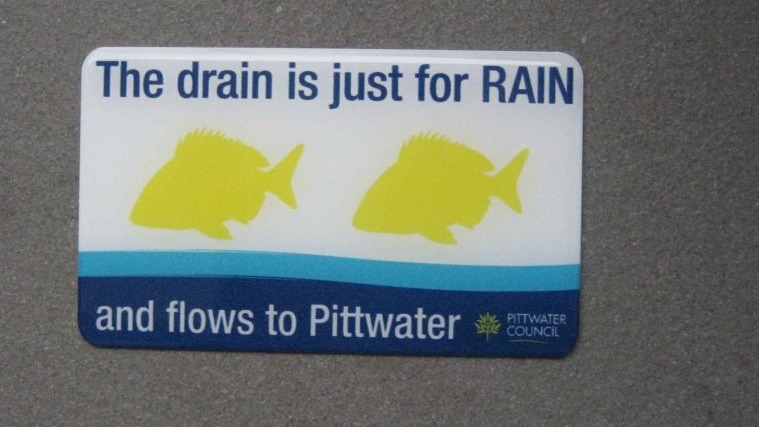
More Waterways Pollution: Narrabeen Lagoon
Oily slick coming out of the stormwater drain (opposite the Nourished Cafe) and emptying into the Lake Narrabeen entrance which at the time was running back into the lagoon with high tide - May 19, 2023, 8.00am. Photos supplied.
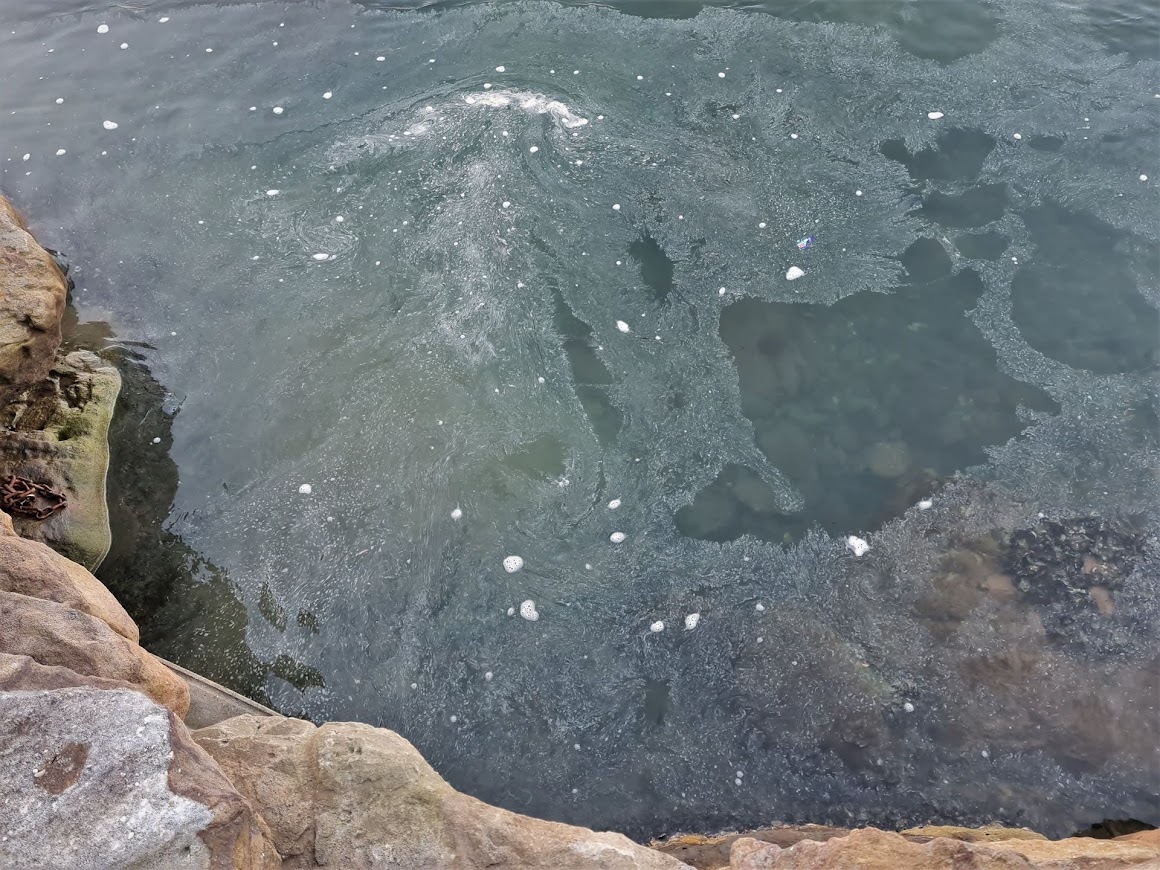
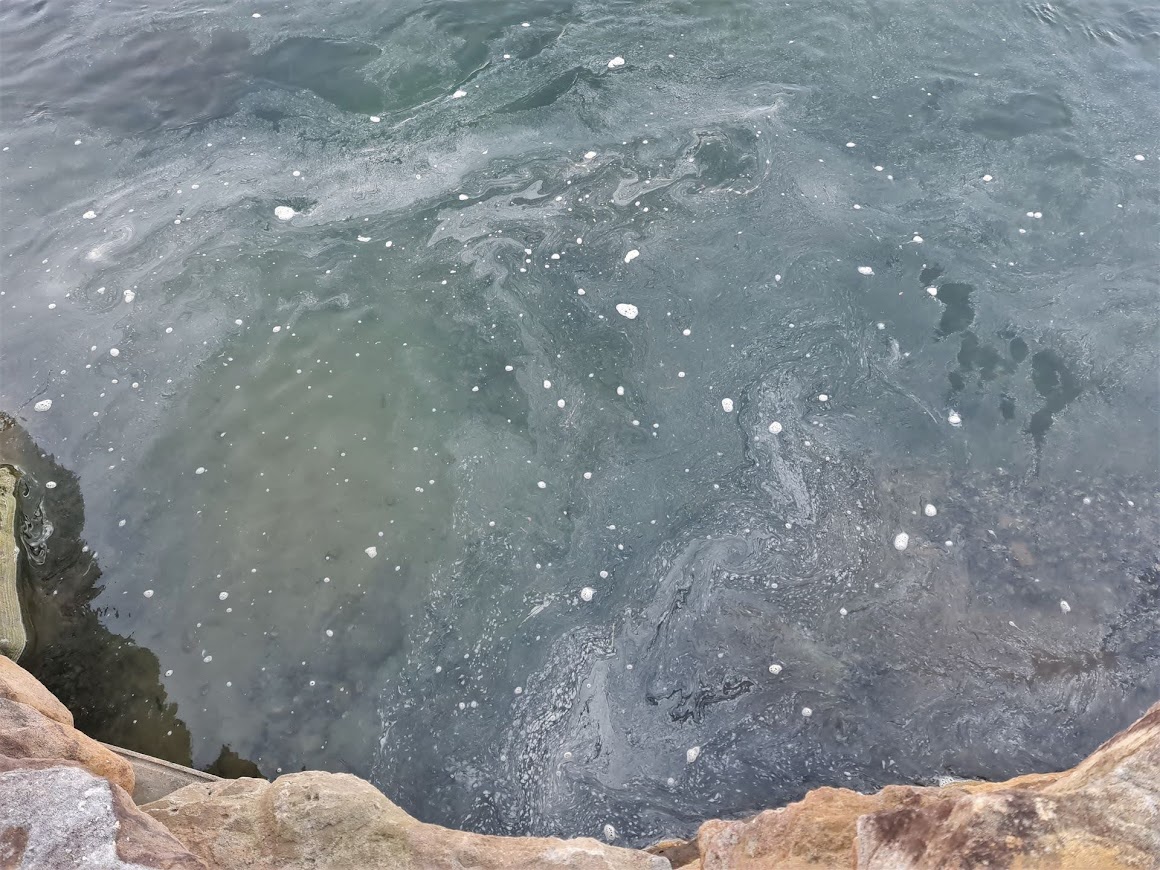
Yet More waterways pollution - in this Issue's report: Clay Stormwater Still Polluting Bayview Golf Course, Pittwater Estuary: Bayview GC's 3 Year Battle To Save The Environment and Waterways 'Like Banging Your Head Against A Brick Wall'
Previously:
Hawkesbury Councillors Battling Own Councillors To Save Koala Habitat: Rural Boundary Clearing Code
In October 2021 Hawkesbury Councillors tried to, as one Councillor states ''ram through the adoption of the "Rural Boundary Clearing Code", which would allow the clear-felling of up to 15,800 hectares of rural land where landowners assert such clearing is needed to improve fire safety.
The Rural Boundary Clearing Code, introduced by the NSW Government on Saturday September 11 2021, allowed rural landholders to clear vegetation on their property within 25 metres of the boundary to reduce the potential spread of bushfires without the need to seek approval.
Widely stated by opponents as a means for developers to clear land previously requiring approvals, neither the NSW Bushfire Inquiry nor the Royal Commission recommended land clearing on property boundaries as a valid response to the Black Summer fires.
The Nature Conservation Council wrote to key ministers detailing minimum environmental standards any new code must meet, especially excluding areas of koala and other threatened species habitat.
“The code could mean the difference between survival and extinction for koalas and other threatened species in some parts of the state, so it was vital that the government got this right,” Mr Gambian said.
Similarly the EDO stated:
The NSW Government stated that these new provisions and the Code respond to Recommendation 28 of the NSW Bushfire Inquiry which recommended the Government …“review vegetation clearing policies to ensure that the processes are clear and easy to navigate for the community, and that they enable appropriate bush fire risk management by individual landowners without undue cost or complexity”.
The Rural Boundary Clearing Code allows landowners to clear certain vegetation on their property within 25 metres of their property boundary (i.e. the boundary of a single holding, including holdings made up of multiple lots), without a permit or approval, if undertaken in accordance with the Code. The Rural Boundary Clearing Code does not provide approval but rather a person is not guilty of an offence for clearing vegetation in accordance with the Code. The Rural Boundary Clearing Code overrides environmental assessment and approval requirements in the Biodiversity Conservation Act 2016 and the Environmental Planning and Assessment Act 1979.
The NSW Bushfire Inquiry did not explicitly recommend code-based clearing of vegetation within 25m of rural boundaries.
When the changes were first proposed, EDO raised concerns that “the proposed code will facilitate clearing of vegetation without the need for robust environmental assessment or approval and without a clear framework for monitoring and oversight, in some cases overriding existing environmental protections.”
Conservation scientists expressed concern that the new Code will have a devastating impact on wildlife.
With no clear obligations to monitor or report on clearing under the Rural Boundary Clearing Code, it was unclear how the implementation of the Code, including its cumulative impacts on important landscapes and wildlife in terms of both local impacts and impacts on connectivity and corridors, or its role in providing increased protections from bushfires, would be assessed.
The following are key elements of the Rural Boundary Clearing Code:
- The Code applies to land within a rural zone (RU1, RU2, RU3, RU4, RU5, RU6) identified on the Boundary Clearing Code Vegetation Map. However, the Code does not apply in certain Sydney local government areas, unless the Council requests to have the Code apply to their local government area. Certain exclusions and restrictions also apply (see below).
- Any clearing must be undertaken in accordance with the Rural Boundary Clearing Code, on the day that the clearing is undertaken. Landholders must use the online Rural Boundary Clearing Tool to conduct a search of their property (to determine how the Code applies) and maintain search results from the day that the clearing is undertaken. Landowners are required to provide evidence of the online search tool results if requested by the relevant regulatory authority.
- Part 6 of the Rural Boundary Clearing Code contains exclusions and restrictions on vegetation clearing, for example:
- Three categories of vegetation cannot be cleared (6.2(1)), namely:
- Parcels containing specific vegetation, including (but not limited to) coastal wetlands, littoral rainforests, core koala habitat, areas of outstanding biodiversity value, vegetation within 100 metres of the coastline or estuaries, and critically endangered ecological communities. (Note – certain temporary exemptions exist areas impacted by the 2019-2020 bushfires)
- World Heritage; and vegetation of high environmental significance identified as part of the bio-certification of the Sydney Region Growth Centres (6.2(2))
- Mangroves and saltmarsh (6.2(3)).
The broader context
The new Rural Boundary Clearing Code and changes to the Vegetation in Non-Rural Areas SEPP have been made despite ongoing criticism of the government’s broader land management and biodiversity conservation framework, which has resulted in a return to broadscale land clearing across the State and put biodiversity at further risk. In particular, independent reports by the NSW Audit Office and the NSW Natural Resources Commission have highlighted the failings of the system.
The Government failed to publicly undertake a three-year review of the land management and biodiversity and conservation framework – something it promised to do when it introduced the current framework over four years ago.
It has also failed to effectively resolve tensions around koala planning policies, which has seen important koala habitat put at risk.
And these failings must now also be considered in the context of a changed landscape following the catastrophic 2019-2020 bushfire season. In NSW, bushfires burnt over 5.52 million hectares of land. The fire ground in NSW covered approximately 7% of the state, including 2.7 million hectares in national parks (37% of the NSW park system), and that the habitat of more than 293 threatened animals and 680 threatened plants has been impacted.
The current framework has been shown time and again to be flawed, yet rather than wholescale reform aimed at strengthening protections for our valuable native vegetation, the Government continues to introduce incremental, ad hoc changes to further facilitate land clearing without appropriate levels of environmental assessment and oversight, meaning the phrase ‘death by a thousand cuts’ may soon no longer be metaphorical.' the EDO stated
Although that October 2021 Hawkesbury Council bid failed, it was pushed through at the January 25 2022 Meeting with then Liberal Mayor Patrick Conolly using his vote to pass the adoption of the same and break a deadlock of Councillor votes.
Hawkesbury Council is the only peri-urban council in NSW to opt into the Code and was also the first action the now Liberal dominated council took after being elected.
''I think that Council has a moral obligation to look at this area, given the loss of 65 homes in the Hawkesbury in the fires. But balancing community safety with protection of the environment is challenging. It takes leadership, and nuancing the various issues and views, not ramming something through without consideration of the consequences.'' Councillor Nathan Zamprogno of the Small Business Party said
''Firstly, we had conducted zero formal consultation with our local RFS.
Secondly, it was clear that we needed to resource Council to measure the effects of this policy with geospatial mapping tools, provide guidance to landowners about the torturous eligibility criteria, and ensure we could conduct basic compliance and enforcement. We had no knowledge of a single other Council taking up the voluntary adoption of this code and what that experience looked like for them, and many local experts told me that they were either opposed, or took a "yes, but" approach contingent on these basic precautions.
I advanced an alternative motion to get Council to conduct that consultation and resourcing, and I got it passed. The report would have come back to Council this year.
However, the complexion of the Council chamber has changed, and on Tuesday my Liberal colleagues again tried to ram summary adoption of the code through. This time, they had the numbers.
So that's it. No consultation. No resourcing for partnering with landowners. No resources for mapping, compliance or enforcement. Oh, and no takebacks. Once we're in, we're in for good.''
I think of this as a massive slap in the face for our local RFS, who are free to be for or against this, but who would have at least been accorded the courtesy of being *asked*. So much for the oft-claimed respect for our RFS. I've always claimed that it's possible to be a good Conservative, and a good Conservationist. It's a pity that this looks nothing like that. Environmentally conscious voters in the Hawkesbury, and if I might suggest, across the seat of Macquarie ought to keep their own counsel about whether this looks like the kind of representation they want.'' Independent Councillor Nathan Zamprogno said then
Koala's in NSW were officially added to the endangered species list on February 12th 2022.
The decision by the local Liberal Council to opt into the Rural Boundary Clearing Code without consultation or proper mapping of koala habitat in advance would have horrific consequences, residents stated. Many expected vast tracts of land-clearing. Much of that will occur in areas which have been land-banked by property developers. This could occur in areas and of trees used by koalas so that when development proposals were forwarded this would nullify any requirement to ascetain if any were there as their habitat would already have been cleared.
''This will strengthen the Liberal Government’s plans to transform the Hawkesbury from a semi-rural community into large scale housing estates.'' Haweksbury residents have stated
‘Supporting this is farcical, it is very, very distressing and one would have to wonder of the motivations behind it,” Councillor Mary Lyons-Buckett told council.
On February 17 2022 a Motion to Rescind the January adoption of the Rural Boundary Clearing Code was put by Councillor Danielle Wheeler (GRN) and seconded by Cr. Mary Lyons-Buckett (IND) with once again a deadlock in voting with Liberal Mayor Conolly again using the Mayoral casting vote to vote against the motion.
For the May 9 2023 Hawkesbury Council Meeting Councillor Mary Lyons-Buckett requested the Motion be heard as an Urgency Motion in relation to the Rural Boundary Clearing Code due to the clearing of habitat and the mapping of koala populations (which has not occurred here).
Due to that Council now holding only one meeting per month (the June meeting not until 13 June 2023), and the Mayor disallowing it to be heard as an Urgency Motion at the previous meeting, ruling it was 'not of great urgency', Independent Councillor Mary Lyons-Buckett and Greens Councillor Danielle Wheeler called for an Extraordinary Meeting.
They called the Extraordinary Meeting due to residents raising concerns about developers using the Rural Boundary Clearing Code to clear sites for development.
On Wednesday May 17 2023 a Motion was brought to look at whether the land-clearing policy introduced 18 months ago has resulted in excessive felling of wildlife habitats including for Koalas.
Councillor Nathan Zamprogno stated, ''Disappointingly, some Councillors not only rejected the initiative, but moved to gag debate and prevent their colleagues from representing their community. This is what you need to know about what happened. '' and posted the below video.
Mayor Sarah McMahon (Richards) sent an apology and did not attend the May 17 Extraordinary Meeting.
Councillor Mary Lyons-Buckett posted on her Fascebook page;
In February and March 2023 Mayor Sarah McMahon (Richards), a Vice President of the Liberal Party of Australia (NSW Division), was one of 4 Hawkesbury Councillor who recused themselves from the vote on whether the Council would endorse the amendment of its Local Environmental Plan to allow a site-specific legalising of a property subdivision for the Tallowood 2 Seniors Community in Vincents Road Kurrajong. The changes sought would substantially alter the planned Tallowood 2 development from a 13 acre senior living facility to a 19 lot subdivision of sellable plots, no less than 360 metres squared.''Thank you to the speakers who spoke tonight and raised really good points.
I don't usually post after meetings but I found tonight's meeting particularly disappointing. We have an outcome but not the one Councillor Danielle Wheeler and I hoped for to begin a process addressing a growing threat to our native habitat and threatened and endangered species through land clearing.
There was no real argument against why we wouldn't begin a process to try and address the anomalies arising from the Rural Boundary Clearing Code. Resistance, but no real argument.
In a boldly orchestrated and coordinated approach to 'debate' we saw the call for the motion to be 'put', seeing Councillor Nathan Zamprogno excluded from debate. One Councillor bemoaned having to attend (despite he and 2 other Councillors present tonight not attending last night's briefing) because he considered threats to the environment as non-urgent.
This was an Extraordinary Meeting, the urgency motion having failed to be heard at the previous meeting. Any two Councillors can call one anytime about any topic. This was an incredibly important topic.
A majority of Councillors (the Liberal and Labor Councillors) did not support writing to the Environment Minister about the review into this code. There is very little understood about this code and how it impacts an area such as ours.
Gathering data around where the Code may have been implemented out of alignment with its objectives is important. Improving our practices in dealing as a Council with vegetation removal - also not supported, but also very important. It is noteworthy that as the only peri-urban Council to opt in, we may have specific experiences with the Code which other Councils may not have experienced.
I express my disappointment in Labor Councillors not supporting this motion - it's a bold move given their party now in Government is trying to claim to have a superior approach to environmental issues compared to the last one. Let's hope at a State level they show more concern.''
The changes were sought after a Land and Environment Court Decision would allow the development to proceed as long as there was no subdivision of the site. The developer(s?) behind Tallowwood 2 in Kurrajong wanted to change that court ruling prohibiting the subdivision of the land which has been approved for a seniors living facility. The multi-million dollar, 19 dwelling development had been approved on the existing D.A but obviously it will be far more profitable for the developer if the land is also subdivided.
The Mayor, Sarah McMahon recused herself from the vote citing a pecuniary interest, stating the ‘landowner’ is a relative of her partner Matthew Bennett - in fact his mother Pamela. A pecuniary interest is one in which there is a “reasonable likelihood or expectation of appreciation financial gain or loss to the person.”
Mayor McMahon (Richards) has steadfastly denied being a property developer by her association with Matthew, who himself has denied being a property developer. Mayor McMahon (Richards) was the subject of an Inquiry in 2022 after it was declared in the NSW Parliament that she falsely claimed on her Declaration prior to the 2021 Local Government elections that she was not a developer nor associated with one.
Her partner, Matthew Bennett, co-owns BCM Property Group, which was, at the time of the electoral declaration, advertised as “BCM Real Estate and Development” and offered “End to End Property Development Services”.
The website previously stated Mr Bennett “has been in real estate and property developing his entire life. From selling villas to commercial properties and development sites worth up to $900m, he has over 25 years experience in every aspect of property development and sales.”
The company is named under its previous guise of Bennett Cooney Mackman Real Estate on past development applications, but Cr. Richards (McMahon) said Mr Bennett was a real estate agent who consulted with land owners about what to do with their land. The business’s website states BCM is “not a property development company”.
A spokesman for the NSW branch of the Liberal Party told the Sydney Morning Herald that Mr Bennett’s commercial activities didn’t reach the threshold under state electoral law to qualify him as a property developer.
“The NSW Electoral Funding Act has a specific definition of a property developer, and this does not meet that definition,” the spokesman said. “Ms Richards’ declaration is also therefore correct and accurate.”
The Office of Local Government also determined that Matthew Bennett did not meet the legislative definition of a property developer. The OLG has also confirmed Sarah Richards did not breach the code of conduct that applies to councillors.
Former Liberal Mayor Patrick Connolly also recused himself from the vote citing, “owner is the relative of a close friend”. Councillors Mary-Lyons Buckett and Paul Veigel also recused themselves from the vote citing non-pecuniary interests.
Councillors who voted against the motion questioned how the subdivision would benefit the community and why the controversial plans were being rushed through.
“What has been suggested to us tonight is that we have to bend or break our own rules to make this legal and its perfectly sensible for us to say well, right sometimes we do amend our LEP but there has to be a jolly good reason and I haven’t been presented with that reason here,” Councillor Nathan Zamprogno said.
The amendment to the D.A. is also being challenged by those who live in Tallowood 1 who state they had not agreed for the developer to use their site to further their development. “For this application to be granted the Applicant would need the consent of the owners and members of Lot 1 being the ‘Tallowood’ Community Association’. It is understood that the Applicant advised the said Council meeting that the owners and members of ‘Tallowwood 1’ had agreed to the use of Lot 1 for the purpose of the application and development. There is no truth to this statement,” Lawyer acting for Tallowwood 1 residents, Herbert Weller said in a letter sent to Hawkesbury Council.
Despite these concerns Council – in a split vote - voted to support the next stage of the approval process which will likely rubber stamp the subdivision to proceed at its February Meeting.
The next day trees were being felled on the Tallowwood 2 site even though the project has yet to receive final approval from the NSW Department of Planning, some state using the Rural Boundary Clearing Code - and another of at least 3 instances being cited by the community for developments not yet approved.
“Council resolved to support the request for the zoning variation. There is no foundation for this support as the owners and members of the Association will not give consent for the use of Lot 1,” the letter from lawyer Herbert Weller reads.
“…It is also noted that the owners of Lot 6 have today removed numerous large trees on lot 6 without Council having issued (sic). Please investigate this urgently before further destruction of habitat takes place,” Mr Weller said.
While not in itself providing a green light for similar future subdivisions of this kind in the area the special treatment given to this development is likely to set a precedent for future development and will not discourage using the RFS code for clearing land prior to submitting a D.A.
Cr McMahon and Mr. Bennett had also featured in a Parliamentary statement by Blue Mountains Labor MP Trish Doyle who said on August 21 2019 the Independent Commission Against Corruption (ICAC) should investigate Matthew Bennett and the former federal election candidate for Macquarie in relation to the other property dealings through that council, among other items.
Hawkesbury residents have stated, since that May 17 2023 Extraordinary Meeting to try and redress what is happening:
''The adoption of the code was pure corruption. I have 10 years of Koala records totalling over 100 records in the Kurrajong Hills area. Looking at the location of each record, I believe around 90% of the trees these Koalas were recorded using would be eligible for removal under this rotten code, which was not recommended by the RFS for adoption by the Liberal-run Hawkesbury Council. Corruption is the key here.''
And:
''All it would take is for a speaker on the item to mention the main reason for concern is the clearing of trees on 2 properties ..... has direct links with - the Kurrajong Bark Park and a property at Bowen Mountain. Both are being cleared under the pretence of the Rural Boundary Clearing Code, but the mention of those properties would constitute a clear conflict of interest and she should declare such and leave the meeting and debate. It would also require Conolly and Sheather to do the same given their close association with the non-developer.''
Councillor Sheaher has been referred to in this manner as during the 2021 local government elections he made statements to the media that Mr. Bennett and Ms McMahon (Richards) are 'good friends [of his] and had been for many years'.
And:
''I can not believe that in 2023, we still have to fight to stop land clearing to save habitats, let alone critical habitat for endangered Koalas that have a real possibility of extinction in the future.''
And:
''I find the whole thing so upsetting. Greed above all else. The Motion two years ago was a complete farce. Honestly, it wouldn't have mattered who the speakers were, those with an agenda knew they had the numbers and arrogantly ignored all educated submissions. Despite experts from RFS and WIRES with input from Science for Wildlife, and despite Council confirming they had no way to police breaches, Liberal councillors went ahead with their agenda. From memory, one of their speakers even admitted during questions that boundary clearing had nothing to do with fire safety for him, and he just wanted to get his mower access along his fence line, before the mayor counselled him to stop answering the question and cut the councillor questioning off. It was a revolting display from those councillors.''
The types of vegetation that cannot be removed under the Rural Boundary Clearing Code include:
1. Parcels of the following vegetation which are within areas mapped in the Rural Boundary Clearing online tool may not be cleared under the Rural Boundary Clearing Code. The onus is on the owner or occupier of the land to demonstrate that they did not clear any vegetation that constitutes any of the following types of vegetation:
a. SEPP Coastal Management - CoastalWetlands (not including the proximity area) as mapped and provided to the NSW RFS by the Department ofPlanning, Industry and Environment;
b. Wetlands in the Sydney Regional Environmental Plan (Sydney Harbour Catchment) 2005 as mapped and provided to the NSW RFS by the Department of Planning, Industry and Environment;
c. Wetlands in the Sydney Regional Environmental Plan 20 – Hawkesbury Nepean River (No 2 –1997) as mapped and provided to the NSW RFS by the Department of Planning, Industry and Environment;
d. SEPP Coastal Management – Littoral Rainforests (not including the proximity area) as mapped and provided to the NSW RFS by the Department of Planning, Industry and Environment,
e. Core Koala habitat identified at Attachment ‘A’ as mapped and provided to the NSW RFS by the Department of Planning, Industry and Environment;
f. Ramsar Wetlands;
g. vegetation within 100 metres of the coastline or estuaries of NSW;
h. any vegetation on Lord Howe Island;
i. Land mapped as Declared Area of Outstanding Biodiversity Value (as listed in Attachment A – Vegetation Types) as mapped and provided to the NSW RFS by the Department of Planning, Industry and Environment;
j. Critically Endangered Ecological Communities (as listed in Attachment A – Vegetation Types) as mapped and provided to the NSW RFS by the Department of Planning, Industry and Environment;
k. ‘Land avoided for strategic biodiversity’ and ‘strategic conservation area’ (as listed in Attachment A – Vegetation Types), whether exhibited as part of the draft Cumberland Plain Conservation Plan (CPCP) or the approved CPCP, and as mapped and provided by the Department of Planning, Industry and Environment.
2. Vegetation on land parcels (cadastre lots) which are within areas mapped in the Rural Boundary Clearing online tool as identified below are excluded from the Rural Boundary Clearing Code and may not be cleared.
The protected categories are:
a. World Heritage as mapped and provided to the NSW RFS by the Department of Planning, Industry and Environment,
b. Vegetation of high environmental significance identified as part of the bio-certification of the Sydney Region Growth Centres as mapped and provided to the NSW RFS by the Department of Planning, Industry and Environment.
However, after this Extraordinary Meeting Items 3 and 4 were Carried and now Hawkesbury Council at least have some means of commencing what it was stated they would do 14 months ago - e.g.; map koala populations in the LGA. The rest of the items were voted down, including aligning the Rural Boundary Clearing Code to align with bushfire risk and removing that council from the Rural Boundary Clearing Code.
So all wildlife in this LGA is still at the mercy of those using this Code to further their ends.
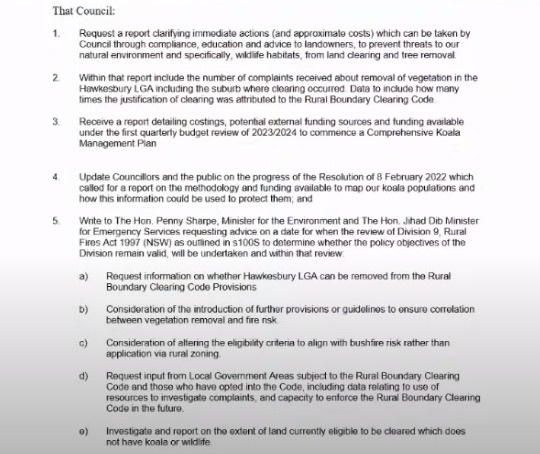
Screenshot of finalised Motion from Hawkesbury council YOUTUBE video of Public Meeting for same.
Hawkesbury Council currently has a 'Have Your Say' for residents on its Draft Environmental Sustainability Strategy, which is on public exhibition to Tuesday, 13 June 2023.
The webpage for the same states;
'The Draft Environmental Sustainability Strategy is overarching umbrella document identifying how Council will protect, maintain, and enhance the sustainability within the local area whilst also preparing for the projected impacts of climate change.
The Strategy incorporates the actions Council is currently undertaking to improve the sustainability of the area, and identifies the gaps and priorities.
As a long-term guiding document that aims to work across different departments, agencies and with the community, the strategic directions are high-level and holistic.'
The current Hawkesbury Council, elected in 2021, in order of election, is:
Councillor Party Notes
Nathan Zamprogno Independent Elected Liberal in the 2016–2021 term, now independent
Sarah McMahon Liberal Mayor 2022–date - first elected in 2016
Mary Lyons-Buckett Independent Mayor 2018–2020, Deputy Mayor 2016–2018
Barry Calvert Labor Deputy Mayor 2018–date, Mayor 2016–2018, Deputy Mayor 2022–date
Patrick Conolly Liberal Mayor 2020–2022
Paul Veigel Liberal
Jill Reardon Liberal
Danielle Wheeler Greens
Les Sheather Independent
Eddie Dogramaci The Small Business Party
Amanda Kotlash Labor
Shane Djuric Shooters, Fishers and Farmers Party
The previous Council, elected in 2016, went for a term of five years owing to the COVID emergency. On its creation in 1981, Hawkesbury was largely rural, but urban expansion within Sydney has since transformed the southern part of the area into dormitory suburbs. The northern part of the local government area still contains some farmlands and national parkland.
Council Victory In Court Over Illegal Clearing Of Trees = 10k For 14 Killed Trees: 'A Poor Outcome' Residents State
In related news, Council announced this week it had had a victory in court over the illegal clearing of 14 trees by a developer.
The developer has been convicted by Manly Local Court for the illegal removal of 14 trees. Appearing before Magistrate Denes on 9 May, the defendant pleaded guilty to illegally removing the trees which were required to be retained and protected by a development consent. The defendant was convicted by Manly Court and was ordered to pay a fine of $10,000 plus professional legal costs.
In the judgment, Court found that the removal of 14 trees in contravention of the development consent constituted a serious breach.
Council was first alerted to the issue in September 2021 after receiving a complaint about the removal of a tree at a construction site in North Narrabeen.
On inspection, Council found that 14 trees had been removed in contravention of a development consent.
Northern Beaches Council Interim CEO Louise Kerr said the case served as an important reminder of the need to comply with development consents.
“Northern Beaches Council is committed to protecting and maintaining trees and bushland, especially threatened species and trees with heritage significance,” Ms Kerr said. “Council has zero tolerance to these types of offences and takes these matters seriously.
“While these 14 trees have sadly been removed, we hope that this will serve as an important reminder to others in the community to comply with conditions of their development consent and not remove trees without Council permission.”
However, residents have pointed out that this is less than $1000.00 per irreplaceable tree and fines and deterrents should be much more to disincentivise the practice.
Further, residents state Council needs to have 'more boots on the ground' to ensure DA's are being complied with and to revert to a system where Private Certifiers cannot tick off compliance that allows developers to tear down habitat or allow developers to take over public land adjacent to a development by planting it out.
One stated: ''It’s all too late after they have been removed or public land taken. Fines are peanuts next to what they gain after the removal or after they have planted out what is and was a passageway so others may not use it. Another now common practice where Council refers us to the Private Certifiers who do not even bother to answer you.''
Another resident has commented that developers who clear trees illegally should have the maximum penalty applied as a deterrent and that this is a very poor outcome.
Further comments made similar statements.
In November 2018 residents reported the illegal clearing of Sclerophyll Forest At Warriewood, with statements from Council that they would investigate.
Nothing has been heard since.
Under the Native Vegetation Act 2003, if you removed a native tree illegally in NSW you could be liable for a fine of up to $1.1 million if prosecuted. The Native Vegetation Act 2003 and the Native Vegetation Regulation 2013 were repealed on August 25th, 2017. Current legislation governing the clearing of native vegetation is the Local Land Services Act 2013 and the Biodiversity Conservation Act 2016.
Under the Biodiversity Conservation Act 2016, a 'Dedicated Conservation Zone' definition does not exist. There is Damaging habitat of threatened species or ecological community under which the Maximum penalty is a Tier 1 monetary penalty or imprisonment for 2 years, or both.
The maximum monetary penalty for Tier 1 is:
(a) in the case of a corporation:
(i) $1,650,000, and
(ii) if this Act provides that an additional daily penalty applies to the offence—a further $165,000 for each day the offence continues, and
(iii) if this Act provides that an additional penalty for each animal or plant applies to the offence—a further $165,000 for each animal or whole plant to which the offence relates, or
(b) in the case of an individual:
(i) $330,000, and
(ii) if this Act provides that an additional daily penalty applies to the offence—a further $33,000 for each day the offence continues, and
(iii) if this Act provides that an additional penalty for each animal or plant applies to the offence—a further $33,000 for each animal or whole plant to which the offence relates.
Council also have a webpage where you may report Illegal tree works. If the matter is urgent (e.g. happening right in front of you) you can call them.
At the March 2023 Council Meeting Cr.s Korzy and Glanville tabled a Motion, 'BUILDING AND DEVELOPMENT COMPLIANCE', which was unanimously passed, to try and address the non-compliance that is rampant across the LGA where thousands of D.A.'s are approved each year without enough officers to ensure compliance with the Conditions of Consent is occurring - instances of residents contacting Council and being told to take it up with Private Certifiers are growing, along with the abovementioned taking over of public lands and pathways, as well as trees and lower level habitat being cleared - sometimes before a D.A. is even submitted.
That Motion stated:
That:
1. Council note:
A. The leadership role Council plays in fostering a strong compliance culture within the community with regards to compliance with building and development controls.
B. Resourcing of compliance staff dealing with development and building control, and other areas of compliance, are being prioritised for review through the ongoing service levels review being undertaken by Council staff.
C. Council’s Compliance and Enforcement Policy is being currently reviewed by staff, and draft amendments for exhibition will be reported to the May 2023 council meeting.
2. The Chief Executive Officer prepare a report to Council at the May 2023 meeting concerning the following points regarding the private certification scheme:
A. Any issues identified by staff or residents regarding the efficacy of this scheme
B. Any recommendations for improving state legislation dealing with oversight of development and compliance
C. Prepare a letter to the NSW Government, Shadow Planning Spokesperson, Department of Fair Trading, Office of Local Government, and Local Government NSW, highlighting the matters identified in A - B.
3. The Chief Executive Officer prepare a workshop by May 2023 for the Councillors concerning any innovative ideas for improving compliance by the community with building and development regulations. This could include, for example:
A. Proactive and random inspections of building sites
B. Joint inspection ‘blitzes’ with co-regulators such as the NSW EPA
C. Use of new technology to identify illegal development such as clearing of trees
D. Education campaigns to improve a culture of compliance.
4. The Chief Executive Officer report back to Council at the May 2023 meeting with options for resourcing a specialised compliance team responsible for dealing with allegations of unauthorised tree or vegetation clearing.
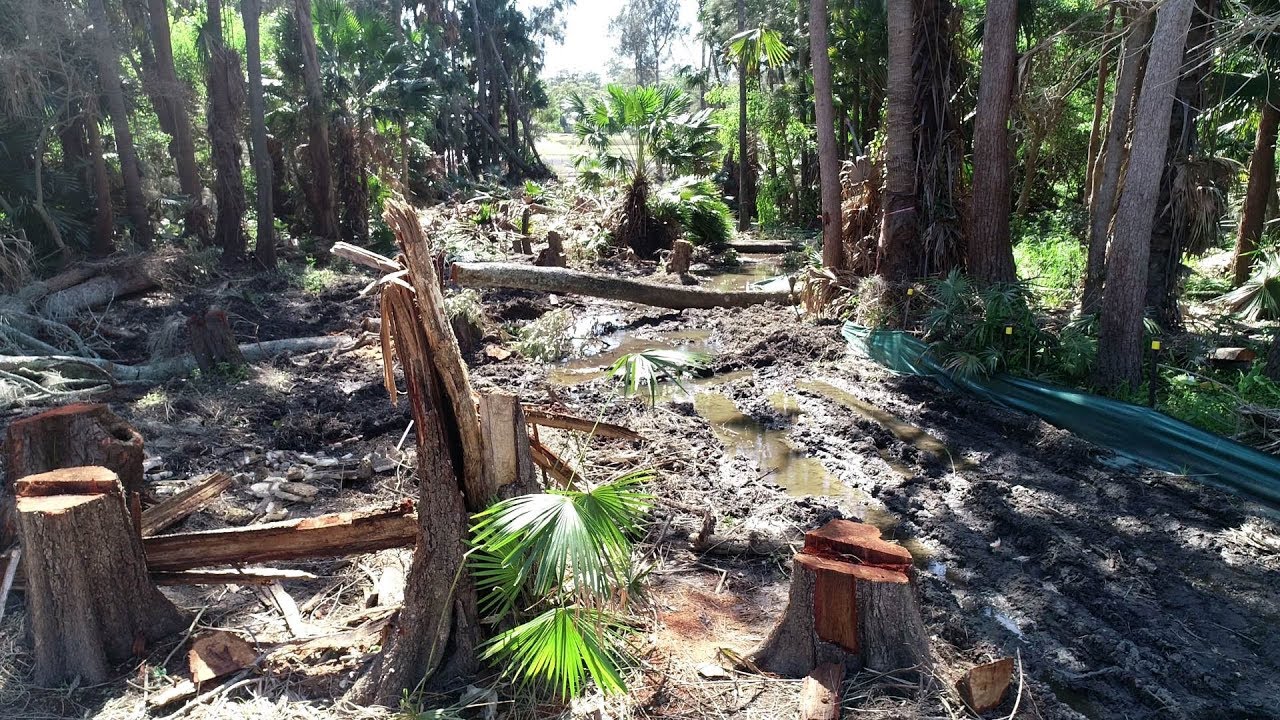
International World Turtle Day 2023
American Tortoise Rescue (ATR), a nonprofit organisation established in 1990 for the protection of all species of turtles and tortoises, “shellebrates®” its 23rd international World Turtle Day® on May 23 2023.
ATR created and launched WorldTurtleDay.org to increase respect for and knowledge about one of the world’s oldest creatures. Now observed around the globe, turtle and tortoise lovers show their appreciation of the special day by taking “shellfies” and “shellebrating” with events and shares on social media. Millions of turtle lovers in the U.S., Canada, the UK, Borneo, India, Australia, Greece and many other countries worldwide now observe the day with thousands of educational events, parties, fundraisers and more.
Susan Tellem, RN, BSN, executive director, co-founded the ATR sanctuary 33 years ago with her husband, Marshall Thompson. Together, they have rescued and rehomed thousands of turtles and tortoises and provided turtle education to turtle lovers worldwide.
“We want to have fun with World Turtle Day and make it appealing to all ages,” Tellem said. “This year’s ‘I Love Turtles’ theme features handsome turtle Mr. Mudd (featured) and encourages our worldwide audience to see turtles as amazing creatures who outlived the dinosaurs just to make us laugh and love them as much as people do with warm and fuzzy cats and dogs. They are more than just rocks with legs!”
Tellem says these sentient beings are amazing creatures that live 25, 50, 100 years or more. They feel happiness and pain, show a true sense of humor, as well as affection. Turtles have personalities just like dogs and cats. “When they are allowed to live wild in a safe environment, turtles and tortoises search for food, do funny things like walking backwards or honking, and most important, have relationships with other turtles, sometimes procreating.
Sadly, these gentle animals survived 200 million years after an asteroid destroyed most life on the planet, yet they are rapidly disappearing as a result of smuggling, habitat destruction, the cruel pet trade, and live exotic food markets domestically and internationally. About 61 percent of turtles worldwide are threatened or already extinct. According to experts, turtles are the most threatened of the major groups of vertebrates, more so than birds, mammals, and fish. Tellem says this is why education is so important in every country globally.
In Pittwater, on the ocean side and within the estuary itself, fishing lines and balloons, boat strikes and shark nets cause fatalities. Our area has the vulnerable green turtle (Chelonia mydas) and the endangered loggerhead turtle (Caretta caretta) and the Leatherback turtle (Dermochelys coriacea) as residents and visitors.
Ella: Green Turtle Rescued From Manly; Ella was discovered at Shelly Beach in Manly looking extremely unwell and was rescued by Australian Seabird Rescue Central Coast on April 18th, 2020. The rescue at Shelley Beach was by ASRCC volunteers Silke and Paul who brought this sick turtle in for care after a photo was seen on a diving page.
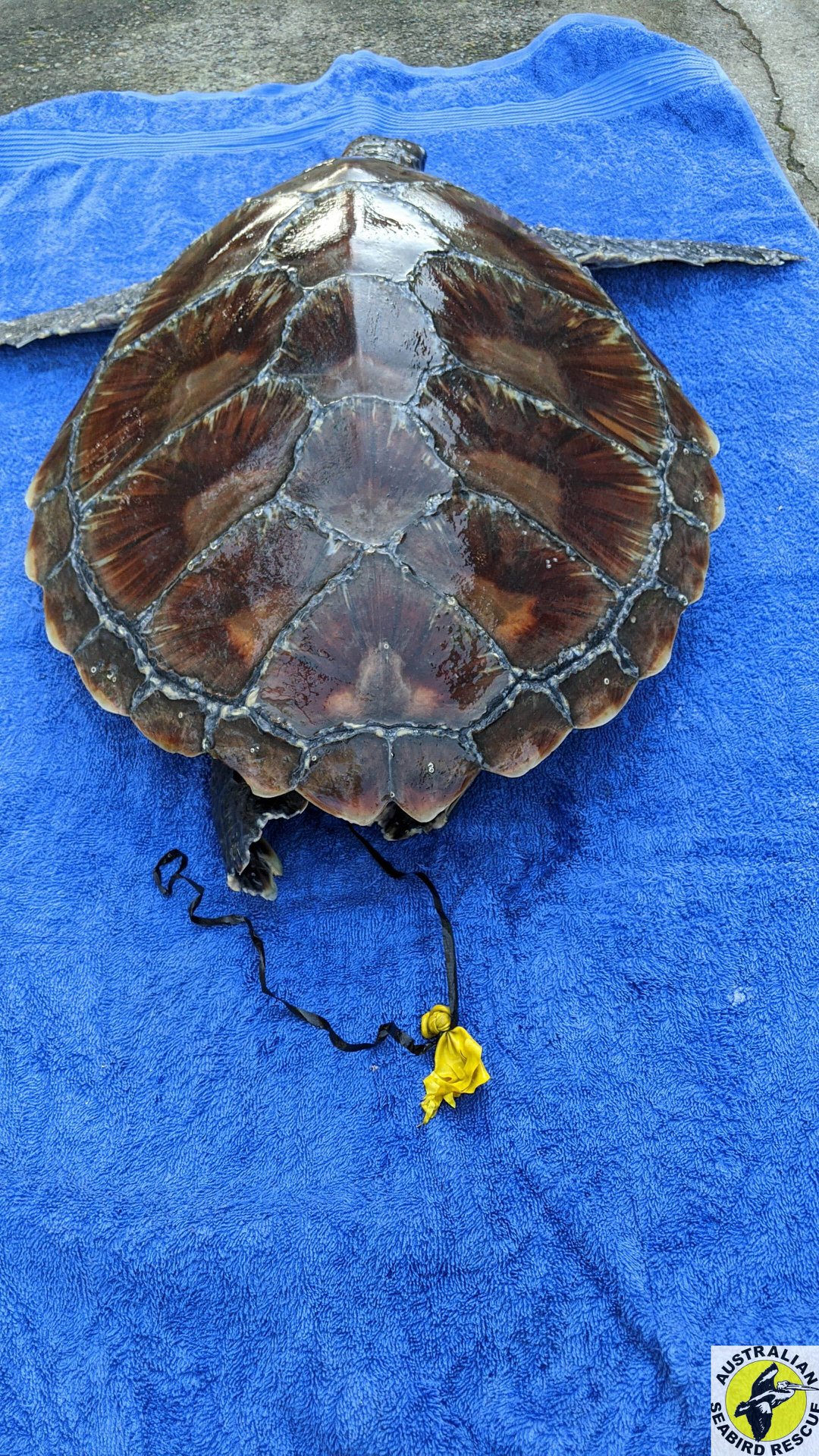
Ella was examined and it was discovered that she is suffering from a severe case of pneumonia and septicaemia. She was placed in care with Australian Seabird Rescue where it was found a balloon and attached streamers were the problem. Ella is lucky to actually still be alive - imagine being only 47cm long and having a balloon with 2.5mtrs of streamer attached but also a plastic bag in your stomach! Ella excreted the plastic bag on April 28th, while the balloon and tie attached was passed on April 25th.
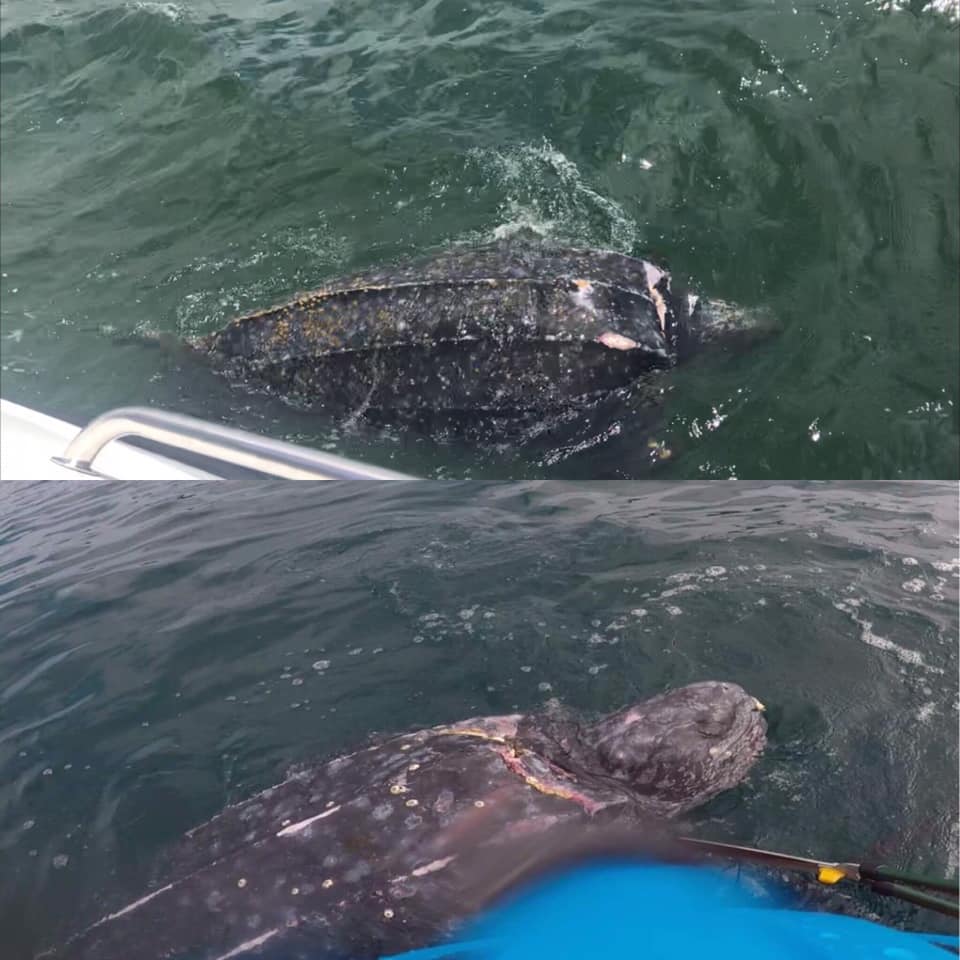
Leatherback Turtle saved by Newport SLSC members from shark net entanglement
On land Warriewood wetlands is the home to the eastern long-necked turtle, Chelodina longicollis (Family Chelidae), which will cross local roads during breeding times to find a mate.Adult turtles are protected by their shells from most natural predators when they are in the water, but when they venture onto land they can be killed by dogs, foxes or pigs, or crushed by motor vehicles. Chelodina longicollis can also be washed out onto our beaches during storm events, which is why it is best to contact wildlife carers if you find a turtle on the beach as it may be a freshwater turtle - either way, don't put it back into the water. A turtle found on a beach may well need help.
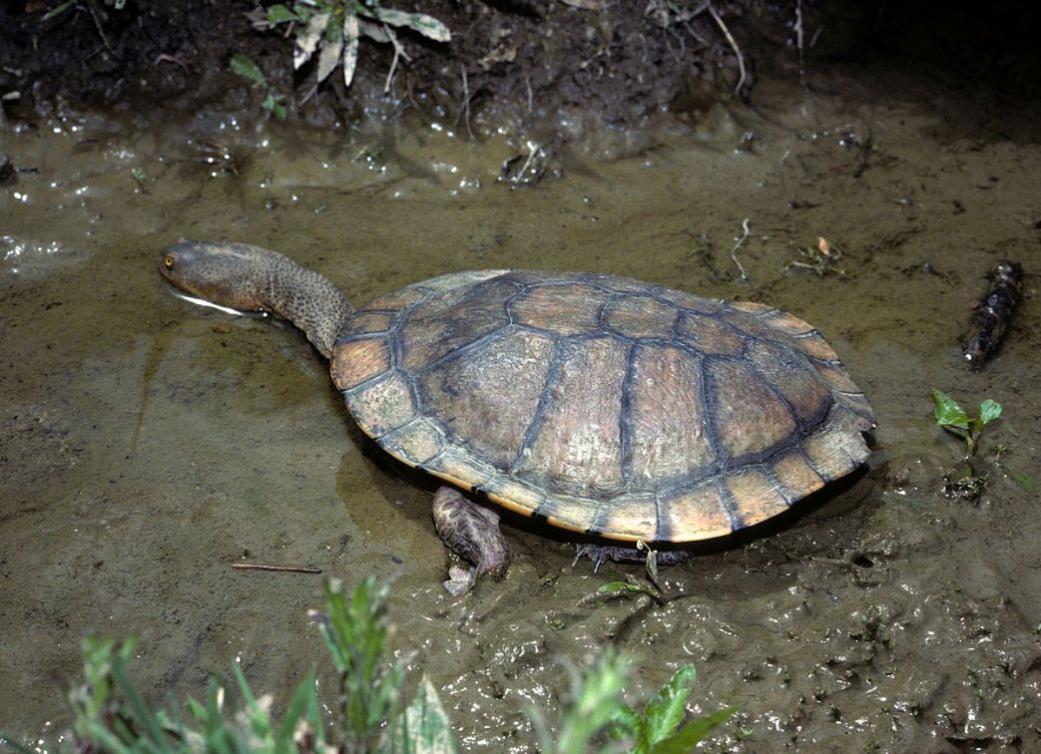
Eastern Snake-necked Turtle (Chelodina longicollis) - Courtesy CSIRO Science Images
Call it in to Sydney Wildlife, Wires or Marine Wildlife Rescue Central Coast (MWRCC).
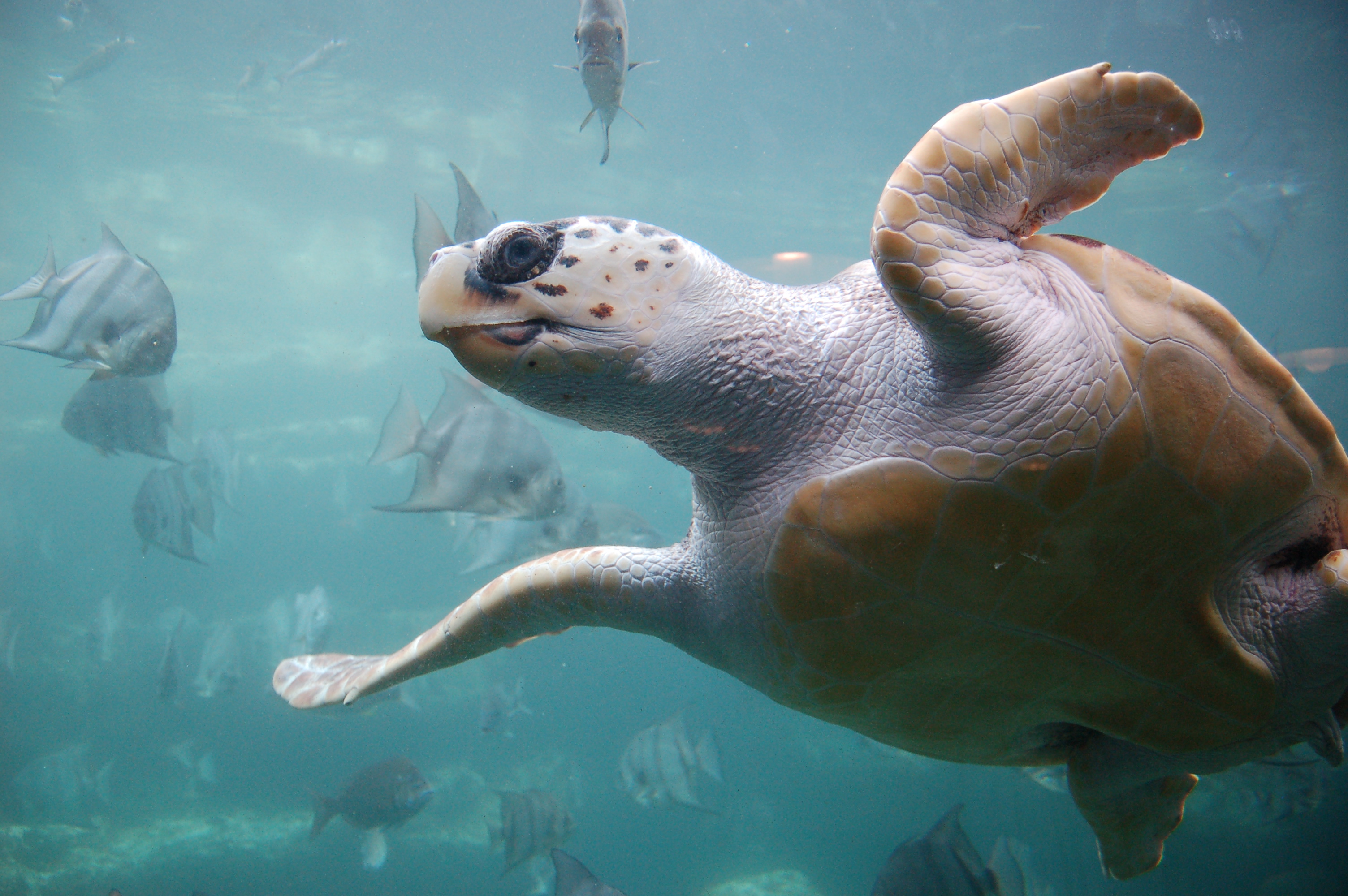
Underside of a loggerhead sea turtle as it swims overhead. Photo: Lance Miller,
Flowering Now; Pittwater Spotted Gum
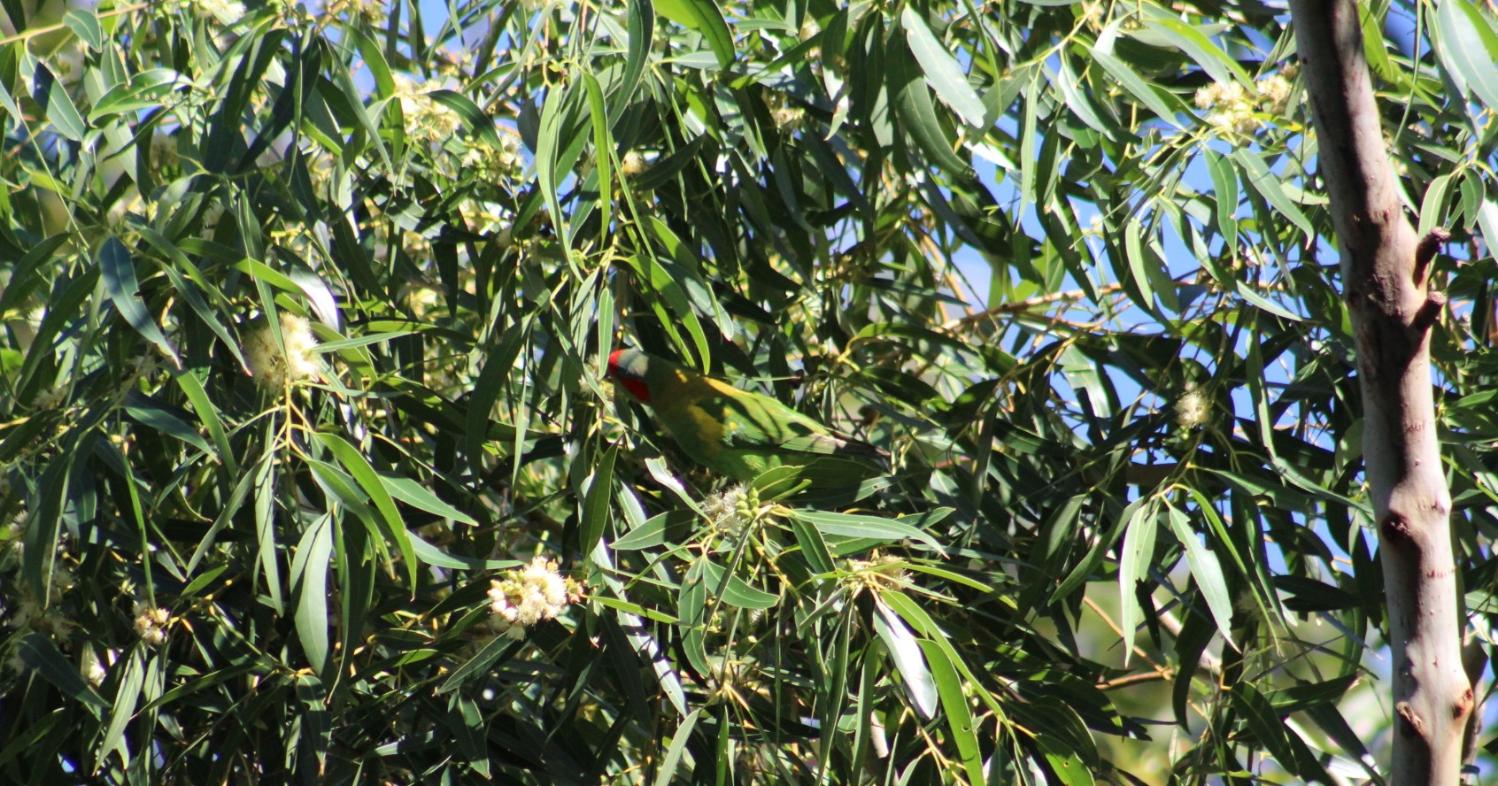
Corella Fledgling Pair On Mother's Day 2023; 'Feed Me, Feed Me!'
They are still slightly smaller than their small already parents and a little less sure when jumping around on tree branch etc. - prone to almost missing the bough.
.jpg?timestamp=1684396726315)
.jpg?timestamp=1684396777078)
Global Temperatures Set To Reach New Records In Next Five Years
Geneva, 17 May 2023 (WMO) 18 May AEDT
Global temperatures are likely to surge to record levels in the next five years, fuelled by heat-trapping greenhouse gases and a naturally occurring El Niño event, according to a new update issued by the World Meteorological Organization (WMO).
There is a 66% likelihood that the annual average near-surface global temperature between 2023 and 2027 will be more than 1.5°C above pre-industrial levels for at least one year. There is a 98% likelihood that at least one of the next five years, and the five-year period as a whole, will be the warmest on record.
“This report does not mean that we will permanently exceed the 1.5°C level specified in the Paris Agreement which refers to long-term warming over many years. However, WMO is sounding the alarm that we will breach the 1.5°C level on a temporary basis with increasing frequency,” said WMO Secretary-General Prof. Petteri Taalas.
“A warming El Niño is expected to develop in the coming months and this will combine with human-induced climate change to push global temperatures into uncharted territory,” he said. “This will have far-reaching repercussions for health, food security, water management and the environment. We need to be prepared,” said Prof. Taalas.
There is only a 32% chance that the five-year mean will exceed the 1.5°C threshold, according to the Global Annual to Decadal Climate Update produced by the United Kingdom’s Met Office, the WMO lead centre for such predictions.
The chance of temporarily exceeding 1.5°C has risen steadily since 2015, when it was close to zero. For the years between 2017 and 2021, there was a 10% chance of exceedance.
“Global mean temperatures are predicted to continue increasing, moving us away further and further away from the climate we are used to,” said Dr Leon Hermanson, a Met Office expert scientist who led the report.
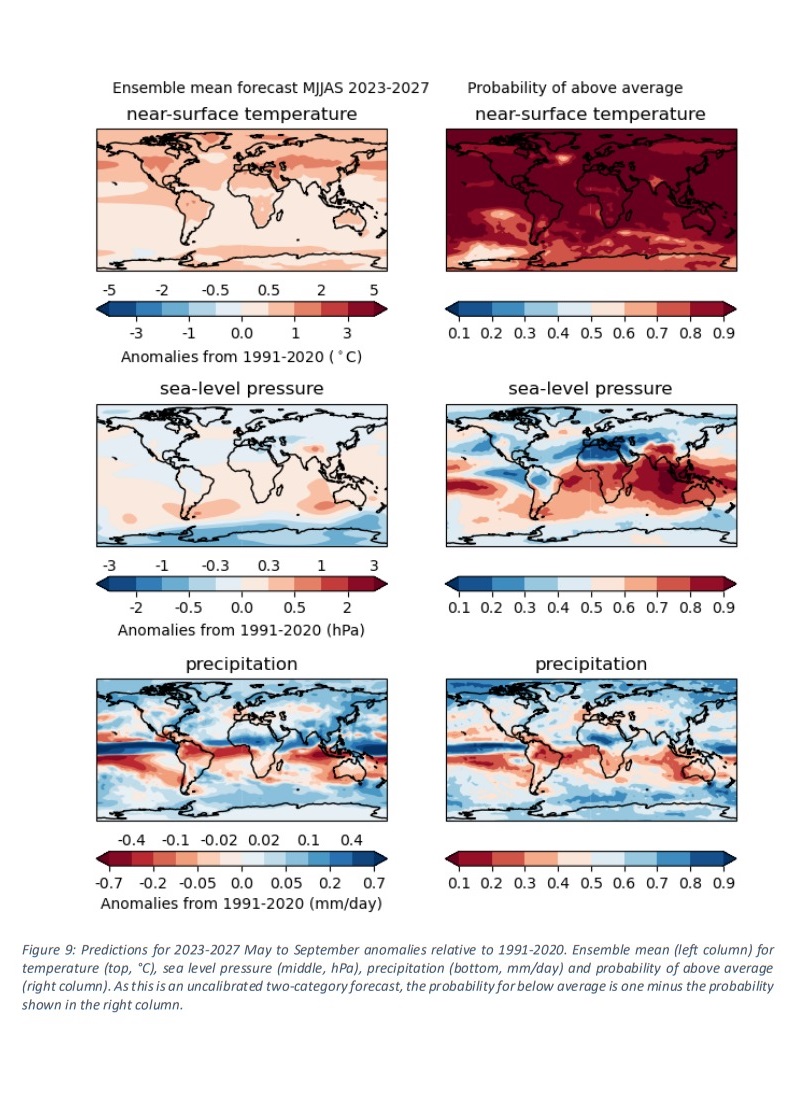
From page 12. WMO Global Annual to Decadal Climate Update (Target years: 2023-2027)
Key points
- The average global temperature in 2022 was about 1.15°C above the 1850-1900 average. The cooling influence of La Niña conditions over much of the past three years temporarily reined in the longer-term warming trend. But La Niña ended in March 2023 and an El Niño is forecast to develop in the coming months. Typically, El Niño increases global temperatures in the year after it develops – in this case this would be 2024.
- The annual mean global near-surface temperature for each year between 2023 and 2027 is predicted to be between 1.1°C and 1.8°C higher than the 1850-1900 average. This is used as a baseline because it was before the emission of greenhouse gases from human and industrial activities.
- There is a 98% chance of at least one in the next five years beating the temperature record set in 2016, when there was an exceptionally strong El Niño.
- The chance of the five-year mean for 2023-2027 being higher than the last five years is also 98%.
- Arctic warming is disproportionately high. Compared to the 1991-2020 average, the temperature anomaly is predicted to be more than three times as large as the global mean anomaly when averaged over the next five northern hemisphere extended winters.
- Predicted precipitation patterns for the May to September 2023-2027 average, compared to the 1991-2020 average, suggest increased rainfall in the Sahel, northern Europe, Alaska and northern Siberia, and reduced rainfall for this season over the Amazon and parts of Australia.
Paris Agreement
In addition to increasing global temperatures, human-induced greenhouse gases are leading to more ocean heating and acidification, sea ice and glacier melt, sea level rise and more extreme weather.
The Paris Agreement sets long-term goals to guide all nations to substantially reduce global greenhouse gas emissions to limit the global temperature increase in this century to 2 °C while pursuing efforts to limit the increase even further to 1.5 °C, to avoid or reduce adverse impacts and related losses and damages.
The Intergovernmental Panel on Climate Change says that climate-related risks for natural and human systems are higher for global warming of 1.5 °C than at present, but lower than at 2 °C.
The new report was released ahead of the World Meteorological Congress (22 May to 2 June) which will discuss how to strengthen weather and climate services to support climate change adaptation. Priorities for discussion at Congress include the ongoing Early Warnings for All initiative to protect people from increasingly extreme weather and a new Greenhouse Gas Monitoring Infrastructure to inform climate mitigation.
The report 'WMO Global Annual to Decadal Climate Update (Target years: 2023-2027)' is available at: https://library.wmo.int/doc_num.php?explnum_id=11611
Also:
IPCC
May 18, 2023
Every increment of warming results in rapidly escalating hazards.
More intense heatwaves, heavier rainfall & other weather extremes further increase risks for human health & ecosystems.
Read more from IPCC's Synthesis Report ➡️ https://bit.ly/SRYRpt23 (marhc 2023)
Report: https://www.ipcc.ch/report/sixth-assessment-report-cycle/
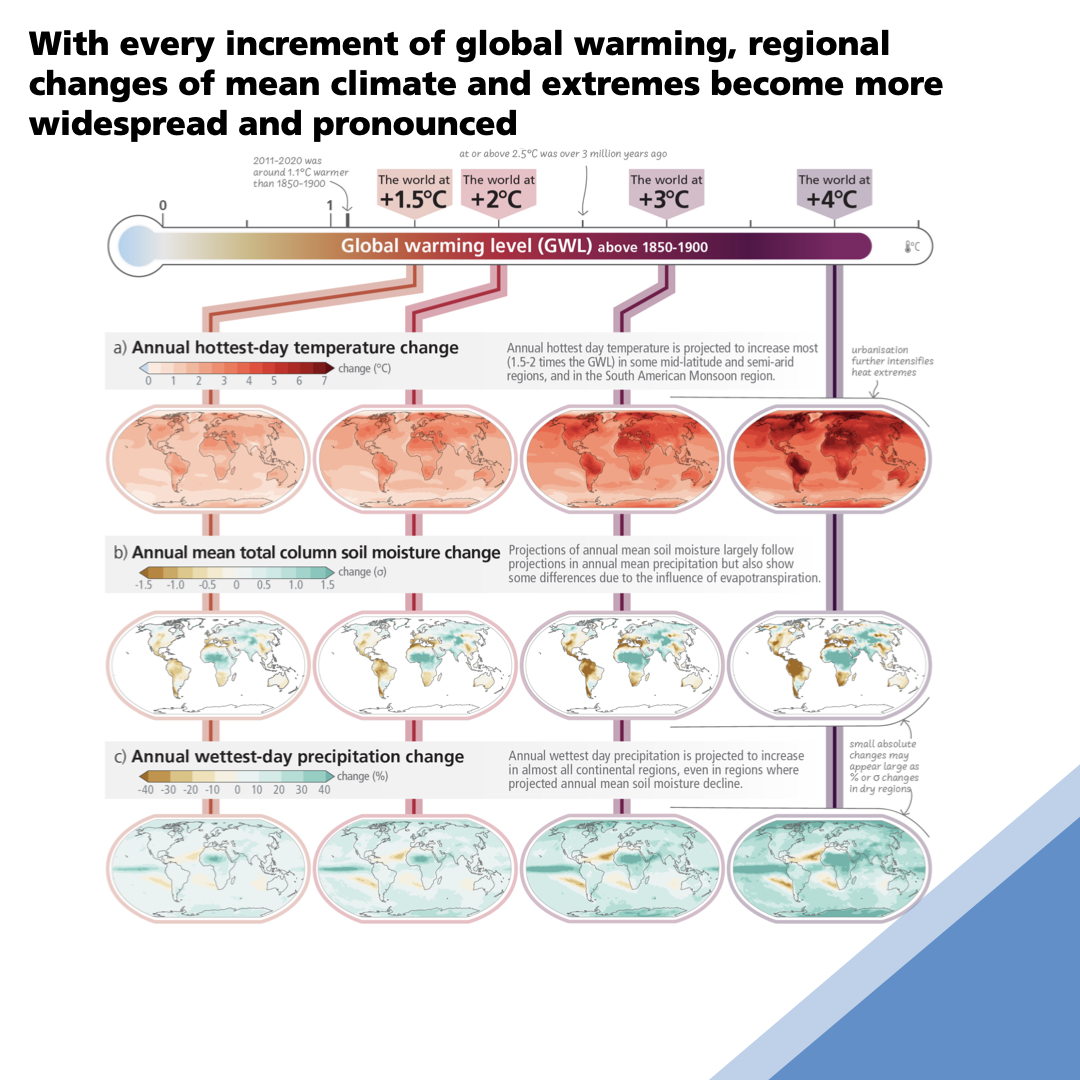
'Planet Hurtling Towards Hell Of Global Heating' UN Secretary-General Warns Austrian World Summit; Urging Immediate Emissions Cuts, Fair Climate Funding
May 16, 2023
Following is the text of UN Secretary-General António Guterres’ video message to the seventh Austrian World Summit, in Vienna today:
I thank the Austrian Government and Arnold Schwarzenegger for this opportunity. The climate crisis can feel overwhelming. Disasters and dangers are already mounting, with the poor and marginalised suffering the most, as we hurtle towards the hell of 2.8°C of global heating by the end of the century.
But, amidst all this, I urge you to remember one vital fact: limiting the rise in global temperature to 1.5°C remains possible. That is the clear message from the Intergovernmental Panel on Climate Change (IPCC). But, it requires a quantum leap in climate action around the world.
To achieve this, I have proposed an Acceleration Agenda. This urges all Governments to hit fast-forward on their net-zero deadlines, in line with the principle of common but differentiated responsibilities and respective capabilities in the light of national circumstances. It asks leaders of developed countries to commit to reaching net zero as close as possible to 2040 — as Austria has done. And leaders in emerging economies to do so as close as possible to 2050.
The Acceleration Agenda also urges all countries to step up their climate action, now. The road map is clear: phasing out of coal by 2030 in OECD [Organisation for Economic Co-operation and Development] countries and 2040 in all others; net-zero electricity generation by 2035 in developed countries, and 2040 elsewhere; no more licensing or funding of new fossil-fuel projects; no more subsidizing fossil fuels; and no more fake offsets, which do nothing to cut greenhouse-gas emissions, but which are still being used to justify fossil-fuel expansion today.
We can only reach net zero if we make real and immediate emissions cuts. If we embrace transparency and accountability. Relying on carbon credits, shadow markets, or murky accounting means one thing: failure. That is why I have asked CEOs to present clear net-zero transition plans, in line with the credibility standard presented by my high-level expert group on net-zero pledges.
And the Acceleration Agenda urges business and Governments to work together to decarbonize vital sectors — from shipping, aviation and steel, to cement, aluminium and agriculture. This should include interim targets for each sector to pave the way to net zero by 2050.
The Acceleration Agenda also calls for climate justice, including overhauling the priorities and business models of multilateral development banks, so that trillions of dollars in private finance flow to the green economy.
Developed countries must also make good on their financial commitments to developing countries. And they must operationalize the loss and damage fund, and replenish the Green Climate Fund. I commend Austria for increasing its pledge to the Green Climate Fund by 23 per cent and urge others to deliver their fair share.
On climate, we have all the tools we need to get the job done. But, if we waste time, we will be out of time. Let’s accelerate action, now. Thank you.
Secretary-General, At Asia-Pacific Commission Session, Notes Region Can Set Pace For Action, Urges Fast-Tracking Climate Efforts
May 15, 2023
Following is the text of UN Secretary-General António Guterres’ video message for the seventy-ninth session of the Economic and Social Commission for Asia and the Pacific (ESCAP), held in Bangkok today:
I send warm greetings to the Economic and Social Commission for Asia and the Pacific. I welcome your theme for this session: “Accelerating climate action in Asia and the Pacific for sustainable development”. This region accounts for more than half of global greenhouse gas emissions and is home to some of the most vulnerable countries in the world.
It is vital to global efforts to keep temperature rise within the 1.5°C limit. Most countries in the region have already pledged carbon-neutrality goals towards mid-century. But we need to accelerate action, with steep reductions in emissions within the next few years.
The Acceleration Agenda will require fast-tracking climate efforts in every sector and on every timeframe. The ESCAP study that provides the basis for your discussion sets out the necessary transformations and pathways.
ESCAP stands ready to support. Asia and the Pacific region can set the pace of climate action in the decades to come. I urge you to be bold, and I wish you a successful session. Thank you.
Protect Mona Vale's Bongin Bongin Bay - Establish An Aquatic Reserve
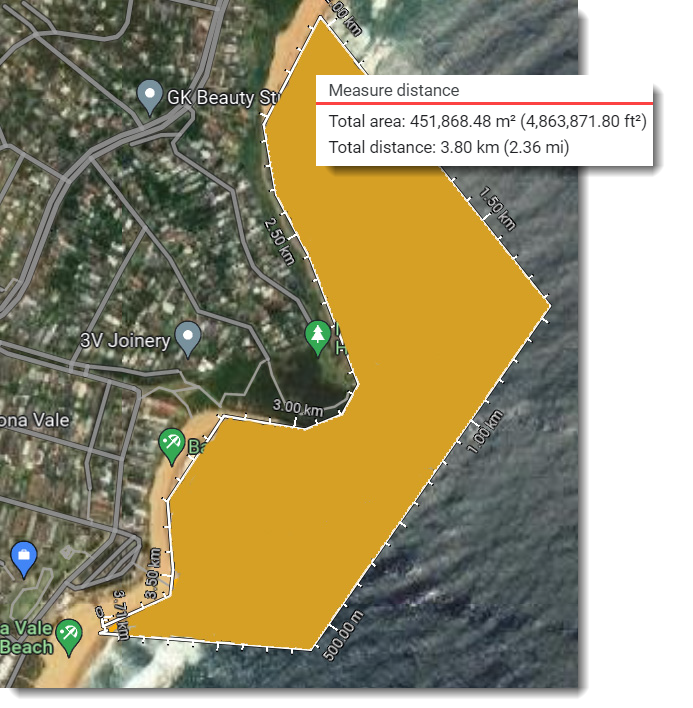
Friends Of Bongin Bongin Bay (Mona Vale Basin) Update: May 2023

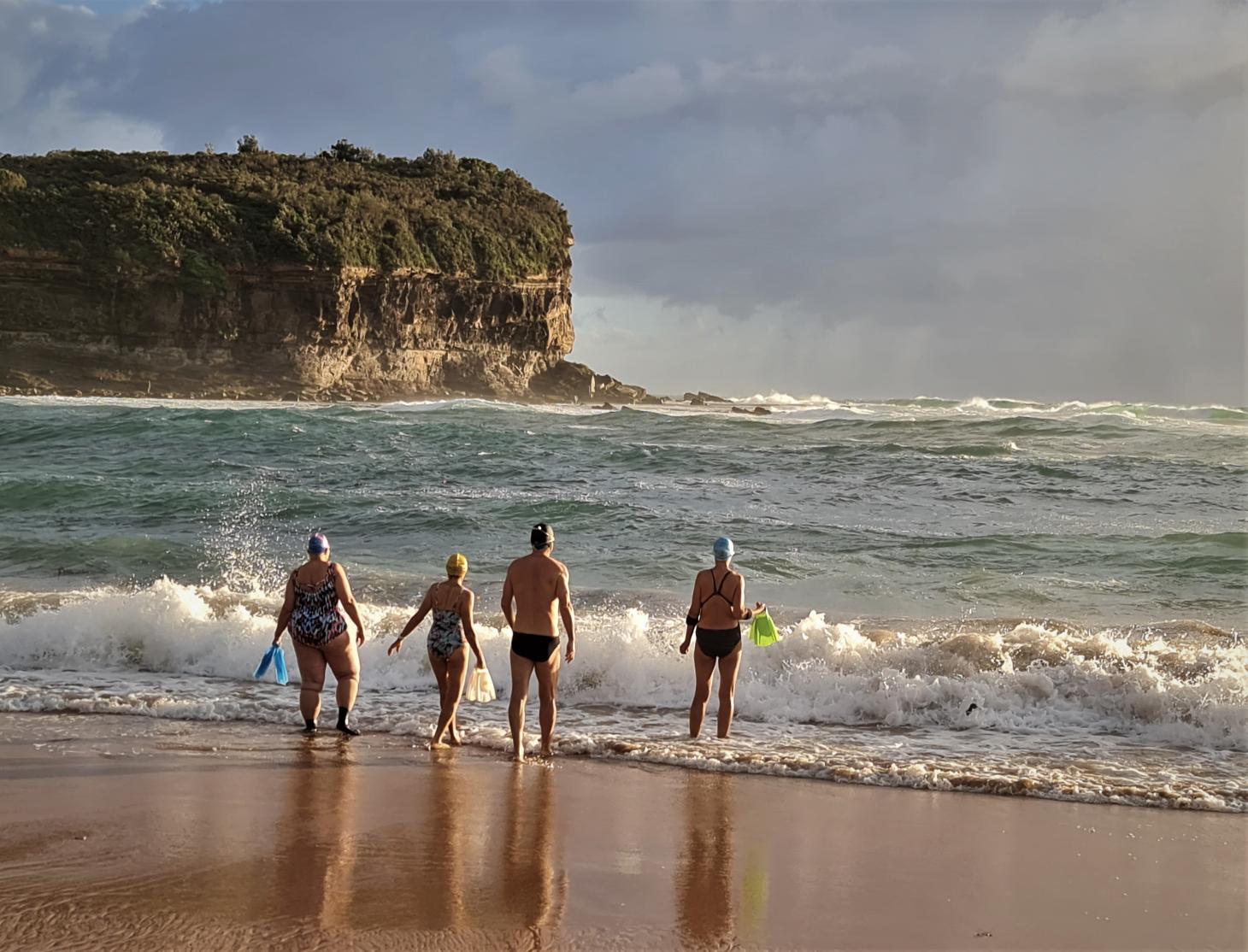
Ausgrid Community Battery Pilot - Warriewood: Have Your Say
- Take the survey here: https://yoursay.ausgrid.com.au/sharedbatterywarriewood
- Email sharedbattery@ausgrid.com.au
- Call 1800 995 674 (Mon- Fri 09:00 to 16:30 AEST)
- Postal Mail to Ausgrid Community Battery Project, GPO Box 4009, Sydney NSW 2001
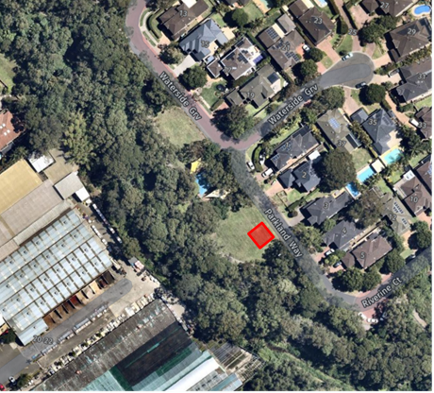
Northern Beaches Clean Up Crew: Freshwater May 28
Come and join us for our family friendly May clean up, close to Freshwater Surf Lifesaving Club on the 28th at 10am. We meet in the grass area behind the surf life saving club.
We have gloves, bags, and buckets, and grabbers. We're trying to remove as much plastic and rubbish as possible before it enters the ocean. Some of us can focus on the bush area and sandy/rocky areas, and others can walk along the beach and even clean up in the water (at own risk). We will clean up until around 11.20, and after that, we will sort and count the rubbish so we can contribute to research by entering it into a marine debris database. The sorting and counting is normally finished around noon, and we'll often go for lunch together at our own expense. We understand if you cannot stay for this part, but are grateful if you can. We appreciate any help we can get, no matter how small or big.
No booking required - just show up on the day - we will be there no matter what weather. We're a friendly group of people, and everyone is welcome to this family friendly event. It's a nice community - make some new friends and do a good deed for the planet at the same time. For everyone to feel welcome, please leave political and religious messages at home - this includes t-shirts with political campaign messages. There is a council carpark, but it is often busy on Sundays, so check streets close by as well if it's full or please consider using public transport.
Message us on our social media or send us an email if you are lost. All welcome - the more the merrier. Please invite your friends too!
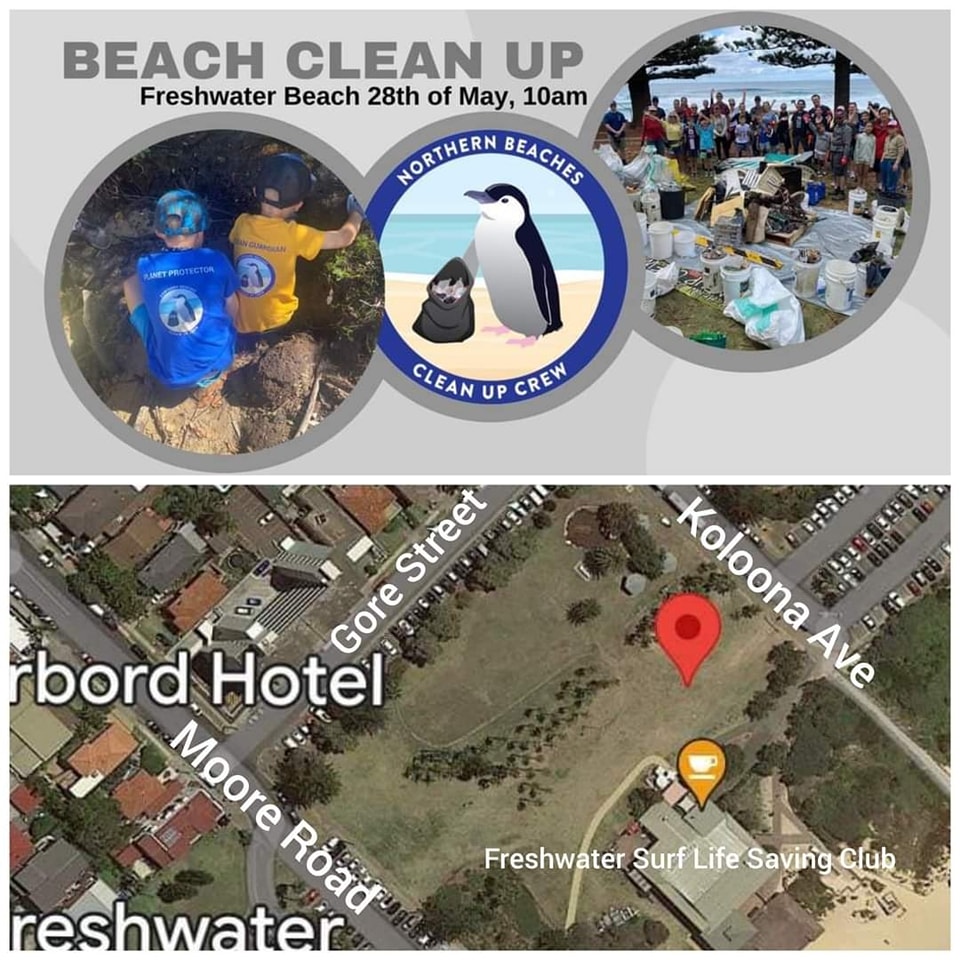
Permaculture NB: May To July 2023 Events
Permaculture Northern Beaches (PNB) is an active local group on Sydney's Northern Beaches working for ecological integrity and assisting you on a pathway to sustainability.
PNB holds monthly permaculture-related public meetings on the last Thursday of each month at the Narrabeen Tramshed Community & Arts Centre, Lakeview Room, 1395A Pittwater Road, Narrabeen. Buses stop directly at the centre and there is also car parking nearby. Doors open at 7:15 pm and meetings take place monthly from February to November.
Everyone is welcome!
We also hold a range of workshops, short courses, film and soup nights, practical garden tours, permabees (working bees), beehive installations, eco-product making sessions and much more.
KOORI KINNECTIONS
Thursday, May 25, 2023: 7:30pm – 9:00pm
Narrabeen Tramshed Arts and Community Centre, Lakeview Room
1395A Pittwater Road, Narrabeen
Join us for a night of education and connection, as we come together to learn about and celebrate the richness of Aboriginal culture.
This community gathering is an opportunity to deepen your understanding of connection to country and the diverse culture of Australia's First Peoples, and explore ways to work towards reconciliation and respect. Koori Kinnection Facilitator, Trent Kelly is a Yuin and Wailwan man, born and raised on Darawal country. Trent draws his cultural knowledge from his family, community and lived experience as a first nations person of this country.
Koori Kinnections runs educational programs for people of all ages: from bush food classes to school incursions, guided bush walks, resource talks, weaving workshops, and more. It is a 100% Aboriginal-owned and employed company.
Koori Kinnections: https://www.koorikinnections.com/
WORLD OCEANS DAY - BIG BLUE FUTURE
Thursday, June 8, 2023
World Oceans Day is held every year on 8th June to raise awareness of the vital importance of our oceans and the role they play in sustaining a healthy planet. A global celebration, it looks to bring people and organisations together across the globe in a series of events highlighting how we can all help protect and conserve the oceans.
Our ocean needs protection. Our ocean covers 70% of the planet and supports life as we know it. Every second breath we take comes from the ocean. Our ocean feeds billions of people. Our ocean hosts 80% of the world’s biodiversity.
However, our oceans are in crisis. They are being threatened by pollution such as abandoned fishing nets, overfishing, bycatch, and the effects of climate change.
We know the problems. We know the solutions.
World Oceans Day is a day to take action and raise awareness.
The 2023 theme for World Ocean Day is Big Blue Future.
To conserve our wonderful marine resources for future generations. Get involved in the conversation with #WorldOceansDay and #BigBlueFuture.
CELEBRATING WORLD OCEANS DAY
Thursday, June 29, 2023: 7:30pm – 9:00pm
Narrabeen Tramshed Arts and Community Centre, Lakeview Room
1395A Pittwater Road, Narrabeen
Join us in World Oceans’ month to learn more about the Blue planet we live on.
Two great speakers will tell us the wonders and threats facing our oceans.
Australia Marine Conservation Society works on the big issues that risk our ocean wildlife - protecting critical ocean ecosystems with marine reserves around the nation, including Ningaloo and the Great Barrier Reef. As well as issues such as over-fishing and supertrawlers, and protecting threatened and endangered species like the Australian Sea Lion.
Surfrider Foundation is actively working to stop drilling and exploration for oil and gas off our coast (PEP2). The organisation works to protect our oceans, beaches and waves through a powerful activist network.
$5 entry by donation to pay for room hire. Organic teas and coffee are available at the night + swap table - bring plants, seeds, food, books and permaculture items to swap and share.
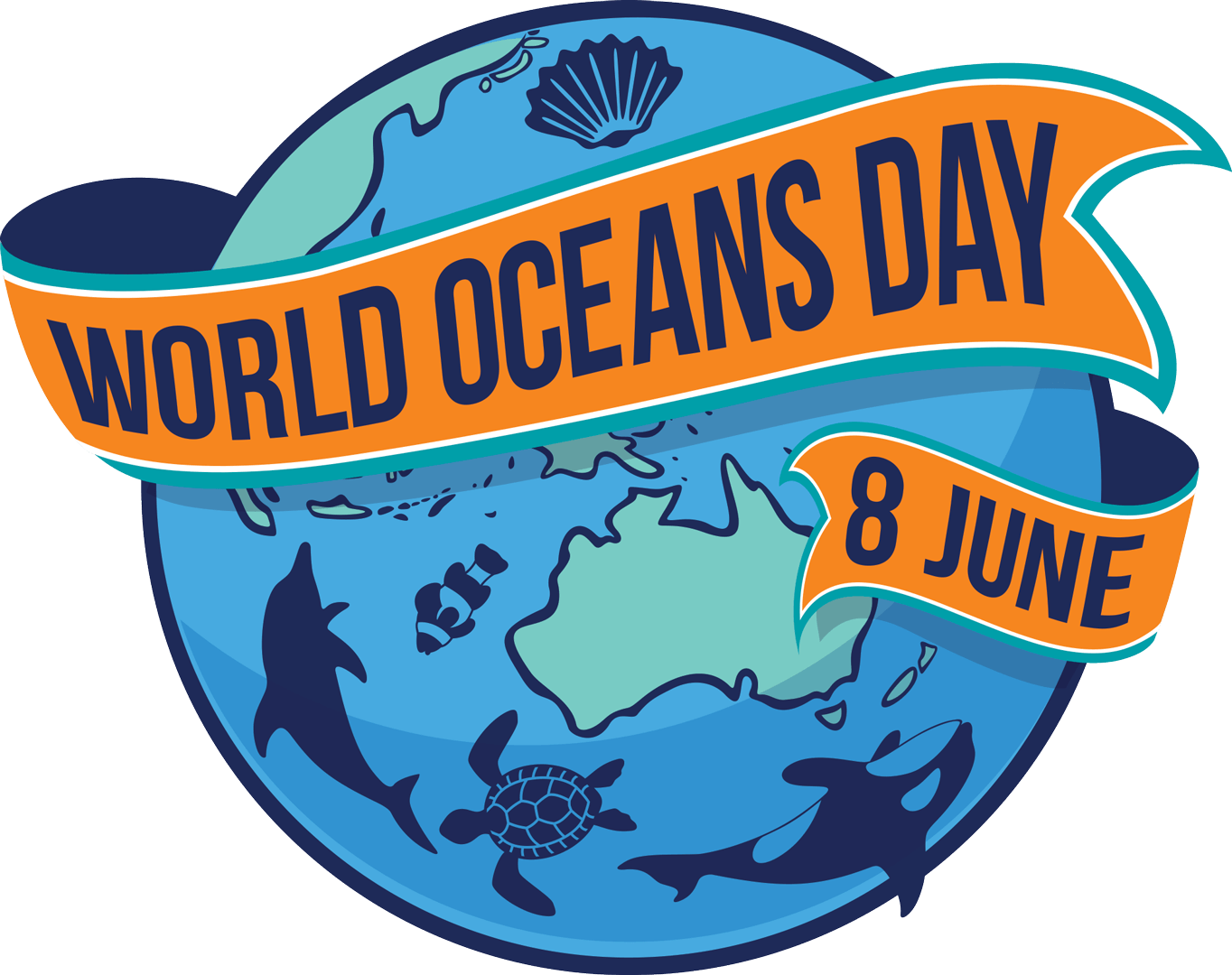
SEED SAVING CIRCLE
Saturday, July 8, 2023: 11:00am – 1:00pm
Balgowlah Community Garden
100 Griffiths Street, Balgowlah
Gather your seeds in winter for the coming spring. Share and swap seeds that are grown organically and locally. These seeds will be the best adapted you can find for the Northern Beaches climate and soils as many have been grown over generations.
Tap into the knowledge and the databank of seeds at Balgowlah Community Garden and PNB + share permaculture knowledge. This is an invaluable resource for the local community. Be part of the change - grow your own seeds and food.
Bring your non-alcoholic drinks and food to share on the day. The seed circle will be outdoors but under cover so dress weather-wise.
PLASTIC FREE JULY
Saturday, July 1, 2023 – Monday, July 31, 2023
Permaculture Northern Beaches is a part of the Plastic Free July challenge - Join Us!
The plastic bottles, bags and takeaway containers that we use for just a few minutes use a material that is designed to last forever. Every bit of plastic ever made still exists!
These plastics:
- Break up, not break down – becoming permanent pollution
- Are mostly made into low-grade products for just one more use or sent to a landfill
- End up in waterways and the ocean – where scientists predict there will be more tons of plastic than tons of fish by 2050
- Transfer to the food chain – carrying pollutants with them
- Increase our eco-footprint – plastic manufacturing consumes 6% of the world’s fossil fuels
Be part of the solution, by taking up these habits:
- Refusing plastic bags and packaging (choose your own alternatives)
- Reducing packaging where possible (opt for refills, remember your reusable shopping bags)
- Refusing plastics that escape as litter (e.g. straws, takeaway cups, utensils, balloons)
- Recycling what cannot be avoided by the use of alternatives.
Register to join 100,000 Australians and a million+ people worldwide stepping up in Plastic Free July www.plasticfreejuly.org
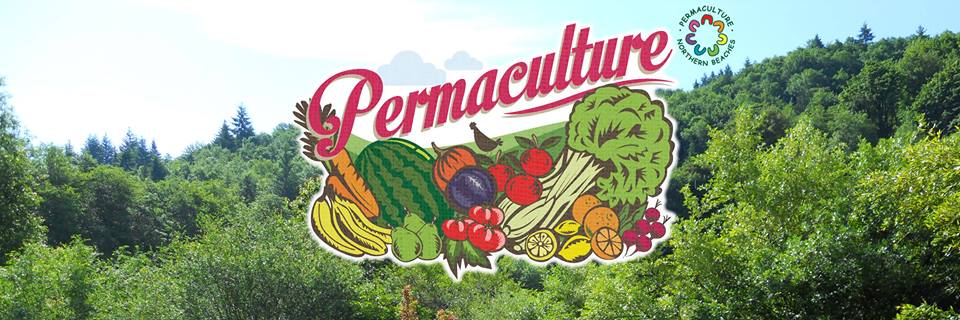
PNHA Guided Nature Walks 2023
Our walks are gentle strolls, enjoying and learning about the bush rather than aiming for destinations. Wear enclosed shoes. We welcome interested children over about 8 years old with carers. All Welcome.
Sunday June 25: Birdwatching and Bushland along Mullet Creek in Ingleside Chase Reserve
Swamp forest and coastal wetlands are rich habitat for fauna such as Swamp Wallaby and Diamond Python. Over 150 bird species have been recorded for the area. Red-Browed Finch is one.
Bring your binoculars and keep your ears pricked for bird calls. The track is mostly level, but with an optional steep climb near the Irrawong waterfall.
Meet: 8.30am near 31 Irrawong Rd North Narrabeen. Ends about 10.30.
So we know you’re coming please book by emailing: pnhainfo@gmail.com and include your phone number so we can contact you if weather is doubtful.
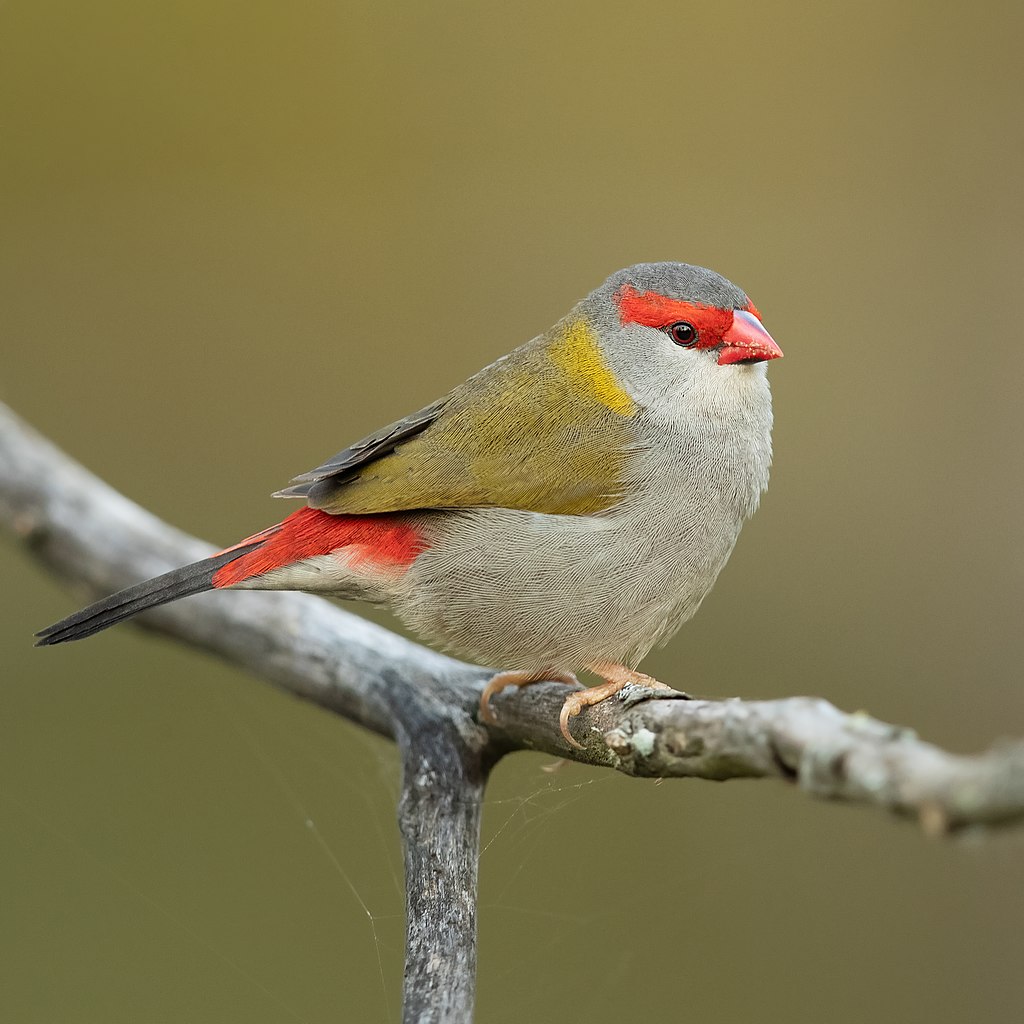
Red-browed finch (Neochmia temporalis). Photo: J J Harrison
Chemical CleanOut: June 2023
Mona Vale Beach Car Park: Sat 24, Sun 25 June 2023 - 9am-3:30pm
Surfview Road, Mona Vale
Only household quantities accepted. Maximum container size of 20kg or 20L per item.
*Up to 100L of paint (in 20L containers) now accepted at all Sydney, Hunter and Illawarra events.
Accepted:
Fluoro globes and tubes, Gas bottles and fire extinguishers, Household cleaners, Batteries, Paint*, Oils, Garden chemicals, Poisons, Smoke detectors.
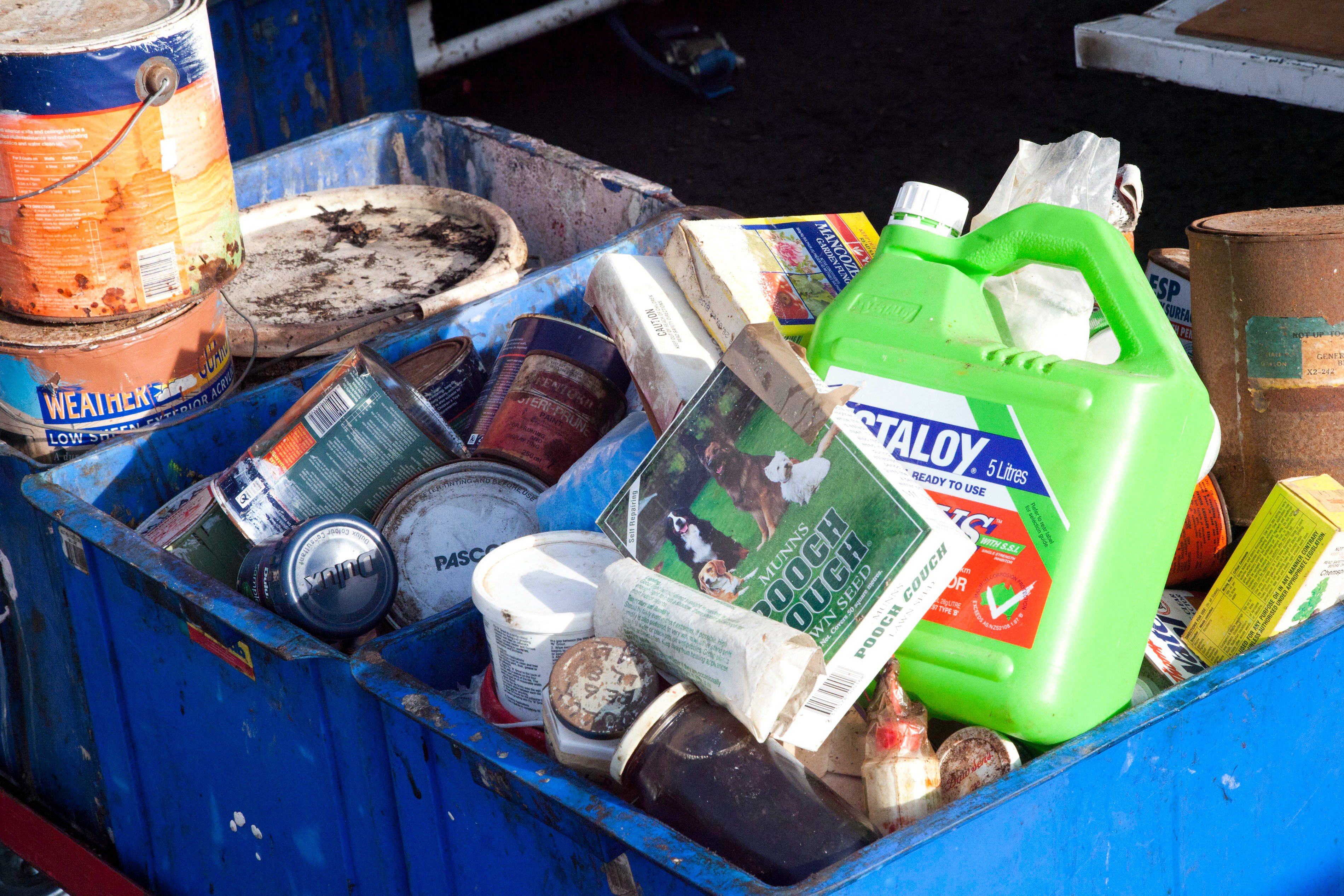
Bushcare In Pittwater
Where we work Which day What time
Avalon
Angophora Reserve 3rd Sunday 8:30 - 11:30am
Avalon Dunes 1st Sunday 8:30 - 11:30am
Avalon Golf Course 2nd Wednesday 3 - 5:30pm
Careel Creek 4th Saturday 8:30 - 11:30am
Toongari Reserve 3rd Saturday 9 - 12noon (8 - 11am in summer)
Bangalley Headland 2nd Sunday 9 to 12noon
Bayview
Winnererremy Bay 4th Sunday 9 to 12noon
Bilgola
North Bilgola Beach 3rd Monday 9 - 12noon
Algona Reserve 1st Saturday 9 - 12noon
Plateau Park 1st Friday 8:30 - 11:30am
Church Point
Browns Bay Reserve 1st Tuesday 9 - 12noon
McCarrs Creek Reserve Contact Bushcare Officer To be confirmed
Clareville
Old Wharf Reserve 3rd Saturday 8 - 11am
Elanora
Kundibah Reserve 4th Sunday 8:30 - 11:30am
Mona Vale
Mona Vale Beach Basin 1st Saturday 8 - 11am
Mona Vale Dunes 2nd Saturday +3rd Thursday 8:30 - 11:30am
Newport
Bungan Beach 4th Sunday 9 - 12noon
Crescent Reserve 3rd Sunday 9 - 12noon
North Newport Beach 4th Saturday 8:30 - 11:30am
Porter Reserve 2nd Saturday 8 - 11am
North Narrabeen
Irrawong Reserve 2nd Saturday 2 - 5pm
Palm Beach
North Palm Beach Dunes 3rd Saturday 9 - 12noon
Scotland Island
Catherine Park 2nd Sunday 10 - 12:30pm
Elizabeth Park 1st Saturday 9 - 12noon
Pathilda Reserve 3rd Saturday 9 - 12noon
Warriewood
Warriewood Wetlands 1st Sunday 8:30 - 11:30am
Whale Beach
Norma Park 1st Friday 9 - 12noon
Western Foreshores
Coopers Point, Elvina Bay 2nd Sunday 10 - 1pm
Rocky Point, Elvina Bay 1st Monday 9 - 12noon
Friends Of Narrabeen Lagoon Catchment Activities

Gardens And Environment Groups And Organisations In Pittwater
Report Fox Sightings
%20(1).jpg?timestamp=1675893929686)
Weed Of The Season: Cassia - Please Pull Out And Save Our Bush
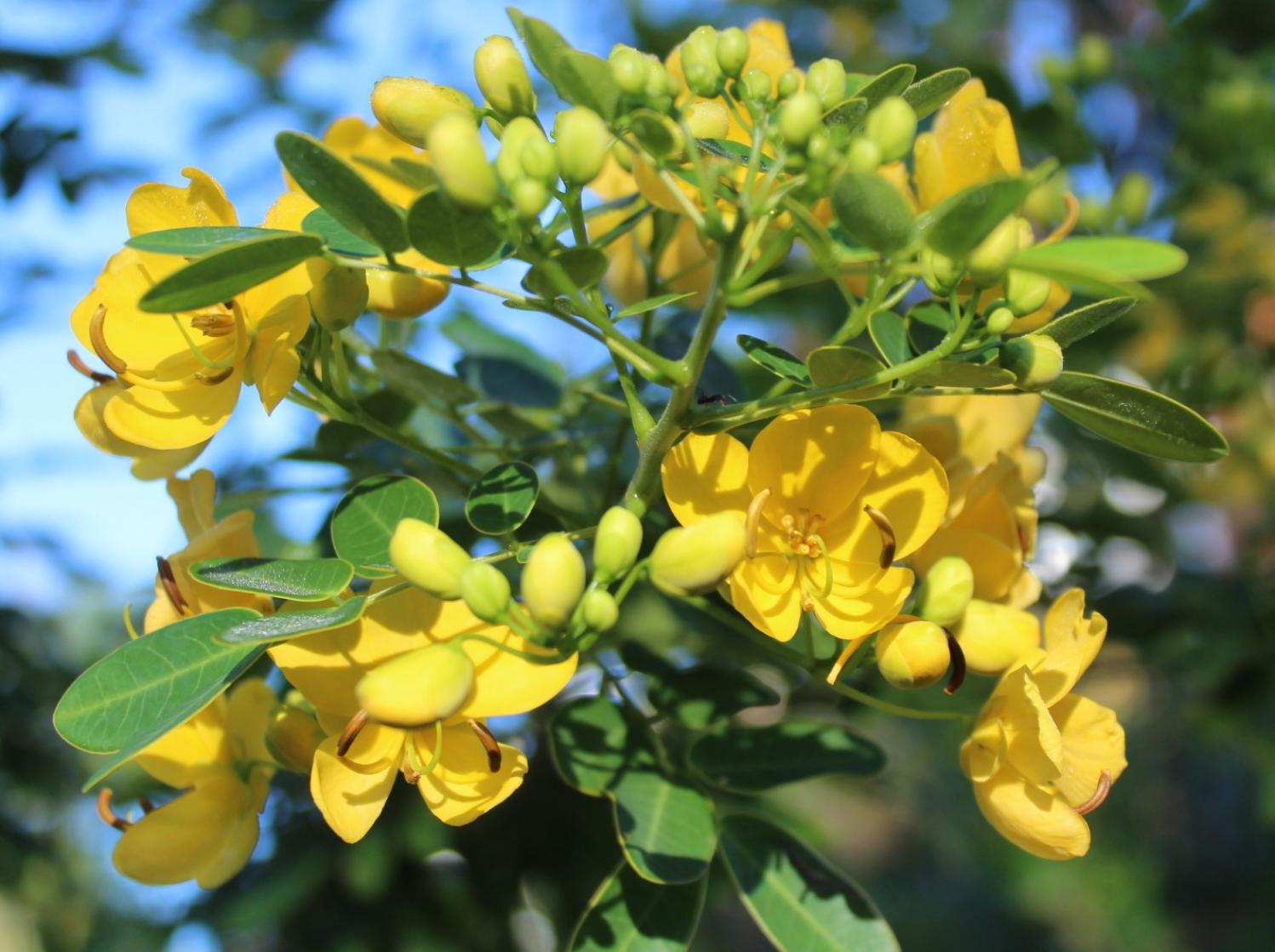
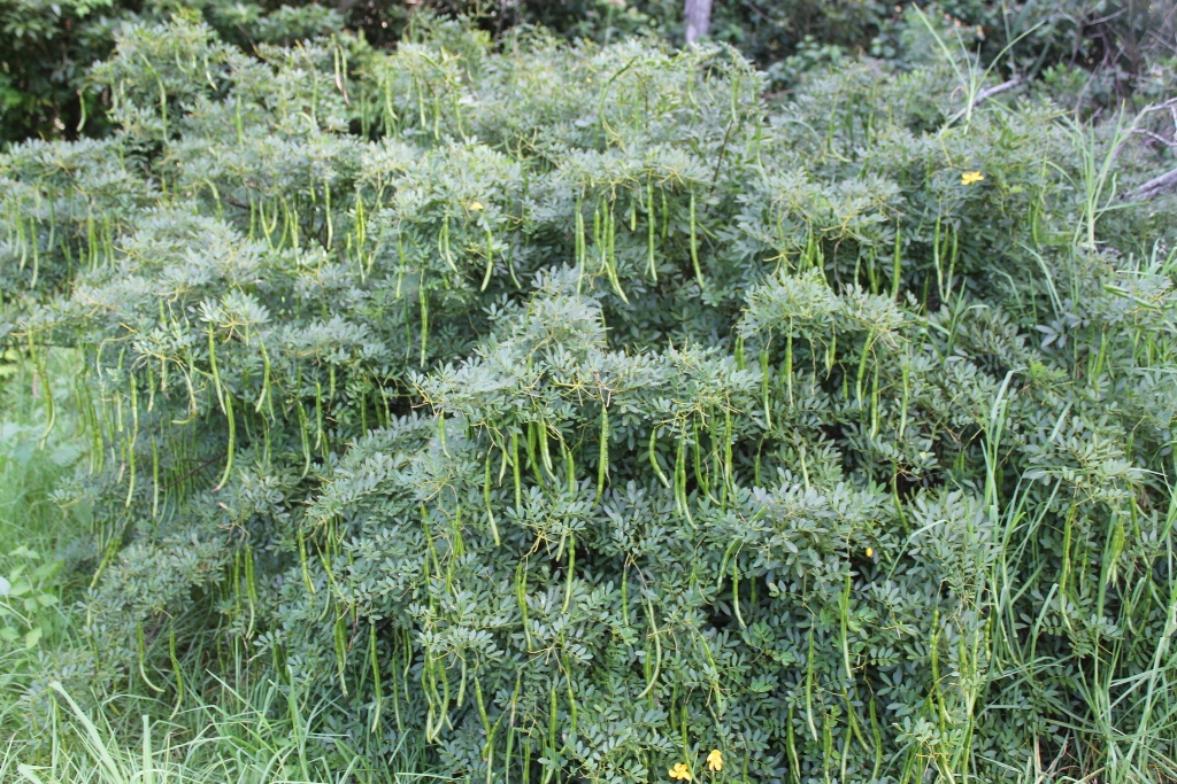
New Marine Wildlife Rescue Group On The Central Coast
A new wildlife group was launched on the Central Coast on Saturday, December 10, 2022.
Marine Wildlife Rescue Central Coast (MWRCC) had its official launch at The Entrance Boat Shed at 10am.
The group comprises current and former members of ASTR, ORRCA, Sea Shepherd, Greenpeace, WIRES and Wildlife ARC, as well as vets, academics, and people from all walks of life.
Well known marine wildlife advocate and activist Cathy Gilmore is spearheading the organisation.
“We believe that it is time the Central Coast looked after its own marine wildlife, and not be under the control or directed by groups that aren’t based locally,” Gilmore said.
“We have the local knowledge and are set up to respond and help injured animals more quickly.
“This also means that donations and money fundraised will go directly into helping our local marine creatures, and not get tied up elsewhere in the state.”
The organisation plans to have rehabilitation facilities and rescue kits placed in strategic locations around the region.
MWRCC will also be in touch with Indigenous groups to learn the traditional importance of the local marine environment and its inhabitants.
“We want to work with these groups and share knowledge between us,” Gilmore said.
“This is an opportunity to help save and protect our local marine wildlife, so if you have passion and commitment, then you are more than welcome to join us.”
Marine Wildlife Rescue Central Coast has a Facebook page where you may contact members. Visit: https://www.facebook.com/profile.php?id=100076317431064
- Ph: 0478 439 965
- Email: marinewildlifecc@gmail.com
- Instagram: marinewildliferescuecc

Watch Out - Shorebirds About
.JPG.opt1460x973o0,0s1460x973.jpg?timestamp=1663629195339)
Possums In Your Roof?: Do The Right Thing
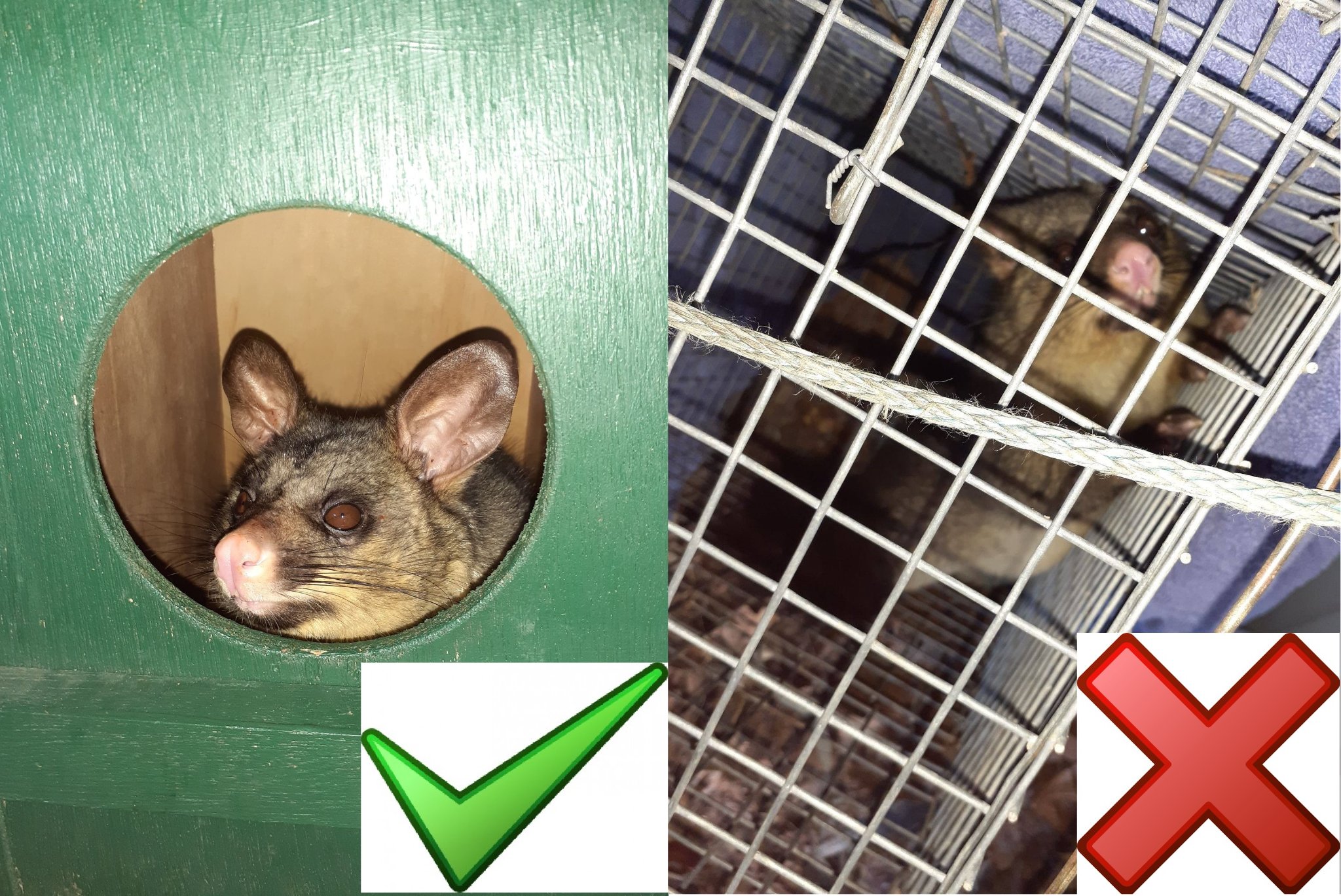
Aviaries + Possum Release Sites Needed

Platypus Return To Royal National Park For The First Time In Decades
May 15, 2023
Platypus have returned to Royal National Park, after being locally extinct for 50 years. This is the first ever translocation program for platypus in New South Wales and will re-establish a self-sustaining and genetically diverse platypus population.
The project is a collaboration between the NSW National Parks and Wildlife Service (NPWS), Taronga Conservation Society Australia, UNSW Sydney and WWF-Australia.
Five female platypus were released into the park this week and will be followed by 4 males in the coming week once the females have successfully established their territory.
The platypus were collected from southern NSW to ensure genetic diversity and brought to Taronga Zoo's purpose-built platypus refuge.
They received veterinary health checks, were assessed for release, and fitted with transmitters.
Ongoing monitoring and tracking by UNSW and WWF-Australia will determine the success of the re-introduction to the park.
Platypus are under threat from habitat destruction and fragmentation.
These factors are increasing extinction risk to platypus populations and their resilience to endure extreme climate events.
NSW Environment Minister Penny Sharpe said,
"The iconic platypus is under immense pressure. The work that has gone into this project to get to the point of releasing these platypus is essential to assure the security of these species into the future."
"Royal National Park is Australia's oldest national park and I am pleased this historic reintroduction will help re-establish a sanctuary for this iconic species."
"Translocation is just one conservation measure that can help ensure the survival of NSW species such as platypus against climate change."
Cameron Kerr, Taronga Conservation Society Australia said,
"Shy and enigmatic, platypus are the silent victims of climate change. While their elusive behaviour keeps them from view, under the surface they are particularly susceptible to drought and environmental change."
"This translocation not only re-establishes a population in part of their former range but allows us to refine the skills and expertise that will inevitably be required to counter the impacts of increasingly frequent and more severe climate events."
"The platypus is Taronga's emblem, and we are committed to ensuring it not only survives but thrives for years to come."
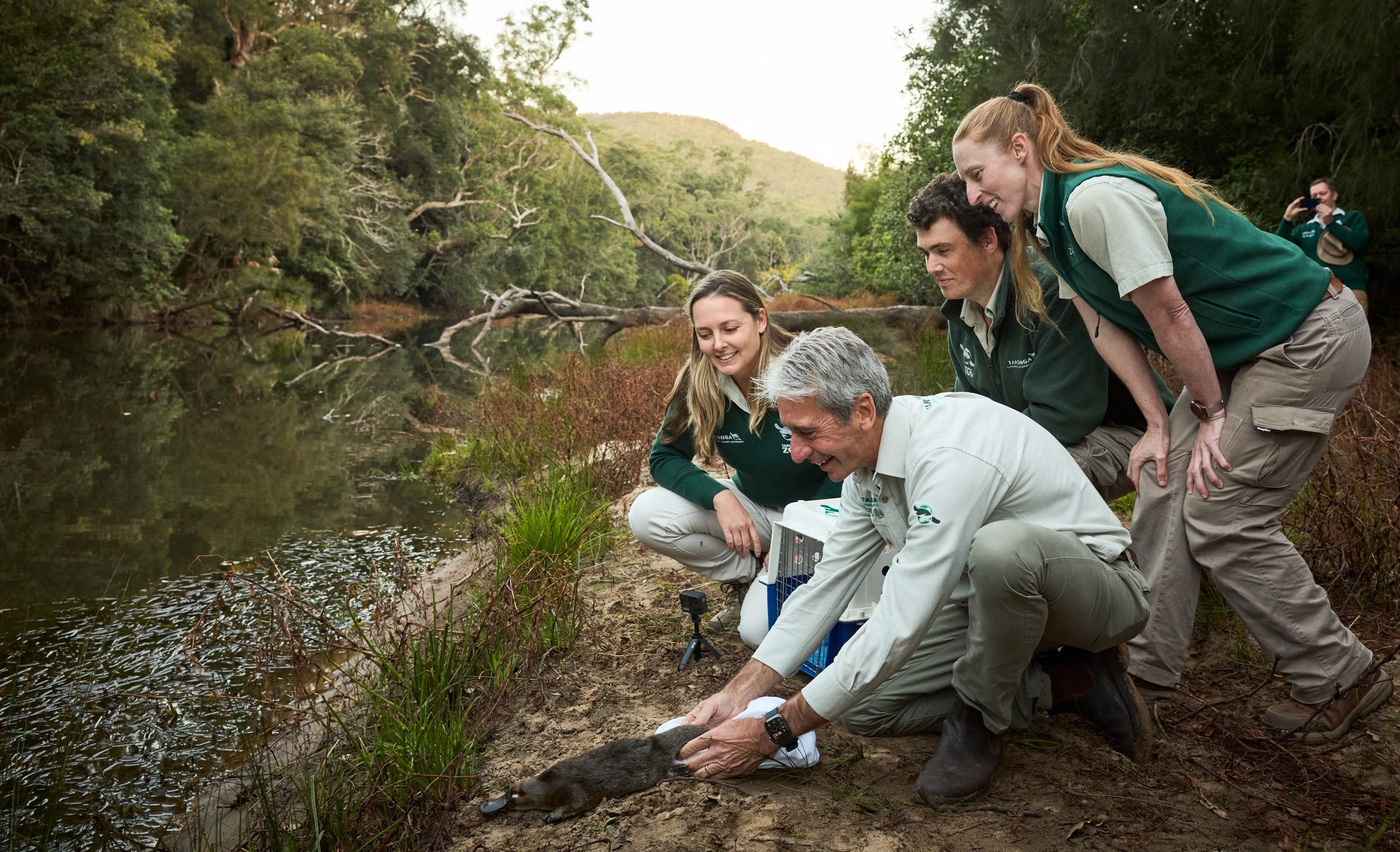
Dr Phoebe Meagher and Cameron Kerr AO, CEO, Taronga Conservation Society Platypus release Credit: R Freeman/UNSW
Dr Gilad Bino, UNSW's Centre for Ecosystem Science stated,
"The reintroduction of platypus to the Royal National Park is more than just about returning an iconic species to its home; it's about restoring balance to the ecosystem and reinforcing our commitment to conservation."
"We hope that people will be inspired by the incredible platypus and its successful reintroduction, as it serves as a testament to what can be achieved through conservation and dedicated efforts."
Rob Brewster WWF-Australia's Rewilding Program Manager said,
"Platypus are the face of our creeks and rivers, but we risk losing them forever if we don't take bold actions to reverse their decline."
"The last century saw the destruction of so much of Australia's wildlife and wild places. The return of platypus to the Royal National Park shows that we can move beyond just protecting what remains, and actually restore what we've lost."
Taronga Zoo Sydney has stated;
'For the first in decades, the platypus has returned to the Royal National Park; a milestone that was made possible thanks to a unique collaboration between Taronga Conservation Society Australia, UNSW, NSW National Parks and Wildlife Service and WWF-Australia. In total, 10 platypuses will make the park their home, and help re-establish a self-sustaining population.
Learnings from this landmark project will inform future emergency response plans to translocate platypus from drought-affected areas.
During the black summer bushfires, platypus were being rescued from drying riverbeds across NSW and brought to our Taronga Wildlife Hospitals. Although we tried to help as many as we could, sadly, we didn’t have the capacity to take in all the animals that needed our help. It was heart-breaking, and we never wanted to be in that position again.
That is why, with the support of RSPCA NSW NSW and philanthropic donors, we have opened a new Platypus Rescue and Rehabilitation centre at Taronga Zoo with another centre set to open at Taronga Western Plains Zoo later this year.
These purpose-built facilities will provide important refuge for platypus during emergency translocations when intervention is required to save a population. The platypuses released earlier this week were cared for at our new refuge centre, and also received health checks at the Taronga Wildlife Hospital.
We refuse to stand by and watch as our wildlife disappears, and this project is another example of how Taronga’s expert conservationists, scientists, vets and keepers are working tirelessly to protect this iconic species.
Find out how you can support our ongoing conservation efforts for this unique species: https://fal.cn/3yef5
NSW Natural Resources Minister Visits Mt Arthur Coal Mine
May 17, 2023
Minister for Finance and Natural Resources Courtney Houssos toured the Mt Arthur Coal Mine on Monday, and on Tuesday met with Chairs of the Royalties for Rejuvenation Expert Panels to discuss future opportunities for coal-mining regions.
Minister Houssos said the NSW Government will deliver its election commitment to establish authorities that will support local communities as they diversify to new and emerging industries.
“I’ve seen first-hand the scale of the operation at Mt Arthur and understand how important these local jobs are for the region,” Minister Houssos said.
Minister Houssos continued: “As the mine’s closure date nears it will be crucial to find ways to partner with the mine’s workers, use existing infrastructure and skills and achieve a balance of social, environmental and economic outcomes for the site’s next chapter. This is going to take a sustained effort from Government and industry.”
The Minister met with the Expert Panels on Tuesday. They discussed the challenges for local communities, and opportunities to create new jobs, drive new investment and activate opportunities for future workers.
“There are great opportunities in NSW. The NSW Government is listening and committed to collaborating with local communities, industry and workers to develop bespoke plans for these regions,” Minister Houssos said.
“The NSW Government will use the convening power of government to find innovative solutions which harness the opportunities in renewable energy and drive future investment in the regions.”
The NSW Government will work with the Federal Government to coordinate with the recently announced Net Zero Authority.
"By working with communities to find localised solutions, NSW will be able to support regional communities and economies to access new employment, skills and harness the opportunities that are presented by the industries of the future," Ms Houssos said.
Inaugural Exotic Vet Nurse Of The Year 2023: Elizabeth ‘Liz’ McConnell - Senior Nurse At Taronga Wildlife Hospital
Elizabeth was voted as the recipient of the award by her past and current colleagues for her passion for wildlife care, her dedication towards further learning and her willingness to help others. The awards are organised by Exotic Veterinary Nurse Training. Elizabeth has been with Taronga Wildlife Hospital in Sydney for 12 years.
Elizabeth's is committed to ongoing professional development, volunteering, improving wildlife care and teaching others.
Liz says that she feels privileged to have the opportunity to care for, and learn from, a wide variety of native and exotic species, and to be part of a team with a diverse range of skills and experience that share their knowledge with one another.
She would also like to give a big thank you to all the wildlife carers, that she has previously and currently work with, who have always been open to teach her and share their wealth of knowledge with her. It takes a team of people with various skills to successfully care for and treat wildlife. Most importantly thank you to the animals that she has nursed that teach her new things every day, she feels so privileged to work with them. Also a huge thank you to all the zookeepers, wildlife nurses and vets.
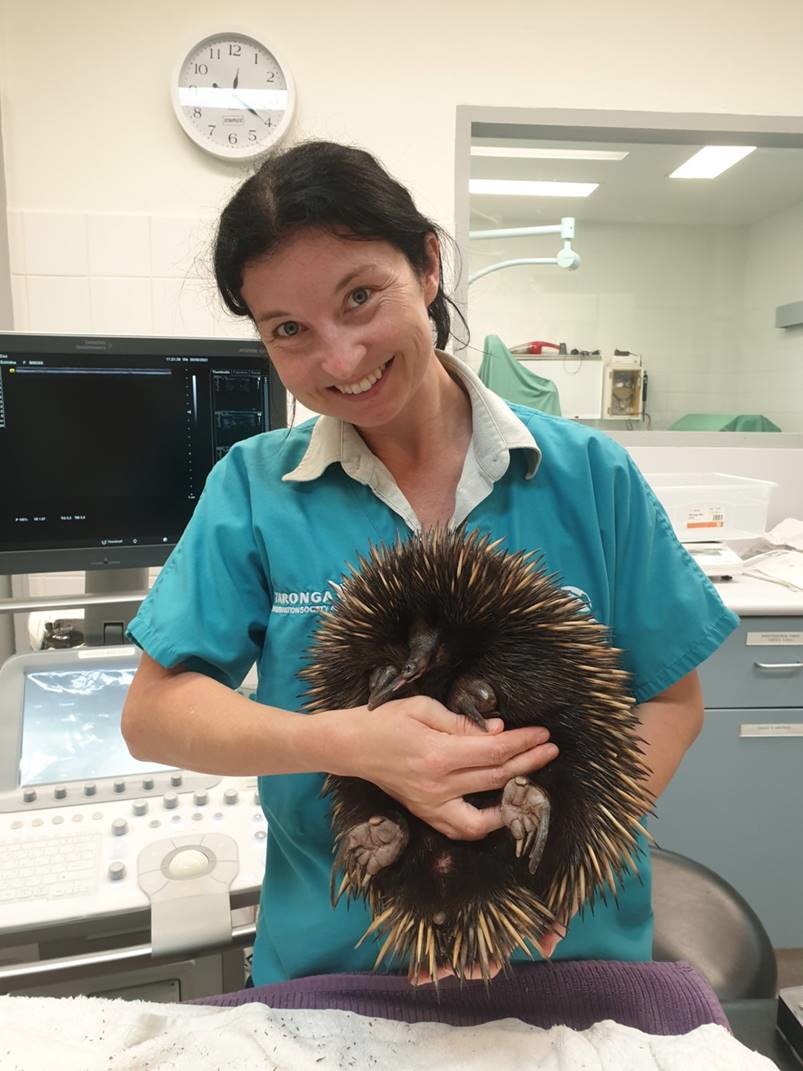
Elizabeth McConnell
A huge congratulations to the other nominees too, Shannen Koppen, Amy Bartlett, Emma Douglas and Ellen Richmond. You are all amazing nurses and exotic pet and wildlife champions. Keep being the amazing people you are!
Well done Elizabeth, it is a well deserved award.
2023 Emerging Exotic Vet Nurse Award: Madeleine Reid
Currently working as a RVN at Perth Zoo, and having previously worked as a Veterinary Nurse at Greencross Vets and as a Former Keeper at Caversham Wildlife Park, Maddie was voted for by her community for her passion, commitment to learning, her ability to learn fast and her kindness and compassion.
Madeleine said that she was very humbled even to be nominated as she's only just scratched the surface of what it means to be an exotic vet nurse. Both her teams are fantastic and shes so grateful to be learning from such skilled and knowledgeable professionals in the field.
And a huge shout out to Paityn Anderson, our runner up.
Exotic Veterinary Nurse Training - Based in Melbourne
Drawing on experience from experts around the globe, Exotic Veterinary Nurse Training caters to wildlife carers, veterinary nurse/DVM students, through to qualified veterinary nurses and veterinarians. Training on all aspects of exotic species care, from nutrition and handling, anaesthesia and CPR and everything in between. Find out more at: https://www.exoticvetnursetraining.com/
Draft Bush Fire Risk Plan: North Shore
The Mosman/ North Sydney/ Willoughby Bush Fire Management Committee is seeking feedback on a draft Bush Fire Risk Management Plan (BFRMP).
A Bush Fire Risk Management Plan (BFRMP) is a document that maps and describes the level of bush fire risk across an area and sets out treatment strategies to reduce the risk of bush fires and better protect the community over 5 years.
Download the draft Bush Fire Risk Management Plan for Mosman/North Sydney/Willoughby at:
The Mosman/ North Sydney/ Willoughby Bush Fire Management Committee, consisting of fire agencies, land managers and other stakeholders, have been working to identify ways of reducing the impact of fires on this area – protecting lives, homes, businesses, the environment, cultural values and other assets that are important to the communities within these Local Government Areas.
Your input is important – and by planning together, we will help shape the Bush Fire Risk Management Plan for this area for the next 5 years.
Your comments are invited on the draft Mosman/ North Sydney/ Willoughby Bush Fire Risk Management Plan. You can view the plan online or at your local Council.
Have your say
Have Your Say by 5pm 30th June 2023
There are three ways to submit your feedback, listed below.
- Provide your feedback online by visiting the Mosman/ North Sydney/ Willoughby Bush Fire Risk Management Plan website: https://www.rfs.nsw.gov.au/plan-and-prepare/managing-bush-fire-risk/bush-fire-management-committees/mosman-north-sydney-willoughby
- Email: me2admin@fire.nsw.gov.au
- Formal submission: Address: Executive Officer, Mosman North Sydney Willoughby BFMC, 99 Shirley Road, Crows Nest NSW 2065
Getting The Scoop On The Pelican Travel Brief: Please Report Any Pelicans With Bands
May 9, 2023
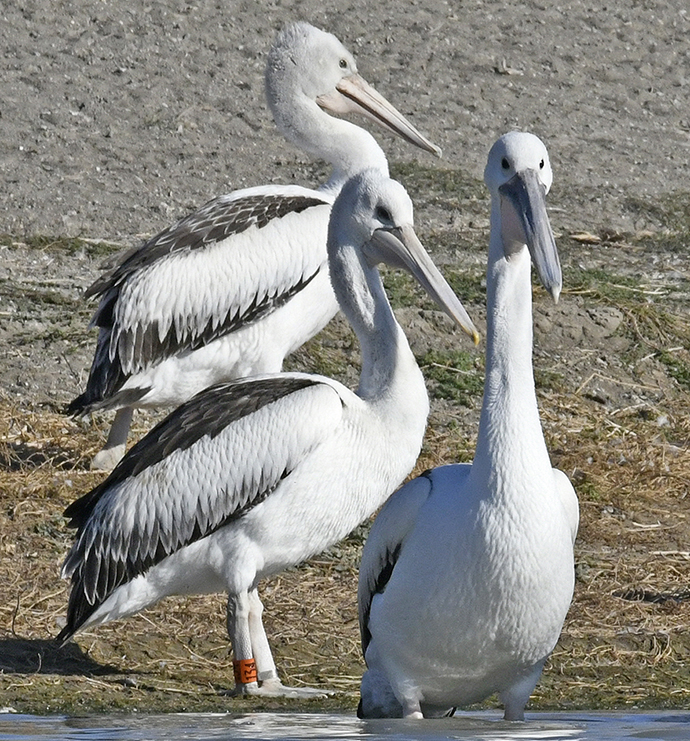 Scientists hope the secret lives of Australian Pelicans will be revealed in more detail thanks to a project tracking the travel habits of these majestic birds. More than 1,200 birds across three locations have so far been fitted with brightly coloured leg bands which show where the pelican hatched.
Scientists hope the secret lives of Australian Pelicans will be revealed in more detail thanks to a project tracking the travel habits of these majestic birds. More than 1,200 birds across three locations have so far been fitted with brightly coloured leg bands which show where the pelican hatched.
Scientists from the Department of Planning and Environment (DPE) are now calling on the public to log any sightings of the banded birds to help build a picture of their movements.
"Once pelican chicks fledge, they take to the skies but where they choose to go and nest is critical data we are keen to collect," said senior scientist Dr John Porter.
"We can use this information to make decisions on wetland and water management for sites favoured by the pelicans and to find out if pelicans prefer to return to where they hatched to breed."
Almost 400 birds were banded at Narran Lake in late March and bird watchers should look out for pelicans returning to coastal regions from May.
The pelican banding project has been running since 2017, with Narran Lake added for the first time this year.
Narran Lake birds will sport a numbered black band. Blue bands indicate the pelican hatched in the Gayini Wetlands while birds from Lake Brewster have orange leg bands.
Victorian pelican nesting sites use red and green leg bands.
The pelican research includes the University of NSW, WaterNSW and the Lake Cowal Foundation as project partners. The Nari Nari Tribal Council who manage Gayini Wetlands and a private property owner at Narran Lake have generously allowed access to breeding pelicans.
Fully grown pelicans have a wingspan of around 2.5 metres which means they can travel considerable distances. One adventurous Lake Brewster banded bird has been spotted 650 kilometres away in St George, Queensland, while two Lake Brewster banded birds recently arrived at the Narran Lake colony. Narran Lake is 400km from Lake Brewster.
UNSW Sydney Centre for Ecosystem Science, Senior Research Fellow, Dr Kate Brandis, said learning where juvenile pelicans travel to once they fledge is important in understanding which wetlands they use, to help us better manage the species and wetlands.
"In the case of the Narran Lake colony, until this year pelicans had not bred at the Lake since the 1990s as there had not been sufficient flooding to support them for the 6 months needed to successfully raise chicks.
"If we find pelicans do return to their hatching place to breed, maintaining suitable habitat at Narran Lake for this cohort to return to in a few years' time is essential to helping support Australian Pelicans into the future," Dr Brandis said.
To report a banded pelican sighting, email peli.bands@environment.nsw.gov.au, including location, band number, condition of the bird, behaviour and a photograph if possible.
Photo: NSW Dept. of Environment
NPWS Ramps Up Bushfire Preparedness
May 17, 2023
With fire season around the corner, more than 130 national park firefighters are being put through their paces today as part of a rigorous training program designed to maintain and build firefighting capacity in national parks.
With more than 1200 professional firefighters, the National Parks and Wildlife Service (NPWS) is the largest professional bushfire fighting force in NSW.
NPWS is also responsible for around 75% of all hazard reduction burns across NSW, working in partnership with the NSW Rural Fire Service and Fire and Rescue NSW.
The highly trained NPWS crew includes a large contingent of Remote Area firefighters who are winched from helicopters into remote bushland to suppress otherwise inaccessible fires before they become large and out of control.
Today’s fire preparedness training at Mt Colah will use live fire to train for realistic scenarios in bushfire fighting and planned hazard reduction activities.
The crew will undergo practical training in what to do in the event of a ‘burn over’, appropriate ignition techniques and get a better understanding of fire behaviour under different conditions.
NPWS hazard reduction program has further hazard reduction burns planned for in and around Sydney in the coming weeks.
Hazard reduction burns aims to reduce the risk of wildfires to life and property, as well as protect biodiversity and important ecological assets in our national parks.
Penny Sharpe, Minister for the Environment said;
“I am pleased to see national park firefighters maintain their training for hazard reduction, as well as bushfire response.”
“This training, plus strategic hazard reduction burns already undertaken this year, are all geared towards making our parks and communities safer over summer.”
“These cooler months are the ideal time for crews to refresh their skills, undertake further prescribed burns and prepare to be bushfire ready.”
Leigh Nolan, NPWS Fire Team Leader, stated;
“This training is an opportunity for NPWS firefighters to learn new skills, particularly relating to new technologies and understanding of bushfire behaviour which is constantly evolving, and refresh existing skills that can save lives.”
“As NPWS firefighters we work to continually improve the way we manage fire across the landscape, bringing the latest research onto the fireground to protect neighbours, property, environmental values and cultural sites.”
These giant ‘drop bears’ with opposable thumbs once scaled trees in Australia. But how did they grow so huge?
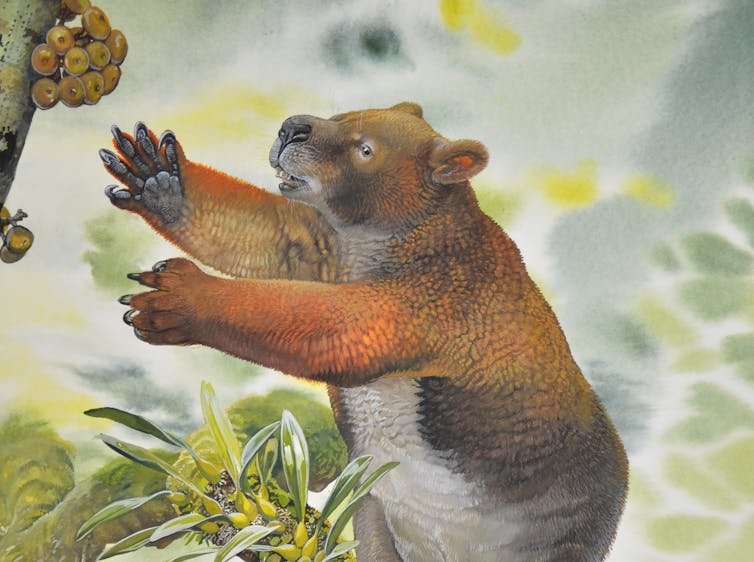
Although long dead, fossil skeletons provide an incredible window into the lifestyle and environment of an extinct animal.
By analysing the various features of fossil bones we can reveal not only the overall size and shape of the animal, but also what kind of movement the animal was capable of, its lifestyle, and the environment in which it lived.
But what if we looked inside fossil bones? What secrets would it reveal about the growth and development of an extinct animal? In a newly published paper in the Journal of Paleontology, we have done just that, using 15 million-year-old skeletons of a giant bear-like marsupial from the world-famous Riversleigh World Heritage Area (Boodjamulla) in Waanyi country of northwest Queensland.
Tree-Dwelling Wombat Relatives
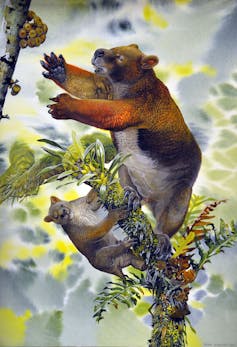
The huge tree-dwelling herbivorous marsupials, known as Nimbadon, weighed about 70kg, making them the largest arboreal (tree dwelling) mammals known from Australia.
Nimbadon belongs to a diverse group of long extinct, large-bodied marsupials known as diprotodontoids, the likes of which include the largest marsupial to have ever lived, the 2.5 tonne megafaunal Diprotodon, and bizarre trunked marsupials reminiscent of modern-day tapirs.
Among living animals, Nimbadon is most closely related to wombats. Yet surprisingly, in terms of body size and lifestyle, they are more comparable to sun bears, which today can be found scaling the rainforest canopies of Southeast Asia.
When we first uncovered jawbones of Nimbadon at Riversleigh in 1993, we thought we were looking at very large leaf-eating marsupials who foraged for food on the forest floor.

But like many of the species we’ve unearthed from Riversleigh, the closer we look at these animals, the more bizarre and fascinating they become.
Nimbadon is now known from its complete skeleton, including material representing developmental ages ranging from tiny pouch-young to mature adults. It had strong arms with very mobile shoulder and elbow joints. Its hands and feet had specially adapted opposable thumbs with huge curved claws for climbing, penetrating bark and grasping branches.
These animals were highly specialised climbers and lived vastly different lifestyles compared to their closest living relatives – the land-dwelling, burrowing wombats.
Our initial research showed that Nimbadon was not only a “tree-hugger”, but also a “tree-hanger”, spending some of its time suspended from tree branches like a sloth.
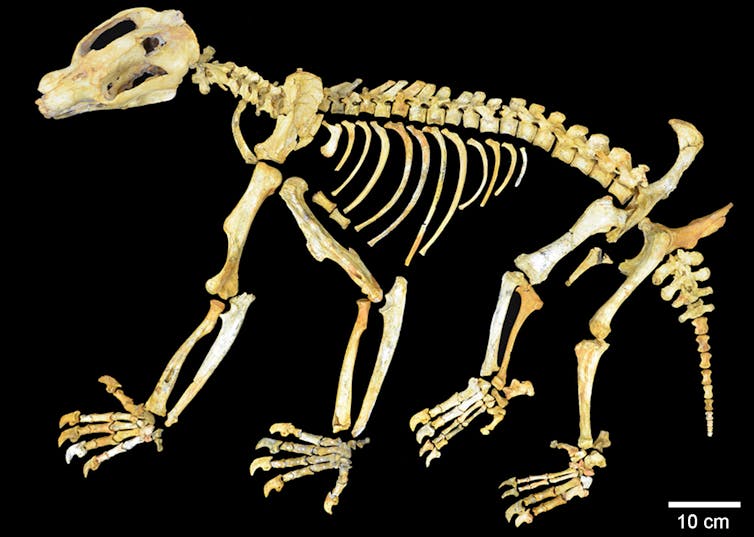
Nimbadon lived 15 million years ago in the canopy of lowland Australian rainforests. These biodiverse, lush forests were home to some equally strange animals: flesh-eating kangaroos, tree-climbing crocodiles, ancestral thylacines, cat- to leopard-sized marsupial lions, huge anaconda-like snakes, giant toothed platypuses and mysterious marsupials so strange they have been called “Thingodonta”. It was a very different Australia than the one we see today.
Sectioning The Bones
Despite the wealth of information we have gleaned from Nimbadon skeletons, until now we hadn’t fully understood the growth patterns of these ancient marsupials.
Were they affected by seasonality? How long did they take to grow to adult body size in the canopies of the ancient forest? Clues to these questions lay in the bones’ microscopic structure.
To look inside the fossil bones, we needed to select the right material. Long bones, such as the bones of the leg, are known to preserve a good record of growth, so we analysed ten long bones of several different-sized individuals.
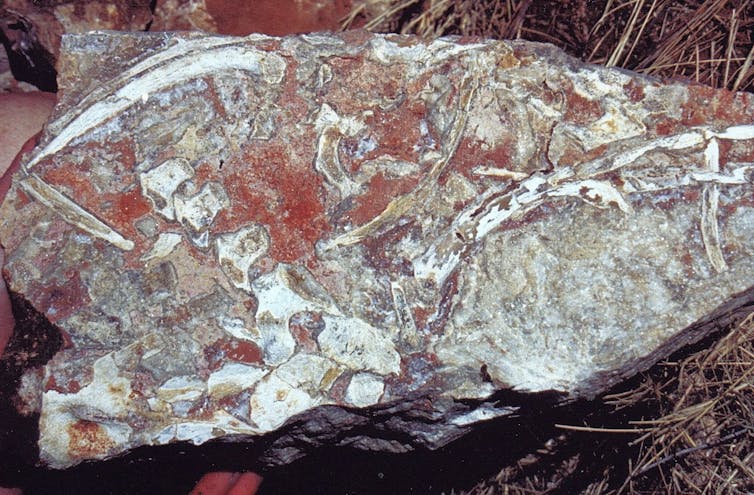
We began by removing a section from the shaft of the bone, and embedded it in resin. Using a diamond-edged blade, we cut our samples into thin sections and polished them further until light could pass through them. These thinned sections were mounted on glass microscope slides to be studied.
Remarkably, even after millions of years of fossilisation, the microscopic structure of the fossil bones had remained intact. We were amazed to discover that Nimbadon grew in periodic spurts. Individuals had fast growth periods, each followed by a slow growth period, often associated with a band of arrested growth.
Seasonal Growers
Cyclical growth patterns have previously been documented for marsupials such as in the living western grey kangaroo. However, our results indicate that, overall, the limbs of Nimbadon had a much slower, more extenuated growth than kangaroo limbs.
One individual recorded at least seven to eight growth cycles, which suggests this arboreal giant needed at least this amount of time – and probably more – to become a fully-grown, sexually mature adult.
Based on these alternating cycles of fast and slow growth, Nimbadon may have been affected by seasonal conditions such as food availability. However, exactly how long it took for eight growth cycles to develop remains a mystery. If indeed they represent annual cycles, it would be at least eight years until sexual maturity, which is unusual in the modern marsupial world.
For example, kangaroos are sexually mature at one to two years. That being said, Nimbadon is an unusual beast and a very large one at that, so an extended developmental period (and lifespan) is not unlikely.
Real-Life Drop Bears
We have come to think about these strange arboreal marsupials as real versions of the legendary “drop bears” of Australian folklore – mysterious tree-dwelling creatures that would drop down on unsuspecting animals below.

While moving in herds through the rainforest canopy, both young and adult Nimbadon would have occasionally lost their grip before dropping down from the treetops. Sometimes they would end up in forest floor caves, which is where we have been finding their still-articulated skeletons.
Given the constant surprises that research into this extraordinary, extinct Riversleigh mammal has already produced, we are eager and prepared for still more.
Currently we are looking into wear in the enamel microstructure of Nimbadon’s teeth to determine this legendary drop bear’s diet. We expect that what we find down the track will continue to upend our naïve first presumptions about the lifestyles of this and many of the other strange inhabitants of the ancient inland rainforests of Riversleigh.![]()
Anusuya Chinsamy-Turan, Professor, Biological Sciences Department, University of Cape Town; Karen Black, Leading Education Professional, UNSW Sydney; Mike Archer, Professor, Pangea Research Centre, UNSW Sydney, and Sue Hand, Professor emeritus, UNSW Sydney
This article is republished from The Conversation under a Creative Commons license. Read the original article.
Community batteries are popular – but we have to make sure they actually help share power

To power Australia without fossil fuels will mean using batteries to store power from solar and wind. We often think this means home batteries – or large grid-scale installations.
There’s another size too: community-scale or neighbourhood batteries, which are growing rapidly in Australia due to support from state governments like Victoria and Western Australia and, more recently, from the federal government. They seem to solve a lot of problems we know people are concerned about – such as enabling more rooftop solar and helping to speed up a transition to renewables.
But the popularity of these batteries shouldn’t be the only factor in decisions about where they are rolled out. Sometimes – and in some parts of the grid – they make sense. At other times, they may not be the best solution.
Our research explores when community batteries are – and are not – useful. In short, we find the main use of these batteries is to make the grid able to handle more solar and electric vehicles. But they’re not the only option. This is why we have produced a decision-making tool for policymakers to figure out where and when these batteries are worthwhile.

What Exactly Is A Community Battery – And Why Is The Idea Popular?
Think of a community battery as like a neighbourhood asset – battery packs similar in size to a 4WD that can store locally produced solar or help serve local electric vehicle charging.
The idea is for these batteries to reduce carbon emissions and energy bills while benefiting all energy users nearby, rather than only those with access to rooftop solar. These are great ambitions – small wonder they’ve proven a hit.
But the success of these batteries is far from certain.
Over the last four years, our research has found two areas we have to fix to maximise the chances these batteries actually do what we want them to do.
First, we need greater clarity on how we decide whether community batteries are a good investment.
Second, we need better measurement and evaluation of what these batteries actually contribute to the grid and to energy users.
Why does it matter? Making sure neighbourhood batteries deliver what they promise is particularly important because they have generated so much public interest and excitement.
If they don’t work, they could undermine public support for collective solutions - the type of solutions we know are more efficient and equitable than households going it alone.

Why Put Batteries Into Communities At All?
Batteries will play a crucial role in getting us towards our goal of 82% renewables by 2030. One way they can do this is by storing energy from solar and wind for later use.
Surprisingly, this doesn’t necessarily mean emissions will go down. Recent research has shown that if batteries are run to maximise profits, they could actually increase emissions by charging from coal power. By contrast, if they are run to maximise the use of solar and wind, they could contribute to lowering emissions.
What batteries do better than any other technology, however, is to provide (or soak up) power at extremely short notice to tide the grid through sudden shocks, such as the storm knocking over a transmission line or a coal-fired power station exploding.
But batteries can do this from anywhere on the grid. So the real question is: why put batteries into our suburbs and small towns at all?
In a new discussion paper, this article’s lead author argues the primary purpose of community batteries ought to be addressing constraint in the local electricity grid. This reiterates a consistent finding from our research.
While this sounds reasonable, community batteries aren’t the only option to fix local grid issues. That means we should only turn to them where they are clearly better than the alternatives, such as upgrading transformers.
What about storing solar and shoring up the grid? These tasks may be done more efficiently and with less environmental impact with grid-scale batteries, pumped hydro or electric vehicle batteries.
And what about sharing the benefits of solar with people who can’t afford an array or who have nowhere to put one? While this vision is in line with public sentiment, the complexity of the privatised energy system makes it very difficult to redistribute financial benefits.
Community batteries are also no panacea for the desire of people to see and be included in national planning for the decarbonisation transition. An inclusive planning process can address uncertainties in how the transition will affect us and our communities and ensure it upholds public values.
Time will tell if the newly announced Net Zero Authority will deliver this.
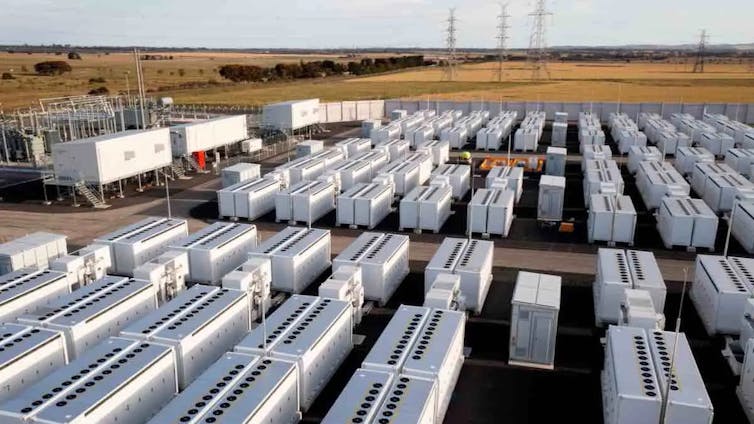
Build These Batteries Only When Warranted
So does this mean we should avoid community batteries altogether? No – but it does mean we should carefully track and evaluate these projects to see where they work best.
To help with this, several of this article’s authors developed a framework to figure out what impact these batteries have on the clean energy transition, how to do it with social acceptance and good oversight, and to do so in a way which is economically beneficial.
Community batteries are not a silver bullet, but they do have promise. Used wisely, they could help accelerate the transition away from fossil fuels while reducing network costs.
To make the most of them, we need to understand how and where these batteries will best serve the work of building a just, reliable and sustainable energy system. ![]()
Bjorn Sturmberg, Senior Research Fellow, Battery Storage & Grid Integration Program, Australian National University; Alice Wendy Russell, Research fellow, Battery Storage and Grid Integration Program, Australian National University; Hedda Ransan-Cooper, Senior Research Fellow, College of Engineering and Computer Science, Australian National University; Louise Bardwell, Research Assistant, Battery Storage and Grid Integration Program, Australian National University, and Marnie Shaw, Associate professor, Australian National University
This article is republished from The Conversation under a Creative Commons license. Read the original article.
Program to plant 20 million trees prioritised cost-saving over gains for nature, research finds
Jayden Engert, James Cook University and Susan Laurance, James Cook UniversityAustralia is a world leader in land clearing and species extinctions. Tree-planting programs are among the restoration measures needed to bring threatened species back from the brink. But do these programs always work?
Our new research set out to answer that question, by examining the much-touted 20 Million Trees program. It began under the Abbott Coalition government in 2014.
The program aimed to improve native vegetation, support a richness of plant and animal species and reduce greenhouse gases.
Our research, however, found funding decisions were largely driven by simplistic “value for money” considerations such as the cost of each tree. This undermined the benefits for both threatened species and the climate.
What Was The 20 Million Trees Program?
Australia has experienced the greatest biodiversity decline of any country in the past 200 years, driven largely by land clearing for agriculture. Many of Australia’s 2,000 threatened species and communities will become extinct unless their habitat is restored.
What’s more, vegetation stores carbon from the atmosphere, so restoring native plant communities is important for tackling climate change.
With this in mind, the Abbott government established a A$62 million tree-planting program in 2014. As the name suggests, it aimed to plant 20 million trees by 2020. The program was administered by the then Department of the Environment and Energy.
The program has now ended. More than 29.5 million trees were planted across 30,000 hectares.
Groups including restoration practitioners, community groups and landholders were paid to plant trees under the scheme. Contracts were awarded through a variety of means, including $13 million in competitive grants. These grants delivered the most individual projects, and led to three million trees planted across about 8,000 hectares.
A significant percentage of the funds allocated to threatened species recovery in 2014 and 2015 was directed to the 20 Million Trees program. So it was vital the program delivered real benefits for threatened species.
‘Cost Per Tree’ Measures Are Fraught
Our research investigated what projects were most likely to be funded by the program’s competitive grants, and whether these projects delivered real benefits to threatened species.
We started by examining the project outlines prepared by applicants for all 169 successful and 698 unsuccessful applications.
Projects were more likely to be funded when the cost per tree was less than A$5. Projects with a tree cost of more than A$10 were almost never funded.
Allocating funding based on “cost per tree” is fraught. The cost to produce a seedling depends on factors such as the cost of obtaining seeds, germination times, and growth and mortality rates. Seedlings of woodland eucalypts may cost a couple of dollars to produce, while some tropical rainforest trees can cost about $14 per seedling.
Tree species may also differ in their value to the broader ecosystem, such as their ability to provide food or shelter for threatened animals.
Forcing groups to bid low to win funding may also lead to cutting corners. This may include planting fewer tree species and minimising essential maintenance such as weeding and watering. Focusing on how many trees survived, rather than were planted, would lead to better environmental outcomes.
Dudding Our Threatened Species
Grant applications were also substantially more likely to be funded when they included the names of threatened species in the project summaries. Despite this, projects in areas supporting many threatened species were less likely to be funded.
Tree-planting projects occurred in the habitat of 769 threatened species. Of these, just nine benefited from projects covering more than 1% their range. Many projects capable of delivering more substantial benefits to threatened species were not funded.
The majority of Australia’s threatened plants and animals, or 1,302 species, received no habitat restoration under the program. But if different projects were selected for funding, habitat for about 400 of these species could have been restored.
Cost considerations were also given far more weight in funding decisions than a project’s carbon-storing potential. Projects in areas with high potential were not more likely to be funded than those in areas with low to intermediate potential.
This contradicted grant guidelines, which stipulated that alignment with program objectives – including environmental conservation and carbon reduction – be given a higher weighting than value for money.
Our conclusion was corroborated by the Australia National Audit Office in its 2016 report into the 20 Million Trees program. It found the program was appropriately designed, but assessment methods were not adhered to and eligibility assessments were not conducted transparently.
In its response to that report, the department said it was “committed to continuous business improvement to ensure that grants administration is to best-practice standard”, adding it would address the report’s recommendations.
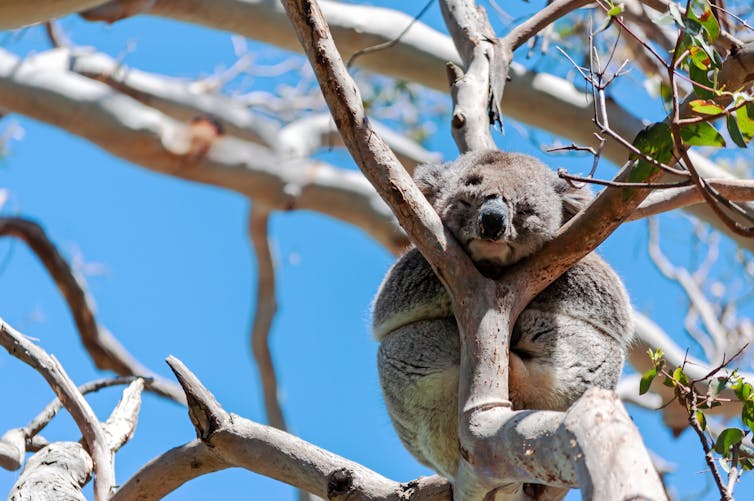
New Measures Of Success
Our research suggests simplistic measures of success are inappropriate when it comes to environmental restoration. It can lead to perverse outcomes that don’t benefit the threatened species for which funding was intended.
We found different funding criteria would have led to much larger gains for threatened species. Value for money, for example, should be calculated as the cost per area of threatened species habitat. Funding should also be prioritised for species that have lost the most habitat.
Nature restoration programs are vital to reversing Australia’s biodiversity crisis. But if they’re not done right, we risk squandering precious conservation dollars and pushing our unique plants and animals further towards extinction.
Correction: A prevous version of this article said the 20 Million Trees program began under the Rudd government. In fact, it began under the Abbott government. The error was introduced in production.![]()
Jayden Engert, PhD Candidate, James Cook University and Susan Laurance, Professor, James Cook University
This article is republished from The Conversation under a Creative Commons license. Read the original article.
Global warming to bring record hot year by 2028 – probably our first above 1.5°C limit
Andrew King, The University of MelbourneOne year in the next five will almost certainly be the hottest on record and there’s a two-in-three chance a single year will cross the crucial 1.5℃ global warming threshold, an alarming new report by the World Meteorological Organization predicts.
The report, known as the Global Annual to Decadal Climate Update, warns if humanity fails to reduce greenhouse gas emissions to net zero, increasingly worse heat records will tumble beyond this decade.
So what is driving the bleak outlook for the next five years? An expected El Niño, on top of the overall global warming trend, will likely push the global temperature to record levels.
Has the Paris Agreement already failed if the global average temperature exceeds the 1.5℃ threshold in one of the next five years? No, but it will be a stark warning of what’s in store if we don’t quickly reduce emissions to net zero.

Warming Makes Record Heat Inevitable
The World Meteorological Organization update says there is a 98% chance at least one of the next five years will be the hottest on record. And there’s a 66% chance of at least one year over the 1.5℃ threshold.
There’s also a 32% chance the average temperature over the next five years will exceed the 1.5℃ threshold. The chance of temporarily exceeding 1.5℃ has risen steadily since 2015, when it was close to zero. For the years between 2017 and 2021, it was a 10% chance.
Human-caused greenhouse gas emissions have already driven up global average temperatures by more than 1℃ since the late 19th century. The update notes the 2022 average global temperature was about 1.15℃ above the 1850-1900 average, despite the cooling influence of La Niña conditions. Temperatures are now rising by about 0.2℃ per decade.
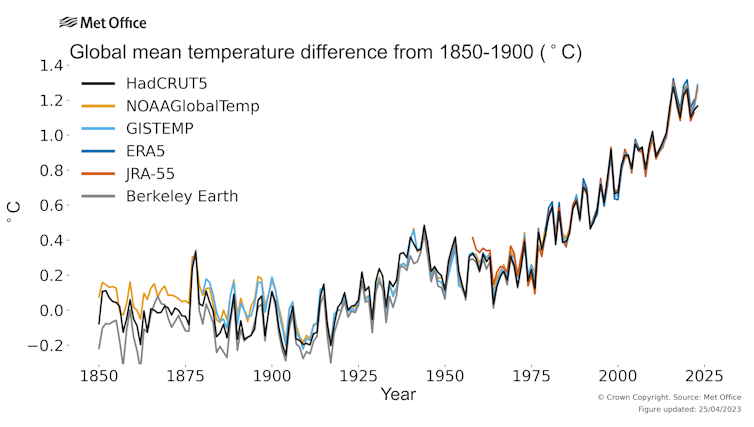
We now have more than a century of global mean temperature data. That means it should be getting harder, not easier, to achieve new records. If there was no trend, we would expect to see fewer records as time passes and the data we’ve collected better captures the full range of natural climate variability.
Instead, because we are warming the world so quickly, more heat records are being set globally and at the local level. The human influence on the climate is pushing temperatures to unprecedented highs with alarming frequency.
Add El Niño, Then Extreme Highs Are Likely
The current record global average temperature dates back to 2016. A major El Niño event early that year pushed up the global average temperature.
El Niño events are associated with warmer-than-normal seas over much of the central and eastern Pacific. This helps warm the lower atmosphere and raise global temperatures by about 0.1℃. This might not sound like much, but with rapid background warming it’s often enough to break the previous record.
In the seven years since the current global temperature record, humanity has continued to intensify the greenhouse effect. This is making a new record ever more likely.
El Niño conditions are starting to form in the Pacific and are looking increasingly likely to take hold in June and July. This could be the first significant El Niño since 2016. An El Niño would greatly increase the chance of breaking that year’s record high global average temperature, particularly in 2024.
Does This Mean The Paris Agreement Has Already Failed?
Almost all nations around the world have signed the Paris Agreement. The aim is to limit global warming to well below 2℃ and preferably below 1.5℃ above pre-industrial levels.
The prediction that an individual year above 1.5℃ global warming is more likely than not is alarming. But it doesn’t mean we have failed to achieve the Paris Agreement’s goals. The agreement aims to limit long-term global warming to a level that avoids major climate impacts, including ecosystem loss. One or two years that pop over the 1.5℃ level don’t constitute failure.
However, the world is getting closer to the 1.5℃ global warming level due to our continuing high greenhouse gas emissions. The forecast of a probable year that exceeds that level should serve as a warning.
Yet Another Sign Of Humanity’s Damage To The Climate
Past inaction on reducing emissions and tackling climate change means we have already warmed the world by more than 1.2℃. Global emissions remain at near-record high levels, so we are continuing to intensify the greenhouse effect and warm the planet.
If we are to limit global warming to well below 2℃, then we must act so future generations don’t suffer a much less hospitable planet.
We have understood the solution for decades. We must reduce emissions to net zero to stop warming Earth. Countries such as Australia, with high historical emissions, have a leading role to play by decarbonising electricity supply and ramping down coal, oil and gas production in line with goals laid out by the United Nations.
Failure to act should not be considered an option. Otherwise we are locking in more record hot years and much worse climate change impacts for decades and centuries to come.![]()
Andrew King, Senior Lecturer in Climate Science, The University of Melbourne
This article is republished from The Conversation under a Creative Commons license. Read the original article.
Yes, Environment Minister Tanya Plibersek approved a coal mine. But save the angst for decisions that matter more
John Quiggin, The University of QueenslandThe outcry was loud and swift last week after Environment Minister Tanya Plibersek approved a new coal mine in central Queensland. It’s the first coal mine Labor has approved since coming to power a year ago.
The project, the Isaac River mine, will extract metallurgical coal to be burned for steel-making. Environmental groups decried the potential damage the mine would cause to wildlife, water quality and the climate.
Any new coal mine is inconsistent with the global goal of reaching net-zero emissions by 2050. But the Isaac River mine is probably the least bad of those recently under consideration.
The mine would produce only metallurgical coal, which is still needed by the steel industry, and would operate for just five years. Importantly, we shouldn’t let controversy over the approval of a small, short-lived mine distract from more consequential recent decisions on coal – and those still looming.
A Lesson In Spin-Doctoring
Plibersek’s handling of recent coal mine announcements is a masterclass in egregious political spin-doctoring.
On May 5, Plibersek triumphantly announced she had rejected two Queensland coalmine proposals - the MacMines China Stone mine and the Stanmore Resources Range project – because the proponents failed to provide information about potential damage to the environment.
The decision was widely welcomed. But in reality, scuppering the mines was an easy and relatively uncontroversial decision for Plibersek. Both proposals had been moribund for a long time. Indeed, MacMines abandoned its proposal in 2019 and the phone number for its Darwin office is no longer even connected.
Plibersek rejected the mines not because of the damage they would cause to nature, but because the proponents had for years failed to provide basic information to the department.
Some observers suspected the announcement was meant to soften us up for bad news.
That news came six days later, when details of the Isaac River mine approval were quietly uploaded to the federal environment department’s website. The coal mine, east of Moranbah, will reportedly produce about 500,000 tonnes of metallurgical coal each year for five years.
The approval was made public right before Opposition Leader Peter Dutton’s budget reply speech. This follows a well-worn strategy of governments burying bad news by releasing it concurrently with bigger news events.
A spokesperson for Plibersek defended the approval, saying the federal government “has to make decisions in accordance with the facts and the national environment law – that’s what happens on every project, and that’s what’s happened here”.
Thermal Vs Coking Coal
In weighing up the merits of Plibersek’s decision on the Isaac River mine, we must make a distinction between thermal coal, used in electricity generation, and metallurgical or “coking” coal, used in steel-making.
Metallurgical coal accounts for about half of Australia’s coal exports by tonnage, but the great majority by value.
The world is rapidly moving away from burning coal to generate electricity. Much of Europe will be coal-free by 2030. The United States and other developed countries are following suit.
The much-publicised “return of coal” resulting from the Russian invasion of Ukraine never amounted to much and is already over.
By continuing to export thermal coal, Australia is delaying the inevitable transition for the sake of short-term profits.
So what’s the picture for metallurgical coal? Low-emissions alternatives for steel-making are available, but it will be some time before they’re deployed at scale. So demand for metallurgical coal is expected to continue for years, or even decades.
Even bodies such as the International Energy Agency, which have called for an end to all new fossil fuel investment, could scarcely raise strong objections to a small-scale metallurgical coal mine set to close in five years.
Let’s Not Get Distracted
In these circumstances, Plibersek played the media well by making the Isaac River mine the featured dish in a menu of bad news.
That approval was not the only decision made by Plibersek last week, or the most important one. She also allowed three other mine projects – two in New South Wales and one in Queensland – to proceed to the next stage of environmental assessment.
These projects had been sent back to Plibersek for further consideration after an environment group requested the effects of climate change be considered. The projects are still subject to further steps in the approvals process. But Plibersek’s decision to let them proceed provides a major boost.
The projects include an expansion of the Mount Pleasant mine in NSW. It would produce about 12 million tonnes of thermal coal a year – more than the Adani Carmichael mine. It’s expected to operate until 2050, by which time many countries have pledged to quit coal-fired power completely.
Plibersek now faces a huge political test when it comes time to decide on those, and many more coal projects in the planning pipeline. On current indications, climate impacts will be disregarded completely.
In February, Plibersek rejected mining magnate Clive Palmer’s proposed Central Queensland coal project, on the grounds it would damage rivers and the Great Barrier Reef.
So under this government, mines may be rejected because they would damage the local environment or for failing to get their paperwork right – but not because they enable emissions that will help destroy the global environment.
This is a clear weakness in national environment law. The Albanese government could have fixed it, by introducing a so-called “climate trigger”. This would have enabled it to knock back a development proposal on the grounds of its climate impact. But it has refused to do so.

Big Coal Tests Remain
Optimists can console themselves with the idea that things would have been worse if the Morrison government was still in power. But none of the approval decisions announced by Labor so far differ from those we might have expected under the Coalition.
And there is one intriguing case where things look like going the other way. In the lead-up to last year’s federal election, then prime minister Scott Morrison blocked a gas-drilling proposal off the New South Wales coast, using ministerial powers he secretly conferred upon himself.
The Albanese government has taken legal action to nullify that decision.
Many more federal decisions on coal mining projects are yet to come. If all or most are approved, Labor’s efforts to reduce domestic emissions will count for little or nothing – a fact no amount of spin-doctoring can conceal.![]()
John Quiggin, Professor, School of Economics, The University of Queensland
This article is republished from The Conversation under a Creative Commons license. Read the original article.
Breaking the mould: why rental properties are more likely to be mouldy and what’s needed to stop people getting sick

Rental properties are more likely be mouldy than other homes. This is a concern as excessive mould growth is known to harm human health.
Once buildings are infested with mould, the difficult and costly issue of remediation arises. Landlords and tenants are caught in the middle of a tussle over who is responsible for fixing the problem. As one Melbourne renter and research participant told our colleague Maria Gatto, during a study validating mould reporting:
The landlord came around [and] walked [into] every room where there’s black mould on the ceiling – like it’s freaking [something out of the TV series] Stranger Things – and she’s like, ‘Oh, a little bit of mould in winter, it’s very normal, it’s fine […] this happens every winter, it’s not a big deal’.
Heading into winter, after three consecutive La Niñas, conditions are ripe for a mega-mould season. Combining our expertise in health, law, building and construction, we examine the problem of mould in homes and offer guidance for both renters and landlords.
Ideal Conditions For Growth
Mould is a fungal growth that reproduces via tiny airborne particles called spores. When these spores settle on moist, plant-based construction materials such as wood, wallpaper or plasterboard, they can form a new colony.
Growth is more likely when homes are cold, humid, lack air flow, or suffer from water damage. Outbreaks have been reported in flooded parts of southeastern Australia.
So why is the problem of household mould worse in rentals? Weak regulation of tenancy legislation is just one of many factors. Rental properties tend to be poorly maintained, with structural problems such as leaks. Given this, they can be expensive to heat.
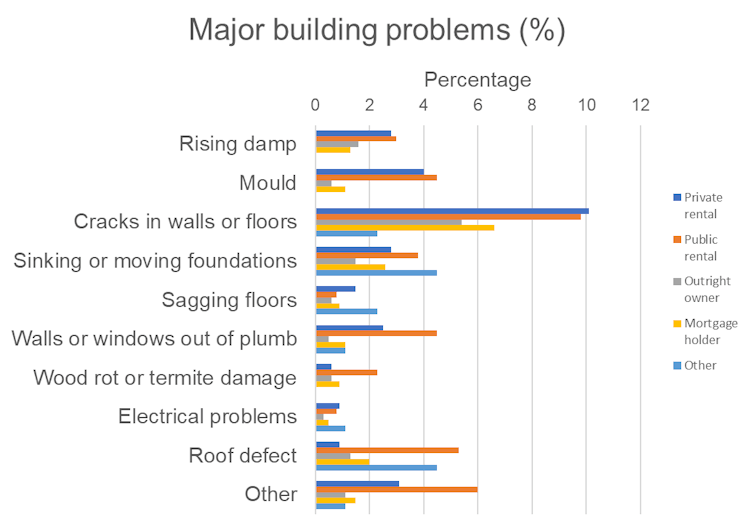
How Mould Makes People Sick
The World Health Organization recognises mould can be harmful.
A 2022 Asthma Australia report revealed people living in mouldy homes were more likely to have asthma and allergies. A systematic review of peer-reviewed research found children living in mouldy homes were more likely to experience asthma, wheeze and allergic irritation of the eyes, nose, throat and mouth (allergic rhinitis).
Living with mould is a source of stress. People worry about the consequences for their health and there is a growing body of evidence describing the negative mental health effects of mouldy, damp homes.
Problems With Managing Mould In The Rental Sector
There is a gap between building and residential tenancies legislation. A building deemed to meet the minimum standards of the construction code with respect to mould may not meet the minimum standards for rental. That’s because there’s ambiguity in the National Construction Code around “minimum standards of health”.
For example the Victorian Building Act 1993 contains some provisions for the relevant surveyor to serve a notice on the basis of a health circumstance affecting a user. However, there is no guidance on how to assess the health of the indoor environment, or to deliver a building direction that will address the root cause for mould. This varies by state and territory.
Mould remediation can be costly. A study by Victoria University found half the defects causing mould were water-related. These were more expensive to fix than other problems, by an average of A$7,000.
Each winter, Tenants Victoria deals with a spike in renters seeking legal help to resolve their mould problems. This led to the service launching an annual winter Mould Clinic in 2021.
Despite increased legal protections, renters are still struggling to get mould fixed. For these reasons, many renters find the legal process doesn’t offer a solution to their problem, and instead move to a new property, with all its attendant costs and stresses. Others can’t afford to leave, or live in social housing with limited transfer options.
Charting Mould In Homes Across Australia

Where Does The Responsibility Lie?
Tenancy legislation varies by state and territory. Renters should familiarise themselves with the regulations in their jurisdiction.
In Victoria, residential tenancies legislation has set the criteria that “each room in the rented premises must be free from mould and damp caused by or related to the building structure”. Landlords now must disclose if they have treated mould in the past three years.
Similarly, new legislation in Queensland (coming into effect in September) states rental properties should be free from vermin, damp and mould where this is caused by issues with the structural soundness of the property.
In New South Wales, the landlord needs to disclose signs of mould and dampness in the condition report (but not necessarily have fixed it). Mould is not mentioned in the ACT residential tenancies legislation.
For the most part, the responsibility for mould in rental properties lies with landlords if the cause is structural –- for example, if a broken or faulty window frame has let rainwater inside.
Requests for urgent repairs can be accompanied by an assessment report by an occupational hygienist, environmental health professional or expert from the local council. People with an existing health condition such as asthma can include a doctor’s report.
What Next?
To achieve change across all relevant domains of regulation, construction, natural disaster response and government policy, we need a sustainable, broad healthy housing agenda in Australia. We also need to consider options for immediate action.
As one Victorian renter noted:
When we buy a car for the purpose of driving on the roads, we’re required to get a roadworthy certificate to make sure it’s safe, because of the risk to other people […] Ideally it would be great if there was [some] kind of ‘rentworthy’ certificate […] to demonstrate that the property has been inspected, to identify any structural issues that might affect the tenant’s health and wellbeing. And that that be available to tenants […] before they enter into a lease or before (the property is) even able to be advertised.
For those in Melbourne, a free Tenants Victoria event on this topic will be held at RMIT University Storey Hall on Wednesday, May 17 at 1pm. It will be followed by a free pop-up legal clinic.
Quotes in this article were collected by Maria Gatto as part of her Masters of Public Health, conducted at the Melbourne School of Population and Global Health in 2022.![]()
Rebecca Bentley, Professor of Social Epidemiology and Director of the Centre of Research Excellence in Healthy Housing at the Melbourne School of Population and Global Health, The University of Melbourne; Nicola Willand, Senior Lecturer, School of Property, Construction and Project Management, RMIT University, and Tim Law, Guest lecturer and Practice Lead — Building Sciences, at Restoration Industry Consultants
This article is republished from The Conversation under a Creative Commons license. Read the original article.
Despairing about climate change? These 4 charts on the unstoppable growth of solar may change your mind
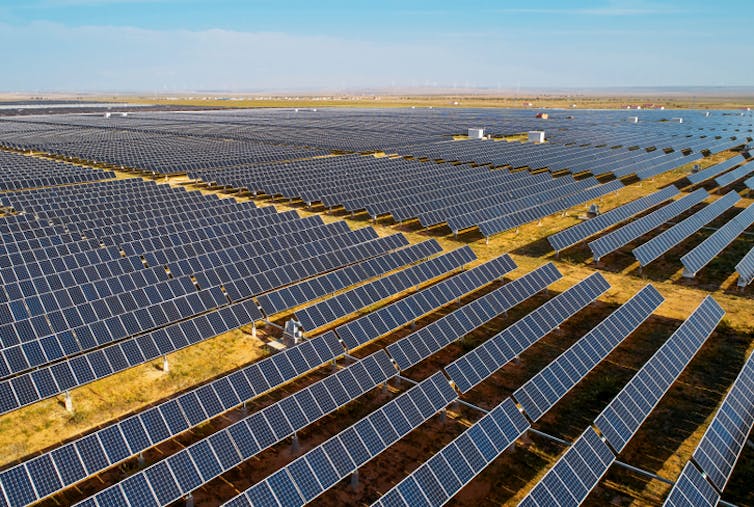
Last year, the world built more new solar capacity than every other power source combined.
Solar is now growing much faster than any other energy technology in history. How fast? Fast enough to completely displace fossil fuels from the entire global economy before 2050.
The rise and rise of cheap solar is our best hope for rapidly mitigating climate change.
Total solar capacity tipped over 1 terawatt (1,000 gigawatts) for the first time last year. The sector is growing at around 20% a year. If this continues, we’ll hit 6 terawatts around 2031. In capacity terms, that would be larger than the combined total of coal, gas, nuclear and hydro.
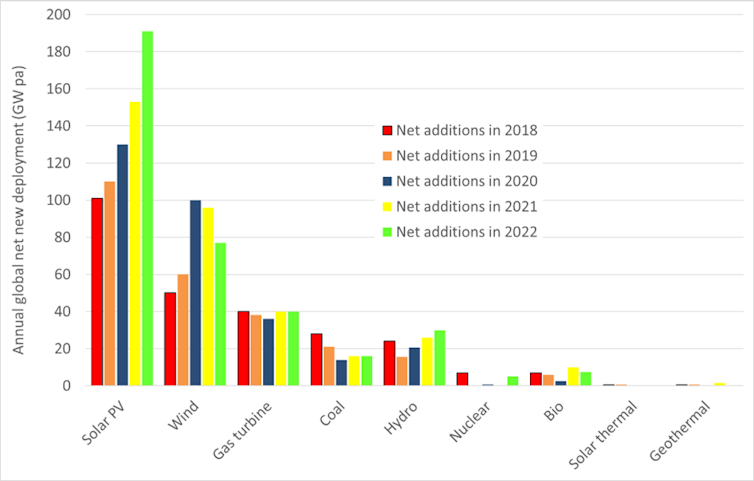
Fewer and fewer new fossil fuel power stations are now being built. As the rest of the global fleet age, most will retire by mid-century.
Australia Is Finding The Path
It might surprise you to learn that Australia is a global renewable energy pathfinder. Most solar panels use Australian-developed PERC technology, for instance.
All the leading countries for per capita solar and wind generation are in Europe – except Australia. In Australia, 99% of new generation capacity is now solar and wind because it is cheap.
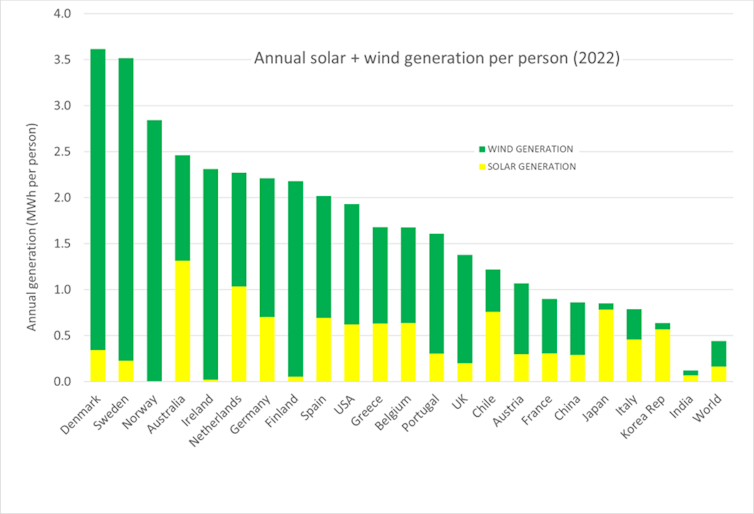
But unlike European countries, Australia cannot share electricity across national boundaries.
Instead, we have to cope with rapidly increasing levels of solar and wind by sharing it across state boundaries. This is proving to be relatively straightforward. Solar and wind have reached a share of 31% of the national electricity market, while the grid remains stable.
Already, three states or territories are at very high penetration of renewables. The ACT has built or bought enough renewables to cover 100% of its use. Tasmania, too, is at 100% renewable power, thanks to hydro and wind, and is aiming to double this to export to other states. And South Australia will soon become the world’s first gigawatt-scale grid to run on renewables. Currently, it’s sourcing around 70% of its power from solar and wind.
This matters because of Australia’s location. Like 80% of the world’s population, we live at low to moderate latitudes where there is plentiful sunshine, even in winter. That means the methods we pioneer or test can be readily adopted by nearly everyone else.
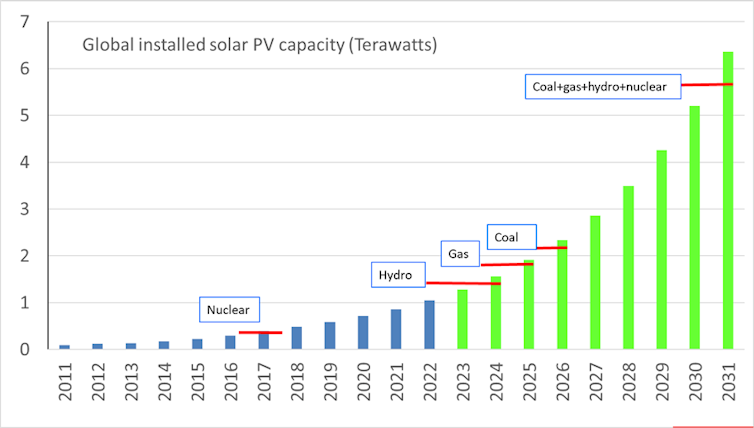
Where Will The Era Of Ubiquitous Solar Take Us?
Solar capacity has been growing at 20% a year for decades.
Elimination of fossil fuels from the global economy is straightforward: electrify everything using clean electricity from solar and wind. This includes:
- electric vehicles replacing conventional vehicles
- electric heat pumps replacing gas space and water heaters in homes and businesses
- electric furnaces replacing gas burners in factories
- electrolysis of water producing green hydrogen for the chemical industry, allowing for clean production of ammonia, metals, plastics and synthetic aviation fuel.
To run our homes, industries and vehicles with electricity, we’ll need to double electricity production. Why not more? Because electricity is usually much more efficient at producing an energy outcome. For example, 85% of the petrol you put into your car is wasted as heat.
In countries with a significant chemical industry, electricity production might need to triple.
If these trends continue, by mid-century we will be in a very different – and better – energy world.
Many developing countries – including population giants such as Indonesia, India, China and Nigeria – could catch up with Europe or Australia for per capita energy consumption. Given electricity consumption is strongly correlated with affluence, access to cheap electricity will be a major boon for many nations.
But Is It Possible?
By 2050, Earth will have a population of about 10 billion people. To supply everyone with enough electricity to live a good life, we’ll need about 200 billion megawatt-hours per year (equal to 200,000 terawatt-hours per year).
Let’s assume that solar does the heavy lifting for decarbonisation, completing two-thirds of the task with the remaining one-third left to wind, hydro and everything else put together. Is it possible?
Yes. If sustained, solar’s growth rate of 20% per year is easily fast enough to reach 80 terawatts of installed capacity in 2050 – enough to provide 130,000 terawatt-hours per year and (with help from wind) to entirely decarbonise an affluent world.
That would see global electricity consumption reach 20 megawatt-hours per person per year – double Australia’s current consumption per person.
As well as eliminating most greenhouse emissions, we will also get rid of car exhausts, smokestacks, urban smog, coal mines, ash dumps, oil spills, oil-related warfare and gas fracking.
The main short-term bottlenecks are likely to be building enough transmission lines – and ensuring we have enough engineers and installers.
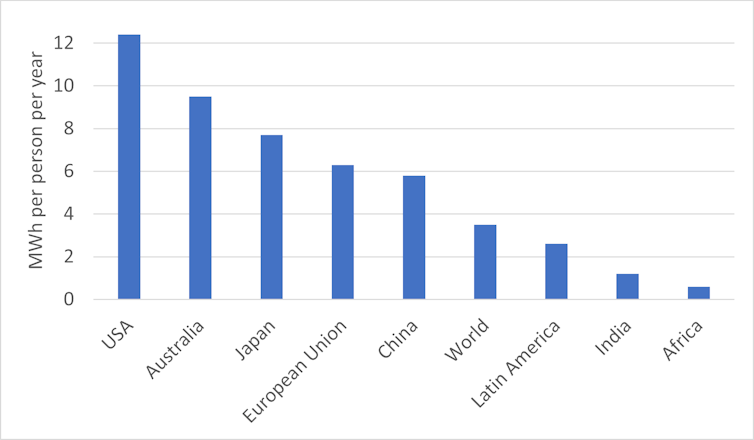
We Have The Space And The Raw Materials
Long term, there are practically no constraints on vast deployment of solar.
The sun will shine for billions more years. Raw materials for solar panels are abundant – silicon from sand and common metals like steel. There are no toxic metals or no critical materials like cobalt in them, and they are highly recyclable. Energy storage is now a solved problem.
Most countries have vastly more solar and wind resources than needed to be energy self-sufficient. This, in turn, will boost their resilience in the face of war, pandemics and the changing climate.
Densely populated regions without much free land such as Japan, Europe and the northeastern United States have enormous offshore wind resources, while Indonesia and west Africa have enormous offshore solar resources – picture solar farms floating on calm tropical seas.
We have plenty of space. Eighty terawatts of solar translates to 8 kilowatts per person. This is the size of a typical Australian rooftop solar system, which is usually shared by a family rather than an individual.
The required area of solar panel is about five square metres per kilowatt (40 square metres total for 8 kilowatts). Some of the panels will be on house roofs. Others will be on ground-mounted solar trackers and operated alongside agriculture. Some crops and grass like the partial shade given by panels. Other options include floating on lakes and seas.
For our energy intensive lives in Australia, we’ll need perhaps 15 kilowatts of solar and wind per person, which run reliably for 30 years and can then be dissembled and recycled.
In the 1950s, nuclear energy advocates talked of a future when energy was too cheap to meter. That didn’t happen with nuclear. But solar offers cheap, unlimited energy, available forever with minimal resource, environmental and social constraints.![]()
Andrew Blakers, Professor of Engineering, Australian National University
This article is republished from The Conversation under a Creative Commons license. Read the original article.
Check your tyres: you might be adding unnecessary microplastics to the environment
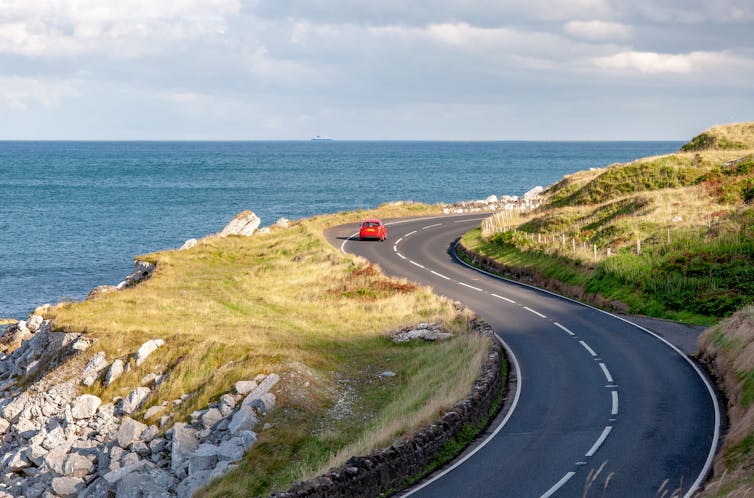
Cost-saving measures are key in today’s economic climate. But they can also have a positive impact on minimising your environmental footprint. A prime example is maintaining your cars’ optimal tyre pressure.
Over time, tyres naturally lose pressure – typically by around 1 psi a month. As pressure decreases, the tyre becomes flatter, causing increased friction between the road and the tyre itself. This heightened friction results in greater drag, reducing the lifespan of your tyre and meaning more fuel is needed for travel.
But driving with flatter tyres also increases the number of tyre wear particles that are released into the environment. These particles – less than a millimetre in size – have been classified as microplastics due to their chemical makeup.
Tyre wear stands out as a major source of microplastic pollution. Globally, each person is responsible for around 1kg of microplastic pollution from tyre wear released into the environment on average each year – with even higher rates observed in developed nations.
It is estimated that between 8% and 40% of these particles find their way into surface waters such as the sea, rivers and lakes through runoff from road surfaces, wastewater discharge or even through airborne transport.
However, tyre wear microplastics have been largely overlooked as a microplastic pollutant. Their dark colour makes them difficult to detect, so these particles can’t be identified using the traditional spectroscopy methods used to identify other more colourful plastic polymers.
To understand the extent of tyre wear pollution, scientists have instead had to figure out ways to identify the chemicals that are associated with tyres in water samples. Using these methods, tyre wear chemicals have been found in 97% of river and estuary samples tested in Europe, the US and Japan.
And yet, we still know relatively little about the effects of tyre wear pollutants on the health of marine animals. This is what my colleagues and I set out to discover in a recent study.
Filter Feeders
Our study focused on two species common to estuaries in the north-east Atlantic – a bivalve called the peppery furrow shell and the ragworm. The bivalve feeds by filtering organic particles from the water and sediment.
The worm is primarily carnivorous, eating small creatures that live on the seafloor, but it also obtains some of its food from seawater and sediment. Both animals are likely to be exposed to tyre wear particles and the potential toxins they contain.
We carried out two experiments. In the first, we exposed these animals to high concentrations of tyre particles (10%) mixed into the sediment they burrow in for three days to see whether they ingested them. We then dissected the animals and counted any tyre particles within their gastrointestinal tract.
Because the tyre particles are rubbery, and could be compressed with a needle, we were able to analyse them under a microscope. We found that the worms only consumed small concentrations of tyre particles (at most 33).
By contrast, the bivalves had large quantities of both sediment and tyre particles in their stomachs – one bivalve had consumed over 1,000 tyre particles.
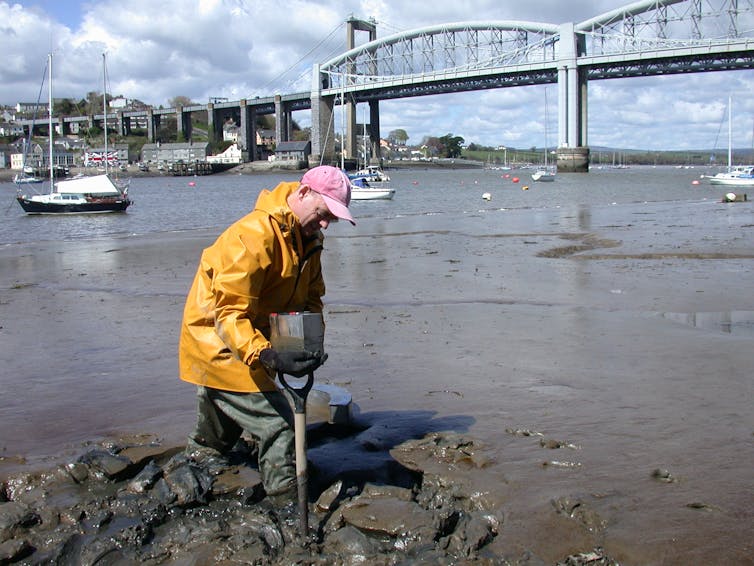
In the second experiment, we exposed the animals to three concentrations of tyre particles (0.2%, 1% and 5%) mixed into the sediment for three weeks. We did this to understand how this exposure affected their health.
We measured a number of health indicators, ranging from cellular to organism level. Bivalve health was affected at all of the concentrations tested, with feeding and burrowing impaired even at low concentrations (0.2%). At a high concentration (5%), we observed a decrease in protein content and an increase in oxidative stress.
Oxidative stress occurs when there are too many unstable molecules called free radicals in the body. These free radicals can lead to cell and tissue damage.
At low concentrations, the health of the worm was not affected. But we did observe a decrease in protein and energy content and signs of oxidative stress as exposure to tyre wear particles increased.
Should We Be Concerned?
Concentrations of tyre wear particles as high as 5% are unlikely in the natural environment. But our results are still worrying, particularly as the time in which the animals were exposed to the particles was short. The observed decrease in bivalve feeding and burrowing at low concentrations suggests exposure to tyre wear microplastics in the wild will significantly impact this species.
Any decline in the health of these species could have a knock on effect on the wider marine ecosystem. Burrowing animals, like the bivalve, play crucial roles in recycling nutrients and enhancing photosynthesis. They are also an important food source for larger animals including birds, fish and crabs.
There is evidence that some of the chemicals that leach from these particles are toxic to marine animals. Research shows that they can reduce phytoplankton growth and harm the health of mussels.
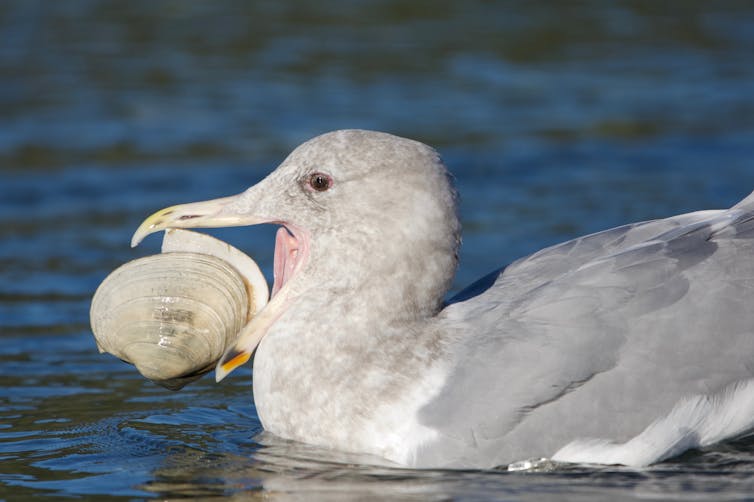
The chemical make-up of tyres varies depending on brand and car model – subsequently, toxicity will vary too. In the future, the complex mixture of components that go into the production of tyres must be risk assessed more rigorously.
The chemicals that are found to have a negative impact on human and environmental health should then be substituted or removed, thereby reducing the impact of these microplastics in the environment.
Until then, there are several simple things you can do to help. These include maintaining the correct tyre pressure, avoiding sharp braking or acceleration and reducing your vehicle load. All of these will reduce the amount of microplastics that your car releases into the environment.![]()
Samantha Garrard, Marine Ecosystem Services Researcher, Plymouth Marine Laboratory
This article is republished from The Conversation under a Creative Commons license. Read the original article.
Methane must fall to slow global heating – but only 13% of emissions are actually regulated

Methane – a potent greenhouse gas and the second biggest driver of global warming after carbon dioxide (CO₂) – had its moment in the spotlight in 2021. Over 100 countries signed on to the Global Methane Pledge to cut emissions by 30% compared to 2020 levels by 2030.
This is a useful goal, but our new research shows that something is still missing: stringent policies to eliminate methane emissions.
Our study is the first global review of methane policies which have been adopted across the world since the 1970s. It reveals that only around 13% of man-made methane emissions from the biggest sources (agriculture, energy and waste) is regulated by policies capable of controlling and preventing them.
This falls to 10% if we take a conservative view of the total emissions and regions covered by specific policies and whether they have been fully or partially implemented.
These policies may mandate companies to find and fix methane leaks, install equipment which can capture emissions, charge them for every unit of methane released or reward them for making use of methane, like extracting biogas from rotting food and other organic waste. Our study showed that the majority (70%) of policies have been adopted in the US and Europe.
Methane is over 80 times more powerful in trapping heat in Earth’s atmosphere than CO₂ but lasts for a much shorter time. Since methane in the air breaks down within about a decade (compared to centuries for CO₂), phasing out emissions could rapidly reduce the rate at which the planet is heating.
For any hope of meeting global climate targets, deep methane reductions are needed immediately. Our research shows that countries which have committed to deep cuts must now expand and strengthen policies for eliminating their emissions. The remaining countries should step up their efforts on methane too.
Regulation Varies By Sector
We systematically examined policies which have been introduced in 79 countries to reduce methane emissions across farming, solid and liquid waste management and the energy sectors (including the extraction, transportation and consumption of fossil fuels – coal, oil and gas).
Motivations for regulating methane varied. Not only does the gas contribute to climate change, but it can also generate tropospheric ozone – a harmful air pollutant. Methane is also a safety hazard if its concentration in the air reaches an explosive range (5-15%).
But if it is captured, methane becomes a source of energy as the major component of natural gas. And so regulating methane, for example by incentivising the capture of methane from coalbeds, can be cheap and useful.
How effective such policies have been is far from clear though, as countries do not tend to quantify their emissions using direct measurements.
Regulations are more frequently used to address fossil (oil, gas and coal) rather than biogenic (livestock, solid and liquid waste) sources of methane. In fact, 41% of all policies targeted methane from coal mines and oil refineries, compared with 25% for farms and landfills.
Taxes and charges, on the quantities of waste for example, are more common for regulating biogenic sources whereas financial incentives, like feed-in tariffs for electricity generated from captured coal mine methane, are more frequently used in fossil methane policies.
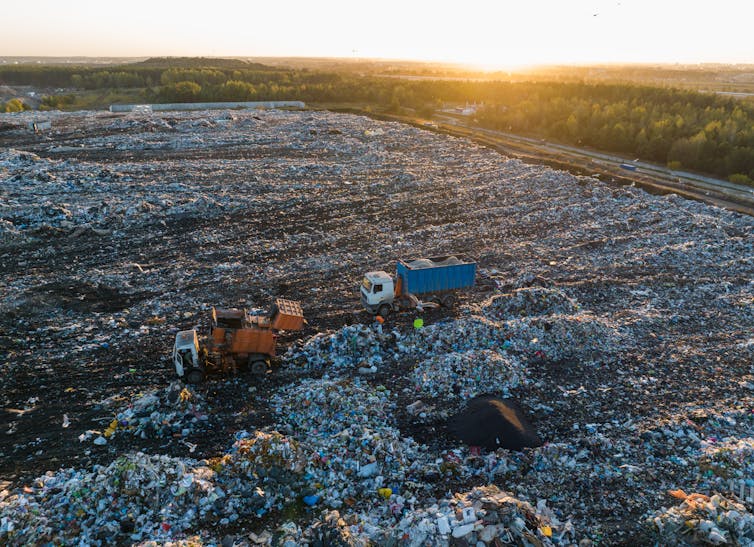
Policies targeting methane emissions from the oil and gas sector tend to be more stringent than those targeting coal mines. Similarly, policies targeting methane emissions from solid and liquid waste are more stringent than those addressing livestock emissions.
These divergent approaches to regulating different methane sources may be the result of opposition from the fossil fuel and agricultural industries. The relative importance of these industries to national and regional economies and energy and food supply may also explain why government regulation has so far proved inadequate.
Where Regulation Must Improve
More stringent policies and a consistent approach for quantifying how much methane is being emitted from each source will be key to bringing regulation in line with global commitments.
Improving the monitoring of methane emissions is particularly important for enabling deeper cuts. Historically, methane emissions have been difficult and costly to measure, partly because it is an invisible gas and compared to CO₂, only minor emissions cause substantial warming.
However, methane reduction is still often perceived by policymakers as a choice rather than a necessary complement to ongoing decarbonisation efforts focused on CO₂.
Within almost every sector there are major methane sources that have been largely overlooked. These include the digestive gases of cows and other livestock, methane from the ventilation shafts of coal mines, high-emitting sources in the oil and gas sector (so called super-emitters), and from abandoned mines and oil and gas wells.
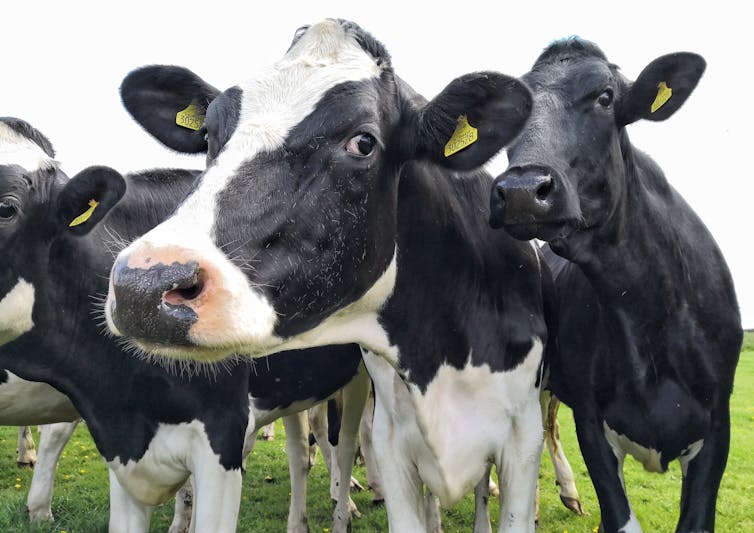
In the energy sector, emissions from non-operated joint ventures are particularly neglected by regulation. This is a type of business structure where a company owns an equity interest without assuming day-to-day operational control.
These are usually owned by major oil and gas companies, but operated by local partners – national oil and gas firms in developing countries are a prime example. Supply chains are another important source, particularly with internationally-traded commodities like liquefied natural gas (LNG) and coking coal used in steelmaking.
In the oil and gas sector, where methane may be more cost-effective to reduce because the captured gas could be monetised, global commitments like the Paris Agreement require the industry’s own emissions to fall alongside falling demand for fossil fuels across all economies.
As Dr Fatih Birol, executive director of the International Energy Agency, recently put it, the next UN climate change conference (COP28) in the United Arab Emirates will be “a moment of truth” for both oil- and gas-rich countries and the industries exploiting these climate-damaging fuels.

Don’t have time to read about climate change as much as you’d like?
Get a weekly roundup in your inbox instead. Every Wednesday, The Conversation’s environment editor writes Imagine, a short email that goes a little deeper into just one climate issue. Join the 10,000+ readers who’ve subscribed so far.![]()
Maria Olczak, PhD Candidate, School of Engineering and Materials Science, Queen Mary University of London; Andris Piebalgs, Part-time Professor, Florence School of Regulation, European University Institute, and Paul Balcombe, Senior Lecturer in Chemical Engineering and Renewable Energy, Queen Mary University of London
This article is republished from The Conversation under a Creative Commons license. Read the original article.
Saving humanity: here’s a radical approach to building a sustainable and just society

Collectively we are driving Earth and civilisation towards collapse. Human activities have exceeded planetary boundaries. We are changing the climate, losing biodiversity, degrading land, contaminating freshwater, and damaging the nitrogen and phosphorus cycles upon which we all depend.
We ask how this could happen. Also, why democratically elected governments ignore the wishes of the majority of their people. Why some governments continue to export fossil fuels despite commitments to climate mitigation. Why some go to war in distant lands without any debate in parliament or congress. Why some give tax cuts to the rich while those on the dole struggle below the poverty line.
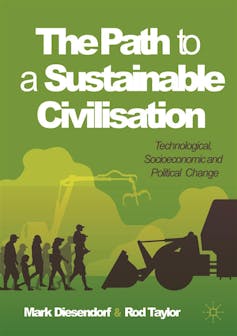
The answers to these questions all come down to one thing: decision-makers and influencers are captured by vested interests. That is the inconvenient truth revealed in our new book, The Path to a Sustainable Civilisation: Technological, Socioeconomic and Political Change. But these forces can be overthrown.
We argue it is not sufficient for citizen organisations and governments to address specific environmental, social justice and peace issues. It’s certainly necessary, but we must also struggle for systemic change. This means challenging the covert driving forces of environmental destruction, social injustice and war, namely, “state capture” and the dominant economic system.
It’s 90 seconds to midnight on the Doomsday Clock, so there’s no time to waste.
Confronting State Capture
Political scientists and political economists argue governments, public servants, the media and indeed the majority of decision-makers and influencers become captured by vested interests.
This is known as state capture, where state means the nation-state. The captors include fossil fuel, armaments, finance, property and gambling industries.
State capture can also involve foreign governments. There is justifiable concern in Australia and elsewhere about subversion by the Chinese Communist Party.
Yet there is little discussion of the fact that, since 2015, six “retired” US admirals worked for the Australian government before the AUKUS announcement on nuclear powered submarines.
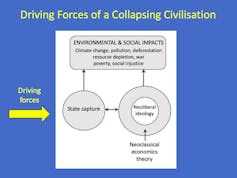
State capture could explain why Australia’s defence is being shifted to the South China Sea under US sovereignty.
Confronting state capture involves reversing several undemocratic practices. Of particular concern is the funding of political parties by corporate interests as well as the revolving-door jobs between government and corporate interests.
There is also the concentration of media ownership and the influence of so-called “think tanks” funded by vested interests.
The first step is to set up coalitions or networks to oppose the power of vested interests. This would bring together diverse civil society organisations with common interests in democratic integrity and civil liberties.
One example is the Australian Democracy Network, which campaigns for “changes that make our democracy more fair, open, participatory, and accountable”. The Network was founded in 2020 by the Human Rights Law Centre, the Australian Conservation Foundation and the Australian Council of Social Service.
Challenging Economic Ideology
Conventional economic theory failed us when it came to recovery from the Global Financial Crisis of 2007–09 and the COVID pandemic. Nevertheless, many governments still accept its prescriptions.
The dangerous and destructive myths of conventional economics include the claims that:
- economic theory can treat the natural environment as an infinite resource and infinite waste dump
- endless economic growth on a finite planet is feasible and desirable
- wealth trickles down from the rich to the poor
- wellbeing and welfare can be measured by GDP
- government intervention in the market must be avoided.
Although these myths have been refuted many times, even by world famous economist Joseph Stiglitz, they still determine much government policy.
Australian economist Steve Keen first published Debunking economics in 2001. The financial crisis of 2007 gave him plenty of material for a revised edition in 2011. Richard Denniss gave us Econobabble: How to Decode Political Spin and Economic Nonsense in 2021. Yet, as John Quiggin so eloquently puts it, dead ideas still stalk the land (Zombie Economics.
They have devastating impacts on our life support system (the biosphere) and social justice. One of the principal destroyers of our planet is excessive consumption, especially consumption by rich individuals and rich countries.
A more appropriate economic framework for human and planetary wellbeing is the interdisciplinary field of ecological economics.
Unlike neoclassical economics, ecological economics gives priority to ecological sustainability and social justice over economic efficiency. It works towards a transition to a steady-state economy. That is, one with no global increase in the use of energy, materials and land, and no increase in population.
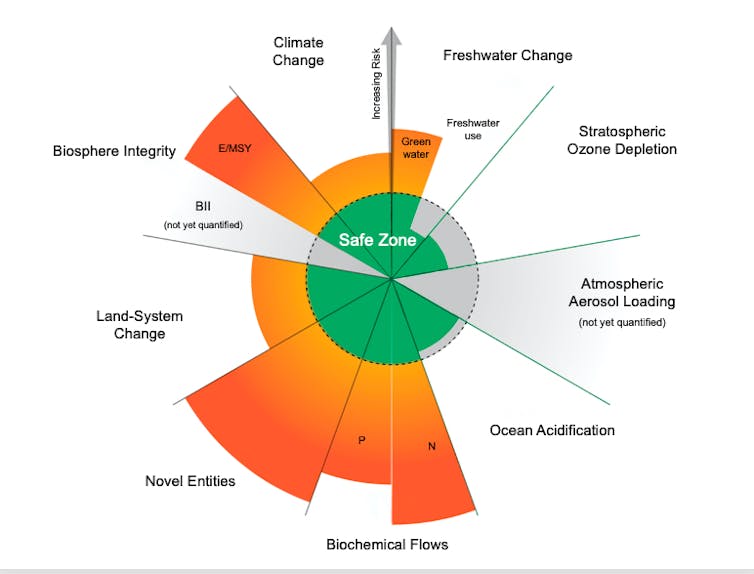
Since planetary boundaries have already been exceeded and low-income countries must develop, social justice demands that the rich countries undergo planned degrowth.
On the pathway to a sustainable civilisation, environmental protection and social justice must be addressed together. Because the rich are responsible for the biggest environmental impacts, reducing the gap between rich and poor is critical.
Universal basic services such as improved public health, education, housing and transportation – and a government-funded job guarantee – can achieve greater equality and give people incentives to support the transition.
Citizen Action
Why would governments free themselves from state capture and discard economics ideology? Former US President Franklin D. Roosevelt once told a delegation: “OK, you have convinced me. Now get out there and make me do it!” In other words, pressure from voters is needed to make government action politically feasible.
That’s why we need citizen-based environmental, social justice, public health and peace groups to form alliances to challenge the overarching issues of state capture and flawed economics ideology.![]()
Mark Diesendorf, Honorary Associate Professor, UNSW Sydney
This article is republished from The Conversation under a Creative Commons license. Read the original article.
Fixing broken flood gauges is important. But most of us don’t evacuate even when we know the water is coming
Mel Taylor, Macquarie University; Fiona Miller, Macquarie University, and Kat Haynes, University of WollongongDevastating floods have hit community after community on Australia’s eastern seaboard over the last three years. Weather systems were dynamic and difficult to forecast.
What made the impact worse still was the fact that many of our flood gauges were unreliable or broken. In some cases, residents simply didn’t know the extent of the floodwaters rushing toward them.
As a resident of a flood-hit New South Wales town told us:
During that second flood we knew that gauge was wrong. It was wrong by metres. On the night of the February flood, very few people could sleep […] I remember looking at [warnings] and I’m thinking ‘What? How can that be?’
New federal funding for a better flood warning network is wise. But flood gauges are only one part of a total warning system. Social factors also require consideration.
Gathering Better Data To Improve Flood Warnings
Public money (A$236 million) will be used to upgrade or purchase flood gauges for high priority catchments, replacing infrastructure found to be unreliable or broken.
We’ve known there were problems with our flood warning infrastructure for years.
But these issues came to a head during the widespread flooding in the first half of 2022 when communities were misled, confused or wrong-footed by unreliable information. Subsequent inquiries in New South Wales and Queensland found major issues and recommended the federal government take responsibility for building and maintaining the flood warning network.
We’ve long known that early warning systems boost public safety and reduce deaths. They cut financial losses and make possible earlier planning and responses by emergency services.
But by themselves, they are not enough. Some people will leave when warned, but others due to a range of social and economic factors, are either unable to leave or choose to stay. That’s why we need social supports alongside warning systems.
In our recent research, we interviewed almost 200 NSW and Queensland residents affected by floods in early to mid 2022 and surveyed 430 others.
People told us they relied heavily on river gauge data – when it was available and working. But when the gauges were broken or giving incorrect data, residents were left worried and confused.
Longtime residents in low-lying rural areas and in some upper catchment areas often had a good understanding of how rain and stormwater behaved in their landscape and how that translated to flooding. When they shared this knowledge on community social media pages, it was highly valued by many other residents, who used it to help interpret gauge data and river heights.
What Matters Is How People Respond To Warnings
It’s clearly important to give people warning about the size and timing of a flood which may affect them. Successful warnings are those which are accurate and timely, relevant to the specific area, motivate people to evacuate, if need be, and lead to reduced loss of life and property.
But even when warnings are received in time, research shows they’re unlikely to actually motivate safe, timely evacuation by most of the people at risk.
Our own research found over 60% of surveyed residents did not evacuate.
Why did people stay? It wasn’t for lack of timely warnings, for the most part.
For some, staying was the plan. Many had stayed in previous floods and had been safe. Others stayed to lift up their belongings, protect against looting and start the clean-up quickly after the waters receded. Some stayed to look after less mobile dependants, care for pets and livestock, or because they had nowhere else to go.
After the 2017 NSW floods, researchers found a similar approach of sheltering in place in some locations.
The problem is, previous floods are now no longer a reliable guide. Climate change is leading to more intense rain and more extreme floods. Choosing to stay because you were safe last time is no guarantee.
We Need Better Supports
Given that many people choose to stay, we must do more to help people make the decision to evacuate and ensure those who are determined to shelter, or have no other choice, are better prepared to do so safely.
Each of us has a social context which greatly shapes our ability to act on information. Life might be complex or chaotic due to precarious housing, limited finances, poor health, caring responsibilities, or a lack of community connections. These social factors may make any of us reluctant – or simply unable – to act on warnings and prepare or evacuate.
For instance, one interviewee told us:
I am reliant on support workers to access the community, and due to the rising waters in outer suburbs the supports I had were unable to physically get to me.
Another said:
I was pregnant at the time and couldn’t do the heavy lifting required. [I] didn’t have the vehicle space to load things to remove from the property.
Warnings Are Not A Guarantee Of Safety
Yes, it’s good the federal government is introducing a better way to monitor floods and warn people who live near affected creeks and rivers. But providing a warning is only part of the puzzle. We need many solutions that work together.
Sometimes warnings don’t get through. Sometimes disasters escalate rapidly. Sometimes people can’t or won’t take action. Warnings alone do not produce community resilience, but they can help.
As we brace for a future where natural hazards intensify, we need more resilience.
For floods, that means focusing on community connections, education, health and livelihoods, as well as land use planning and building design that reduces exposure to flood risk in the first place. We also need technical solutions like warning systems. Together, this will lead to a more resilient future.
The authors would like to acknowledge their fellow researchers on this project: Professor Kim Johnston, Associate Professor Anne Lane, Dr Barbara Ryan, Dr Harriet Narwal, Madeleine Miller, Helga Simon, and Dipika Dabas.![]()
Mel Taylor, Associate Professor, Macquarie University; Fiona Miller, Associate professor, Macquarie University, and Kat Haynes, Hononary Fellow, University of Wollongong
This article is republished from The Conversation under a Creative Commons license. Read the original article.
New study helps solve a 30-year-old puzzle: how is climate change affecting El Niño and La Niña?
Wenju Cai, CSIRO and Agus Santoso, UNSW SydneyHuman-caused greenhouse gas emissions mean strong El Niño and La Niña events are occurring more often, according to our new research, which provides important new evidence of the human fingerprint on Earth’s climate.
For more than 30 years, climate researchers have puzzled over the link between human-caused climate change and El Niño and La Niña events. We set out to bridge this knowledge gap.
Climate scientists have long observed a correlation between climate change impacts on our oceans and atmosphere, and the increase in greenhouse gas emissions from human activity.
Our research examined when this activity may have started to make El Niño and La Niña events more extreme. Our deep analysis found a relationship between human-caused greenhouse gas activity and changes to El Niño and La Niña.
Our findings were five years in the making. They help us understand how El Niño and La Niña will change as the world warms in the future.
What Are El Niño And La Niña?
La Niña typically brings wet, cooler conditions to much of Australia. Every few years it alternates with an El Niño, which typically brings drier, hotter conditions. Together, the two phases are known as the El Niño-Southern Oscillation.
The events are driven by changes in sea-surface temperature in the tropical Pacific Ocean. During an El Niño, the surface temperature is warmer than usual. During a La Niña, it’s colder than usual.
Small changes in sea-surface temperature can lead to big changes in the atmosphere. That’s how El Niño and La Niña events can so dramatically affect weather patterns around the world.
The El Niño-Southern Oscillation is naturally occurring. But over the last 50 years or so, strong El Niño and La Niña events have occurred more often. Was climate change playing a role? Our research set out to answer this question.
Unpicking Climate ‘Variability’
So how might climate change affect the development of El Niño and La Niña?
Decades of observations of climate change show sea surface temperatures are warming. In many oceans across the world, including the Pacific, this has caused the sea surface to warm faster than the water below.
We wanted to understand what impact this warming had on the El Niño-Southern Oscillation in the past century.
Our research analysed several simulations produced by 43 “climate models”, or computer simulations of Earth’s climate system.
First, we compared simulations from between 1901-1960 with those from 1961-2020. Most results showed an increase in the “variability” of the El Niño-Southern Oscillation since 1960.
Variability refers to a departure from the average. In this case, our results show strong El Niño and La Niña events have occurred more frequently than average since 1960. This finding is consistent with observations over the same periods.
We then examined climate simulations over hundreds of years before humans started ramping up greenhouse gas emissions, and compared these to the simulations after 1960.
This analysis showed even more clearly the very strong variability in the El Niño-Southern Oscillation after 1960. This reinforces the finding that human-caused greenhouse gas emissions are the culprit.
The strong variability has contributed to more extreme and frequent droughts, floods, heatwaves, bushfires and storms around the world.
So What’s Next?
Previous research suggests the El Niño-Southern Oscillation will continue to change this century. In particular, we can expect more intense and frequent El Niño and La Niña events.
We can also expect more frequent swings from a strong El Niño to a strong La Niña the following year.
These predictions apply to various emission scenarios. Even if greenhouse gas emissions were slashed and global warming was kept to 1.5℃, as per the goal of the Paris Agreement, we can expect more frequent strong El Nino events for another century. That’s because the Pacific Ocean holds a lot of heat, which will take several decades to dissipate.
Of course, variability in the El Niño-Southern Oscillation is already making itself felt. Think back to the extreme El Niño of 2015, which led to drought across much of Australia. And of course, a rare “triple” La-Nina from 2020 to 2022 led to severe flooding in eastern Australia.
An El Niño may develop later this year. As climate change worsens, we must prepare for many more of these potentially damaging climate events.![]()
Wenju Cai, Chief Research Scientist, Oceans and Atmosphere, CSIRO, CSIRO and Agus Santoso, Senior Research Associate, UNSW Sydney
This article is republished from The Conversation under a Creative Commons license. Read the original article.
Pittwater Reserves: Histories + Notes + Pictorial Walks
A History Of The Campaign For Preservation Of The Warriewood Escarpment by David Palmer OAM and Angus Gordon OAM
A Stroll Through Warriewood Wetlands by Joe Mills February 2023
A Walk Around The Cromer Side Of Narrabeen Lake by Joe Mills
America Bay Track Walk - photos by Joe Mills
An Aquatic June: North Narrabeen - Turimetta - Collaroy photos by Joe Mills
Angophora Reserve Angophora Reserve Flowers Grand Old Tree Of Angophora Reserve Falls Back To The Earth - History page
Annie Wyatt Reserve - A Pictorial
Avalon's Village Green: Avalon Park Becomes Dunbar Park - Some History + Toongari Reserve and Catalpa Reserve
Bairne Walking Track Ku-Ring-Gai Chase NP by Kevin Murray
Bangalley Headland Bangalley Mid Winter
Banksias of Pittwater
Barrenjoey Boathouse In Governor Phillip Park Part Of Our Community For 75 Years: Photos From The Collection Of Russell Walton, Son Of Victor Walton
Barrenjoey Headland: Spring flowers
Barrenjoey Headland after fire
Bayview Baths
Bayview Wetlands
Beeby Park
Bilgola Beach
Botham Beach by Barbara Davies
Bungan Beach Bush Care
Careel Bay Saltmarsh plants
Careel Bay Birds
Careel Bay Clean Up day
Careel Bay Playing Fields History and Current
Careel Creek
Careel Creek - If you rebuild it they will come
Centre trail in Ku-ring-gai Chase National Park
Chiltern Track- Ingleside by Marita Macrae
Clareville Beach
Clareville/Long Beach Reserve + some History
Coastal Stability Series: Cabbage Tree Bay To Barrenjoey To Observation Point by John Illingsworth, Pittwater Pathways, and Dr. Peter Mitchell OAM
Cowan Track by Kevin Murray
Curl Curl To Freshwater Walk: October 2021 by Kevin Murray and Joe Mills
Currawong and Palm Beach Views - Winter 2018
Currawong-Mackerel-The Basin A Stroll In Early November 2021 - photos by Selena Griffith
Currawong State Park Currawong Beach + Currawong Creek
Deep Creek To Warriewood Walk photos by Joe Mills
Drone Gives A New View On Coastal Stability; Bungan: Bungan Headland To Newport Beach + Bilgola: North Newport Beach To Avalon + Bangalley: Avalon Headland To Palm Beach
Duck Holes: McCarrs Creek by Joe Mills
Dunbar Park - Some History + Toongari Reserve and Catalpa Reserve
Dundundra Falls Reserve: August 2020 photos by Selena Griffith - Listed in 1935
Elsie Track, Scotland Island
Elvina Track in Late Winter 2019 by Penny Gleen
Elvina Bay Walking Track: Spring 2020 photos by Joe Mills
Elvina Bay-Lovett Bay Loop Spring 2020 by Kevin Murray and Joe Mills
Fern Creek - Ingleside Escarpment To Warriewood Walk + Some History photos by Joe Mills
Iluka Park, Woorak Park, Pittwater Park, Sand Point Reserve, Snapperman Beach Reserve - Palm Beach: Some History
Ingleside
Ingleside Wildflowers August 2013
Irrawong - Ingleside Escarpment Trail Walk Spring 2020 photos by Joe Mills
Irrawong - Mullet Creek Restoration
Katandra Bushland Sanctuary - Ingleside
Lucinda Park, Palm Beach: Some History + 2022 Pictures
McCarrs Creek
McCarr's Creek to Church Point to Bayview Waterfront Path
McKay Reserve
Mona Vale Beach - A Stroll Along, Spring 2021 by Kevin Murray
Mona Vale Headland, Basin and Beach Restoration
Mona Vale Woolworths Front Entrance Gets Garden Upgrade: A Few Notes On The Site's History
Mount Murray Anderson Walking Track by Kevin Murray and Joe Mills
Mullet Creek
Narrabeen Creek
Narrabeen Lagoon Catchment: Past Notes Present Photos by Margaret Woods
Narrabeen Lagoon State Park
Narrabeen Lagoon State Park Expansion
Narrabeen Rockshelf Aquatic Reserve
Nerang Track, Terrey Hills by Bea Pierce
Newport Bushlink - the Crown of the Hill Linked Reserves
Newport Community Garden - Woolcott Reserve
Newport to Bilgola Bushlink 'From The Crown To The Sea' Paths: Founded In 1956 - A Tip and Quarry Becomes Green Space For People and Wildlife
Pittwater Reserves: The Green Ways; Bungan Beach and Bungan Head Reserves: A Headland Garden
Pittwater Reserves, The Green Ways: Clareville Wharf and Taylor's Point Jetty
Pittwater Reserves: The Green Ways; Hordern, Wilshire Parks, McKay Reserve: From Beach to Estuary
Pittwater Reserves - The Green Ways: Mona Vale's Village Greens a Map of the Historic Crown Lands Ethos Realised in The Village, Kitchener and Beeby Parks
Pittwater Reserves: The Green Ways Bilgola Beach - The Cabbage Tree Gardens and Camping Grounds - Includes Bilgola - The Story Of A Politician, A Pilot and An Epicure by Tony Dawson and Anne Spencer
Pittwater spring: waterbirds return to Wetlands
Pittwater's Lone Rangers - 120 Years of Ku-Ring-Gai Chase and the Men of Flowers Inspired by Eccleston Du Faur
Pittwater's Parallel Estuary - The Cowan 'Creek
Resolute Track at West Head by Kevin Murray
Resolute Track Stroll by Joe Mills
Riddle Reserve, Bayview
Salvation Loop Trail, Ku-Ring-Gai Chase National Park- Spring 2020 - by Selena Griffith
Seagull Pair At Turimetta Beach: Spring Is In The Air!
Stapleton Reserve
Stapleton Park Reserve In Spring 2020: An Urban Ark Of Plants Found Nowhere Else
Stony Range Regional Botanical Garden: Some History On How A Reserve Became An Australian Plant Park
The Chiltern Track
The Resolute Beach Loop Track At West Head In Ku-Ring-Gai Chase National Park by Kevin Murray
Topham Track Ku-Ring-Gai Chase NP, August 2022 by Joe Mills and Kevin Murray
Towlers Bay Walking Track by Joe Mills
Trafalgar Square, Newport: A 'Commons' Park Dedicated By Private Landholders - The Green Heart Of This Community
Tranquil Turimetta Beach, April 2022 by Joe Mills
Turimetta Beach Reserve by Joe Mills, Bea Pierce and Lesley
Turimetta Beach Reserve: Old & New Images (by Kevin Murray) + Some History
Turimetta Headland
Warriewood Wetlands - Creeks Deteriorating: How To Report Construction Site Breaches, Weed Infestations + The Long Campaign To Save The Warriewood Wetlands & Ingleside Escarpment March 2023
Warriewood Wetlands and Irrawong Reserve
Whale Beach Ocean Reserve: 'The Strand' - Some History On Another Great Protected Pittwater Reserve
Wilshire Park Palm Beach: Some History + Photos From May 2022
Winji Jimmi - Water Maze

Pittwater's Birds
Australian Predators of the Sky by Penny Olsen - published by National Library of Australia
Australian Raven Australian Wood Duck Family at Newport
A Week In Pittwater Issue 128 A Week In Pittwater - June 2014 Issue 168
Baby Birds Spring 2015 - Rainbow Lorikeets in our Yard - for Children Baby Birds by Lynleigh Greig, Southern Cross Wildlife Care - what do if being chased by a nesting magpie or if you find a baby bird on the ground
Baby Kookaburras in our Backyard: Aussie Bird Count 2016 - October
Balloons Are The Number 1 Marine Debris Risk Of Mortality For Our Seabirds - Feb 2019 Study
Bangalley Mid-Winter Barrenjoey Birds Bird Antics This Week: December 2016
Bird of the Month February 2019 by Michael Mannington
Birdland Above the Estuary - October 2012 Birds At Our Window Birds at our Window - Winter 2014 Birdland June 2016
Birdsong Is a Lovesong at This time of The Year - Brown Falcon, Little Wattle Bird, Australian Pied cormorant, Mangrove or Striated Heron, Great Egret, Grey Butcherbird, White-faced Heron
Bird Songs – poems about our birds by youngsters from yesterdays - for children Bird Week 2015: 19-25 October
Bird Songs For Spring 2016 For Children by Joanne Seve
Birds at Careel Creek this Week - November 2017: includes Bird Count 2017 for Local Birds - BirdLife Australia by postcode
Black Cockatoo photographed in the Narrabeen Catchment Reserves this week by Margaret G Woods - July 2019
Black-Necked Stork, Mycteria Australis, Now Endangered In NSW, Once Visited Pittwater: Breeding Pair shot in 1855
Black Swans on Narrabeen Lagoon - April 2013 Black Swans Pictorial
Endangered Little Tern Fishing at Mona Vale Beach
‘Feather Map of Australia’: Citizen scientists can support the future of Australia's wetland birds: for Birdwatchers, school students and everyone who loves our estuarine and lagoon and wetland birds
Fledgling Common Koel Adopted by Red Wattlebird -Summer Bird fest 2013 Flegdlings of Summer - January 2012
Flocks of Colour by Penny Olsen - beautiful new Bird Book Celebrates the 'Land of the Parrots'
Friendly Goose at Palm Beach Wharf - Pittwater's Own Mother Goose
Front Page Issue 177 Front Page Issue 185 Front Page Issue 193 - Discarded Fishing Tackle killing shorebirds Front Page Issue 203 - Juvenile Brush Turkey Front Page Issue 208 - Lyrebird by Marita Macrae Front Page Issue 219 Superb Fairy Wren Female Front Page Issue 234: National Bird Week October 19-25 and the 2015 the Aussie Back Yard Bird Count: Australia's First Bird Counts - a 115 Year Legacy - with a small insight into our first zoos Front Page Issue 236: Bird Week 2015 Front Page Issue 244: watebirds Front Page Issue 260: White-face Heron at Careel Creek Front Page Issue 283: Pittwater + more birds for Bird Week/Aussie Bird Count Front Page Issue 284: Pittwater + more birds for Bird Week/Aussie Bird Count Front Page Issue 285: Bird Week 2016 Front Page Issue 331: Spring Visitor Birds Return
G . E. Archer Russell (1881-1960) and His Passion For Avifauna From Narrabeen To Newport
Glossy Black-Cockatoo Returns To Pittwater by Paul Wheeler Glossy Cockatoos - 6 spotted at Careel Bay February 2018
Grey Butcher Birds of Pittwater
INGLESIDE LAND RELEASE ON AGAIN BUT MANY CHALLENGES AHEAD by David Palmer
Issue 60 May 2012 Birdland - Smiles- Beamings -Early -Winter - Blooms
Jayden Walsh’s Northern Beaches Big Year - courtesy Pittwater Natural Heritage Association
John Gould's Extinct and Endangered Mammals of Australia by Dr. Fred Ford - Between 1850 and 1950 as many mammals disappeared from the Australian continent as had disappeared from the rest of the world between 1600 and 2000! Zoologist Fred Ford provides fascinating, and often poignant, stories of European attitudes and behaviour towards Australia's native fauna and connects these to the animal's fate today in this beautiful new book - our interview with the author
July 2012 Pittwater Environment Snippets; Birds, Sea and Flowerings
Juvenile Sea Eagle at Church Point - for children
King Parrots in Our Front Yard
Kookaburra Turf Kookaburra Fledglings Summer 2013 Kookaburra Nesting Season by Ray Chappelow Kookaburra Nest – Babies at 1.5 and 2.5 weeks old by Ray Chappelow Kookaburra Nest – Babies at 3 and 4 weeks old by Ray Chappelow Kookaburra Nest – Babies at 5 weeks old by Ray Chappelow Kookaburra and Pittwater Fledglings February 2020 to April 2020
Lion Island's Little Penguins (Fairy Penguins) Get Fireproof Homes - thanks to NSW National Parks and Wildlife Service and the Fix it Sisters Shed
Lyre Bird Sings in Local National Park - Flock of Black Cockatoos spotted - June 2019
Magpie's Melodic Melodies - For Children (includes 'The Magpie's Song' by F S Williamson)
Masked Lapwing (Plover) - Reflected
May 2012 Birdland Smiles Beamings Early Winter Blooms
Musk Lorikeets In Pittwater: Pittwater Spotted Gum Flower Feast - May 2020
Nankeen Kestrel Feasting at Newport: May 2016
National Bird Week 2014 - Get Involved in the Aussie Backyard Bird Count: National Bird Week 2014 will take place between Monday 20 October and Sunday 26 October, 2014. BirdLife Australia and the Birds in Backyards team have come together to launch this year’s national Bird Week event the Aussie Backyard Bird Count! This is one the whole family can do together and become citizen scientists...
National Bird Week October 19-25 and the 2015 the Aussie Back Yard Bird Count: Australia's First Bird Counts - a 115 Year Legacy - with a small insight into our first zoos
Nature 2015 Review Earth Air Water Stone
New Family of Barking Owls Seen in Bayview - Church Point by Pittwater Council
Noisy Visitors by Marita Macrae of PNHA
Odes to Australia's Fairy-wrens by Douglas Brooke Wheelton Sladen and Constance Le Plastrier 1884 and 1926
Oystercatcher and Dollarbird Families - Summer visitors
Painted Button-Quail Rescued By Locals - Elanora-Ingleside escarpment-Warriewood wetlands birds
Palm Beach Protection Group Launch, Supporters Invited: Saturday Feb.16th - Residents Are Saying 'NO' To Off-Leash Dogs In Station Beach Eco-System - reports over 50 dogs a day on Station Beach throughout December-January (a No Dogs Beach) small children being jumped on, Native birds chased, dog faeces being left, families with toddlers leaving beach to get away from uncontrolled dogs and 'Failure of Process' in council 'consultation' open to February 28th
Pardalote, Scrub Wren and a Thornbill of Pittwater
Pecking Order by Robyn McWilliam
Pelican Lamps at Narrabeen Pelican Dreamsong - A Legend of the Great Flood - dreamtime legend for children
Pittwater Becalmed Pittwater Birds in Careel Creek Spring 2018 Pittwater Waterbirds Spring 2011 Pittwater Waterbirds - A Celebration for World Oceans Day 2015
Pittwater's Mother Nature for Mother's Day 2019
Plastic in 99 percent of seabirds by 2050 by CSIRO
Plover Appreciation Day September 16th 2015
Powerful and Precious by Lynleigh Grieg
Red Wattlebird Song - November 2012
Restoring The Diamond: every single drop. A Reason to Keep Dogs and Cats in at Night.
Sea Birds off the Pittwater Coast: Albatross, Gannet, Skau + Australian Poets 1849, 1898 and 1930, 1932
Sea Eagle Juvenile at Church Point
Seen but Not Heard: Lilian Medland's Birds - Christobel Mattingley - one of Australia's premier Ornithological illustrators was a Queenscliff lady - 53 of her previously unpublished works have now been made available through the auspices of the National Library of Australia in a beautiful new book
7 Little Ducklings: Just Keep Paddling - Australian Wood Duck family take over local pool by Peta Wise
Shag on a North Avalon Rock - Seabirds for World Oceans Day 2012
Short-tailed Shearwaters Spring Migration 2013
South-West North-East Issue 176 Pictorial
Spring 2012 - Birds are Splashing - Bees are Buzzing
Spring Becomes Summer 2014- Royal Spoonbill Pair at Careel Creek
Spring Notes 2018 - Royal Spoonbill in Careel Creek
Station Beach Off Leash Dog Area Proposal Ignores Current Uses Of Area, Environment, Long-Term Fauna Residents, Lack Of Safe Parking and Clearly Stated Intentions Of Proponents have your say until February 28, 2019
Summer 2013 BirdFest - Brown Thornbill Summer 2013 BirdFest- Canoodlers and getting Wet to Cool off Summer 2013 Bird Fest - Little Black Cormorant Summer 2013 BirdFest - Magpie Lark
New Shorebirds WingThing For Youngsters Available To Download
A Shorebirds WingThing educational brochure for kids (A5) helps children learn about shorebirds, their life and journey. The 2021 revised brochure version was published in February 2021 and is available now. You can download a file copy here.
If you would like a free print copy of this brochure, please send a self-addressed envelope with A$1.10 postage (or larger if you would like it unfolded) affixed to: BirdLife Australia, Shorebird WingThing Request, 2-05Shorebird WingThing/60 Leicester St, Carlton VIC 3053.

 Shorebird Identification Booklet
Shorebird Identification Booklet
The Migratory Shorebird Program has just released the third edition of its hugely popular Shorebird Identification Booklet. The team has thoroughly revised and updated this pocket-sized companion for all shorebird counters and interested birders, with lots of useful information on our most common shorebirds, key identification features, sighting distribution maps and short articles on some of BirdLife’s shorebird activities.
The booklet can be downloaded here in PDF file format: http://www.birdlife.org.au/documents/Shorebird_ID_Booklet_V3.pdf
Paper copies can be ordered as well, see http://www.birdlife.org.au/projects/shorebirds-2020/counter-resources for details.
Download BirdLife Australia's children’s education kit to help them learn more about our wading birdlife
Shorebirds are a group of wading birds that can be found feeding on swamps, tidal mudflats, estuaries, beaches and open country. For many people, shorebirds are just those brown birds feeding a long way out on the mud but they are actually a remarkably diverse collection of birds including stilts, sandpipers, snipe, curlews, godwits, plovers and oystercatchers. Each species is superbly adapted to suit its preferred habitat. The Red-necked Stint is as small as a sparrow, with relatively short legs and bill that it pecks food from the surface of the mud with, whereas the Eastern Curlew is over two feet long with a exceptionally long legs and a massively curved beak that it thrusts deep down into the mud to pull out crabs, worms and other creatures hidden below the surface.
Some shorebirds are fairly drab in plumage, especially when they are visiting Australia in their non-breeding season, but when they migrate to their Arctic nesting grounds, they develop a vibrant flush of bright colours to attract a mate. We have 37 types of shorebirds that annually migrate to Australia on some of the most lengthy and arduous journeys in the animal kingdom, but there are also 18 shorebirds that call Australia home all year round.
What all our shorebirds have in common—be they large or small, seasoned traveller or homebody, brightly coloured or in muted tones—is that each species needs adequate safe areas where they can successfully feed and breed.
The National Shorebird Monitoring Program is managed and supported by BirdLife Australia.
This project is supported by Glenelg Hopkins Catchment Management Authority and Hunter Local Land Services through funding from the Australian Government’s National Landcare Program. Funding from Helen Macpherson Smith Trust and Port Phillip Bay Fund is acknowledged.
The National Shorebird Monitoring Program is made possible with the help of over 1,600 volunteers working in coastal and inland habitats all over Australia.
The National Shorebird Monitoring program (started as the Shorebirds 2020 project initiated to re-invigorate monitoring around Australia) is raising awareness of how incredible shorebirds are, and actively engaging the community to participate in gathering information needed to conserve shorebirds.
In the short term, the destruction of tidal ecosystems will need to be stopped, and our program is designed to strengthen the case for protecting these important habitats.
In the long term, there will be a need to mitigate against the likely effects of climate change on a species that travels across the entire range of latitudes where impacts are likely.
The identification and protection of critical areas for shorebirds will need to continue in order to guard against the potential threats associated with habitats in close proximity to nearly half the human population.
Here in Australia, the place where these birds grow up and spend most of their lives, continued monitoring is necessary to inform the best management practice to maintain shorebird populations.
BirdLife Australia believe that we can help secure a brighter future for these remarkable birds by educating stakeholders, gathering information on how and why shorebird populations are changing, and working to grow the community of people who care about shorebirds.
To find out more visit: http://www.birdlife.org.au/projects/shorebirds-2020/shorebirds-2020-program
Aussie Bread Tags Collection Points

Wildlife Photography Thrills At The Australian National Maritime Museum
Exhibition of over 100 stunning images from the 58th Wildlife Photographer of the Year open now - runs until October 31, 2023.
The world-renowned exhibition, on loan from the Natural History Museum in London, is once again on show at the Australian National Maritime Museum from April 1. In its 58th year, this exhibition explores a spectacular array of plant and animal species and a micro-view of the natural world.
The arresting power of the photographic medium shines a light on places, plants and creatures from around the world, inspiring audiences and fostering connections, toward a future of advocating for the planet.
Judges of the Natural History Museum’s 58th Wildlife Photographer of the Year competition had the challenging task of reviewing 38,575 entries from 93 countries, which were assessed and judged anonymously by an international panel of experts, on criteria including originality, narrative, technical excellence, and ethical practice.
Australian National Maritime Museum CEO and Director Ms Daryl Karp said, ‘This exhibition gives us an insight into the hidden lives of these creatures and habitats that have often been affected by human activity. I’m always inspired and moved by the impact these images have both on me and our many visitors. I’m in awe of the talent, tenacity and, the instincts of nature photographers of this calibre who go above and beyond for the perfect shot.’
Wildlife Photographer of the Year is the one of the world’s most prestigious photography competitions, providing a global platform that showcases the natural world’s most astonishing and challenging sights. Launched in 1965 with an initial 365 entrants, today the competition draws thousands of entries from all over the world.
The Wildlife Photographer of the Year is developed and produced by the Natural History Museum, London.
This year’s exhibition features a number of images by Australian photographers including Up a gum tree by Callum Hockey, Double interest by Scott Portelli, The snake tree by Juergan Freund and Wombat lockdown by Douglas Gimesy.
Want to learn how to take great pictures of wildlife on your phone? Read this amazing article by London's Natural History Museum!
To visit or find out more, go to: https://www.sea.museum/wildlife
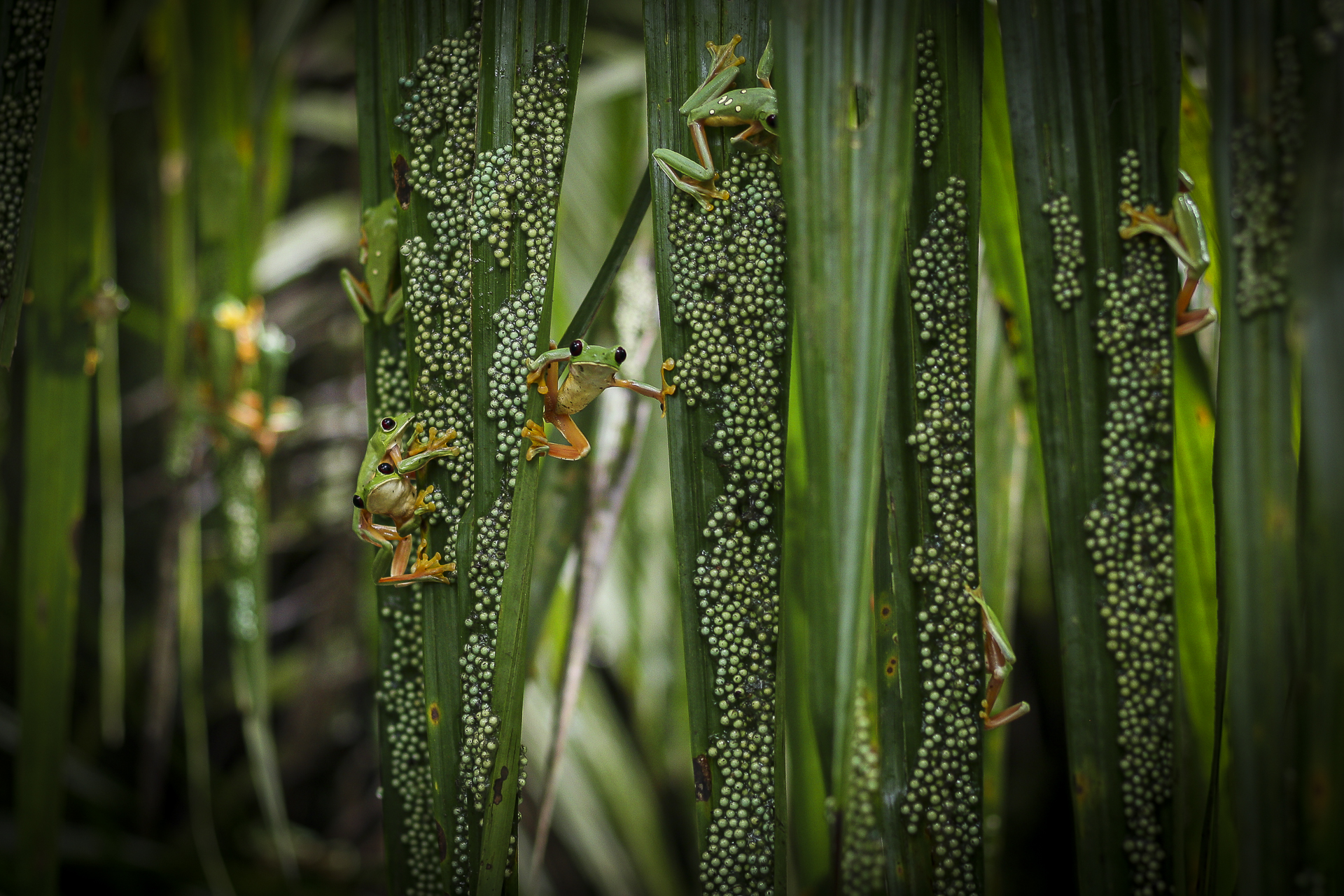
Image credit: © Brandon Güell, Wildlife Photographer of the Year - A male gliding treefrog, Agalychnis spurrelli, in search for mates and reproductive opportunities amidst thousands of potential offspring. Thousands of adults aggregate to reproduce on Costa Rica's Osa Peninsula after torrential wet-season rainstorms over a large pond. There, females lay clutches of over 200 eggs and often lay them next to eggs already on leaves creating huge egg masses on palm fronds that overhang forest pools, as seen here.
Northern Beaches Police Area Command: E-Scooter And E-Bike Safety Operation
Commencing at 8am today (Wednesday 17 May 2023), officers from Northern Beaches Highway Patrol will be conducting a high-visibility operation on e-scooter and e-bike safety along the Northern Beaches.
The aim of this operation is to educate the public on traffic laws associated with e-scooters, e-bikes and pedestrian safety.
Police will also be running this operation across May through to July 2023.
🚲 For more information on E-Bikes: https://roadsafety.transport.nsw.gov.au/stayingsafe/bicycle-riders/petrol-powered-bicycles.html
🛴 For more information on E-Scooters: https://roadsafety.transport.nsw.gov.au/stayingsafe/e-scooters/index.html


The 2023 CWAS "David Malin Awards"
Entries close Wednesday, 31 May 2023
The Central West Astronomical Society is proud to announce the 2023 CWAS Astrophotography Awards - the "David Malin Awards".
The competition will continue with the new judging structure, introduced last year. In order to build on the experience of previous years, and to continue as the premier competition of its kind in Australia, a panel of distinguished Australian astrophotographers will judge the category entries. Dr David Malin will judge the Overall Winner from the list of these winners. We are honoured that the judging panel will include Phil Hart, Alex Cherney, and Peter Ward, previous winners of the "David Malin Awards" and numerous other national and international astrophotography competitions.
There are three sections of entry - General Section, Open Themed Section, and a Junior Section (18 or younger). The general section is divided into six categories; Wide-field (camera shots), Deep Sky (telescope shots), Solar System, Nightscapes, Animated Sequences, and Smartphone Astrophotography. The Junior Section will have one open category and entries can be of any astronomical subject, and can be an animated sequence.
The Competition Structure:
- General Section:
- Wide-Field
- Deep Sky
- Solar System
- Nightscapes
- Animated Sequences
- Smartphone Astrophotography
- Junior Section (18 or younger) - One Open Category (can be of any astronomical subject)
- Open Themed Section - "The Zodiac"
The "David Malin Innovation Prize" may be awarded, at Dr Malin's discretion, for a striking astronomical image that shows exceptional imagination, innovation or an unusual approach in any of the categories.
An additional prize, "The Photo Editor's Choice", will also be awarded. This will be judged by a major news organisation's photo editor or editors.
The Solar System category is for images of solar system objects taken with a telescope. Wide-field solar system shots may be entered in the Wide-Field or Nightscape categories depending on the subject and composition.
The Nightscapes is intended to showcase the increasing popularity and evolution of this relatively new genre of astrophotography, combining beautiful terrestrial foregrounds with a night sky scene - often in a single exposure (HDR is OK) or as a multi-shot panorama. NOTE: Any image that contains terrestrial foregrounds will be considered to be a nightscape image.
Animated Sequences should be videos that are intriguing or highlight concepts and events not obvious or significant in stills. Astrophotographers are invited to submit animations, produced as either time-lapse sequences or with other forms of video. They can be of any subject, provided there is a distinct astronomical link. All animations must be submitted as MOV, MPEG, AVI or MP4 files. Today, smartphones are ubiquitous and some are capable of impressive low light-level photography.
In Smartphone Astrophotography we are looking for images that have been taken with only a smartphone, and without telescopes, of an astronomical scene that has some aesthetic appeal and/or that has captured something you might not expect to see from such a tiny camera.
There is no strict delineation between Deep Sky and Wide-Field images. Wide-field images are typically produced with DSLR and interchangeable lens cameras at a focal length of less than ~400mm, but this characterisation is becoming less clear as equipment evolves. Wide-field images are typically constellations or "scenes" rather than deep sky "objects" but entrants are free to submit images to either category.
Judges reserve the right to move images between categories.
The Open Themed Section is open to all astrophotographers. They are encouraged to see who can be the most inventive and creative in evoking the theme, which this year will be "The Zodiac". Photographs could be of the dusty zodiacal light or gegenschein, portraits of the zodiac constellations with or without planets amongst them, or anything else that symbolises the zodiac, one of the earliest astronomical concepts in our understanding of the sky. We are looking for eye-catching images that are also aesthetically pleasing and/or challenging.
All entries must be images that faithfully reflect and maintain the integrity of the subject. Image manipulations or composites that produce works that are more "digital art" than true astronomical images, will be deemed ineligible.
All still images must be submitted as digital files via a dedicated web site that can be accessed at this myphotoclub web page. For judging purposes, still images must be submitted as JPG files with the longest side having a dimension no greater than 4,950 pixels. All images must be in Adobe 1998 RGB colour space and will be judged using a calibrated monitor. Similarly, winning images will be printed from the files as-received, so it would be prudent for entrants to calibrate their monitors if possible. It does make a difference. Click here for an example of a very detailed set of calibration procedures for all platforms. For Mac users, a useful monitor calibration program can be found under "Monitors" in System Preferences, and the ideal solution for monitor calibration is a stand-alone device such as the Spyderexpress.
Submission of entries will close at 24:00 (AEST) on Wednesday, 31 May 2023. Entrants must first create an account on the MyPhotoClub submission page, by clicking on the green entry button. Follow the links to create the account and password.
Entry fees are $15 per entry and should be paid by the PayPal gateway on the entry website. Credit and debit cards can be used on this gateway.
The photographs will be judged by a panel of distinguished astrophotographers, who will judge the category winners. Dr David Malin will judge the overall winner from this list of winners.
Submitted image files should not contain identifying metadata. If anonymity of the judging process is important to the entrant, then images should not be shared in public forums prior to completion of judging. The winners will be notified and presented with the "David Malin Awards" during a special ceremony, held during the 2023 CWAS AstroFest, in the presence of invited dignitaries on Saturday, 22 July 2023. All winners should make every effort to attend the presentation of the awards.
A selection of the finest astrophotographs received will be professionally printed courtesy of Sunstudios and exhibited for the entire year at the CSIRO Parkes Observatory's Visitors Centre. In addition, a second set will tour the country in a travelling exhibition, organised by the Museum of Applied Arts and Sciences, to selected venues across Australia.
There is a limit of five (5) entries per category per photographer. All photographs must have been taken no more than 2 years before the closing date of entry, and no re-entries from previous DMA competitions will be accepted. All entries must be submitted in electronic form via the MyPhotoClub submissions web site. The entrants must provide brief details of the equipment, exposure times, processing, and where relevant, the location where the image was taken.
It is not just technical skill that the judges will be looking for, but an aesthetically pleasing picture that reflects and captures the beauty, inspiration and interest of astronomy. All images will be judged by these criteria.
More details here: https://www.cwas.org.au/astrofest/DMA/
Enter here: https://cwasdma.myphotoclub.com.au/
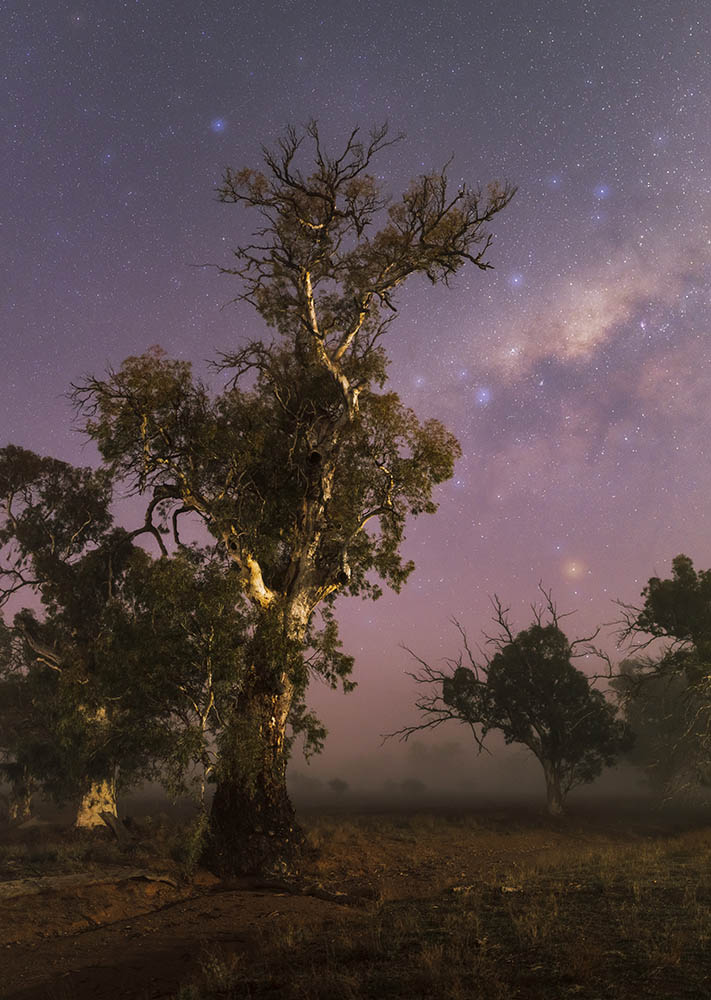
2022 Winner: Ian Inverarity - Nightscapes; OVERALL WINNER "Old Giant in the Fog"
Citation: "This is the finest image I have seen in this competition. It is simply beautiful, and no more needs to be said. No sign of stitching, either."
The Big Bike Film Night At Warriewood
Australian Flies: There Are 30 Thousand Species - Here's Two That Look Like Bees That You Will See During Winter
Did you know that flies form one of the five most diverse insect orders, including about 150,000 described species in 150 families?
It is estimated that there are 30,000 species of fly in Australia, of which only 6400 have been described!
Although we don't see too many around as it gets colder, they are still here - here are just two you will see in your area even in Winter, both of which can often be mistaken for bees.
Hoverfly Feasting On Nectar At Palm Beach
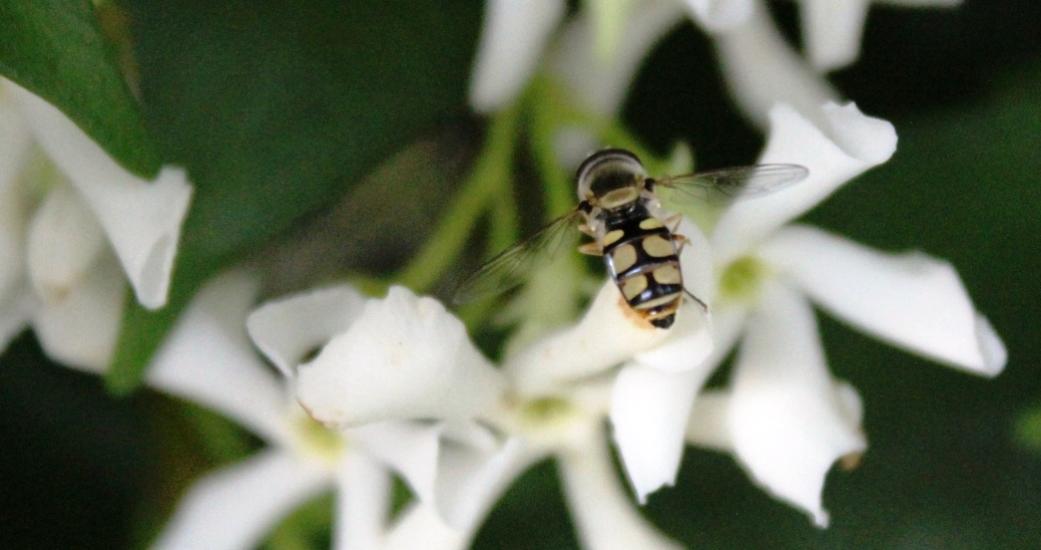

Hoverflies, which have similar patterning to bees, are common garden visitors in winter.
Aphids alone cause tens of millions of dollars of damage to crops worldwide every year; because of this, aphid-eating hoverflies are being recognised as important natural enemies of pests, and potential agents for use in biological control. Some adult syrphid flies are important pollinators of flowering plants in a variety of ecosystems worldwide.
About 6,000 species in 200 genera have been described. Hoverflies are common throughout the world and can be found on all continents except Antarctica. Hoverflies are harmless to most other animals, despite their mimicry of more dangerous wasps and bees to ward off predators.


Bombyliidaes
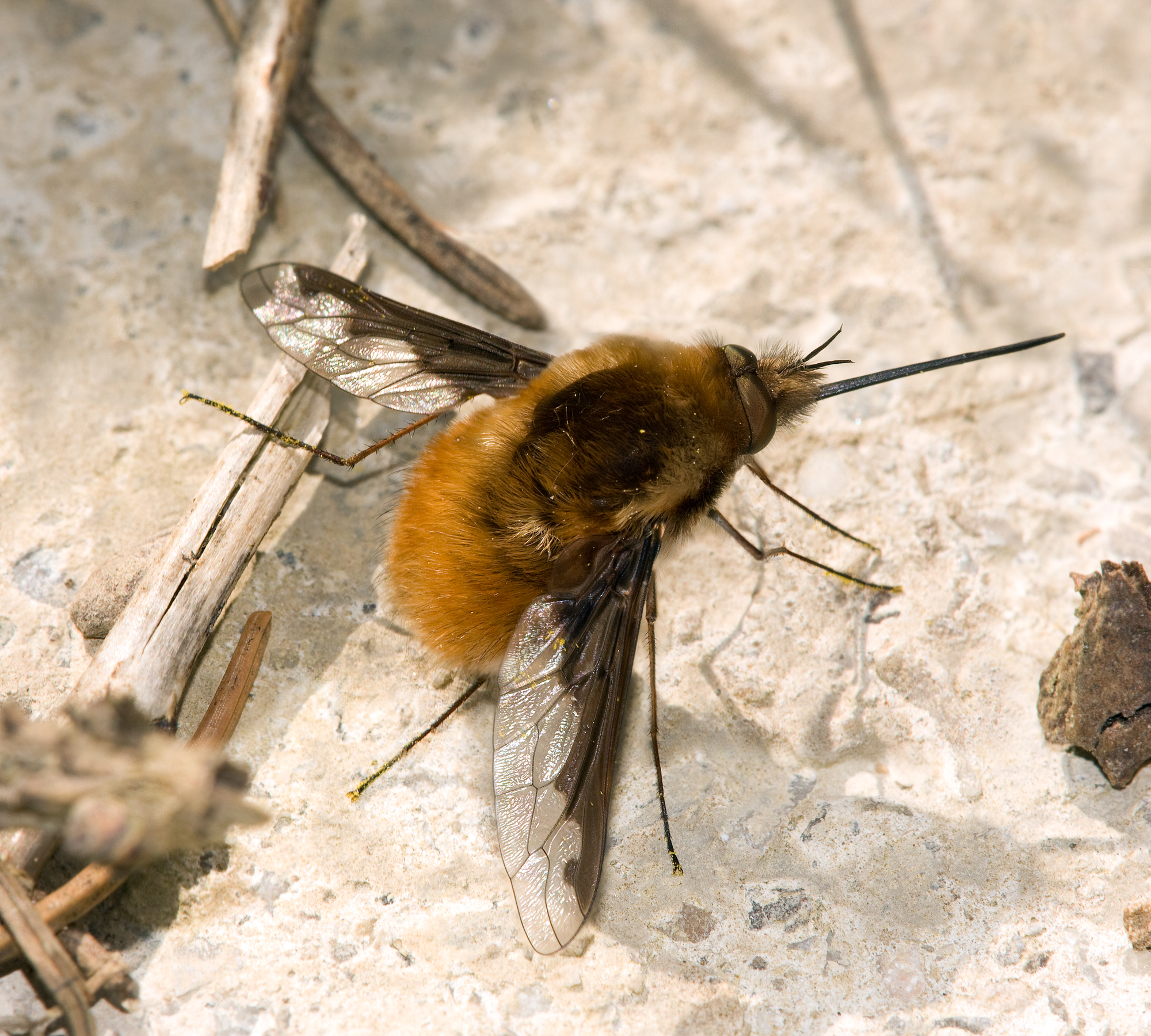
Bee-fly (Bombylius major). Photo: Richard Bartz
The Bombyliidae are a family of flies, commonly known as bee flies. Adults generally feed on nectar and pollen, some being important pollinators. Larvae are mostly parasitoids of other insects.The Bombyliidae are a large family of flies comprising hundreds of genera, but the life cycles of most species are known poorly, or not at all. They range in size from very small (2 mm in length) to very large for flies (wingspan of some 40 mm). When at rest, many species hold their wings at a characteristic "swept back" angle.
Adults generally feed on nectar and pollen, some being important pollinators, often with spectacularly long proboscises adapted to plants such as Lapeirousia species with very long, narrow floral tubes. Unlike butterflies, bee flies hold their proboscis straight, and cannot retract it. In parts of East Anglia, locals refer to them as beewhals, thanks to their tusk-like appendages.
Many Bombyliidae superficially resemble bees and accordingly the prevalent common name for a member of the family is bee fly. Possibly the resemblance affords the adults some protection from predators.
The larval stages are predators or parasitoids of the eggs and larvae of other insects. The adult females usually deposit eggs in the vicinity of possible hosts, quite often in the burrows of beetles or wasps/solitary bees. Although insect parasitoids usually are fairly host-specific, often highly host-specific, some Bombyliidae are opportunistic and will attack a variety of hosts.
The Bombyliidae include at least 4,500 described species, and certainly thousands more remain to be described. However, most species do not often appear in abundance, and compared to other major groups of pollinators they are much less likely to visit flowering plants in urban parks or suburban gardens. As a result, this is arguably one of the most poorly known families of insects relative to its species richness. The family has a patchy fossil record, with species being known from a handful of localities, the oldest known species are known from the Middle Cretaceous Burmese amber, around 99 million years old.

History Of The Spit To Manly Tramline (And A Bit On A Punt And A Bridge)
By BackTracks Channel
more in; Tram Memorabilia - Historic Daylight Run For Sydney Light Rail Begins 80 Years After Last Tram To Narrabeen Closed - 2018 PON History page and The Riddles Of The Spit And Church Point: Sailors, Rowers, Builders
"French Roast" - By Fabrice O. Joubert
When it is time to pay the check at a chic Parisian brasserie, a stiff businessman realizes, with horror, that he's forgotten his wallet. How is going to pay the check?
This little ditty shows how the poorest are often the most generous, without even waiting for a thank you.
The animation was directed by the great French Animator Fabrice O. Joubert, known for his work on "The Prince of Egypt", "Wallace & Gromit", "Star Wars: The Clone Wars", "Despicable Me" and "A Monster in Paris".
This french animated short film won numerous awards and was nominated at the Academy Award (Oscar) for Best Animated Short Film in 2010
School Leavers Support
- Download or explore the SLIK here to help guide Your Career.
- School Leavers Information Kit (PDF 5.2MB).
- School Leavers Information Kit (DOCX 0.9MB).
- The SLIK has also been translated into additional languages.
- Download our information booklets if you are rural, regional and remote, Aboriginal or Torres Strait Islander, or living with disability.
- Support for Regional, Rural and Remote School Leavers (PDF 2MB).
- Support for Regional, Rural and Remote School Leavers (DOCX 0.9MB).
- Support for Aboriginal and/or Torres Strait Islander School Leavers (PDF 2MB).
- Support for Aboriginal and/or Torres Strait Islander School Leavers (DOCX 1.1MB).
- Support for School Leavers with Disability (PDF 2MB).
- Support for School Leavers with Disability (DOCX 0.9MB).
- Download the Parents and Guardian’s Guide for School Leavers, which summarises the resources and information available to help you explore all the education, training, and work options available to your young person.
School Leavers Information Service
- navigate the School Leavers Information Kit (SLIK),
- access and use the Your Career website and tools; and
- find relevant support services if needed.
Word Of The Week: Blue
adjective
1. of a colour intermediate between green and violet, as of the sky or sea on a sunny day. 2. INFORMAL (of a person or mood) melancholy, sad, or depressed.
noun
1. blue colour or pigment. 2. a small butterfly, the male of which is predominantly blue while the female is typically brown.
verb
1. make or become blue. 2. HISTORICAL wash (white clothes) with bluing.
Also:
- (health care) Having a bluish or purplish shade of the skin due to a lack of oxygen to the normally deep red blood cells.
- (politics) Supportive of, run by (a member of), pertaining to, or dominated by a political party represented by the colour blue; (US politics) Supportive of, run by (a member of), pertaining to, or dominated by the Democratic Party. [late 20th c.]; (Australian politics) Supportive of or related to the Liberal Party; (UK politics) Supportive of or related to the Conservative Party.
- (astronomy) Of the higher-frequency region of the part of the electromagnetic spectrum which is relevant in the specific observation.
- (of steak) Extra rare; left very raw and cold.
- (of a dog or cat) Having a coat of fur of a slaty gray shade.
- (archaic) Severe or overly strict in morals; gloomy.
- (archaic, of women) literary; bluestockinged.
- (particle physics) Having a color charge of blue.
- (informal) Risqué; obscene; profane.
- (slang, dated) Drunk.
- (symbology) true blue
- (joke name for redheads) coined in Australia more than anywhere else in the world, 'bluey' is used as an affectionate nickname for a redhead. It is thought by some to have derived from the early 1900s as a form of irony. Blue is evidently contrasting with red, thus being used as a joke.
From Middle English blewe, from Anglo-Norman blew (“blue”), from Middle French bleu, from Old French blöe, bleve, blef (“blue”), from Frankish blāu (“blue”) (perhaps through a Medieval Latin blāvus, blāvius (“blue”), from Proto-Germanic blēwaz (“blue, dark blue”), from Proto-Indo-European bʰlēw- (“yellow, blond, grey”). Cognate with dialectal English blow (“blue”), Scots blue, blew (“blue”), North Frisian bla, blö (“blue”), Saterland Frisian blau (“blue”), Dutch blauw (“blue”), German blau (“blue”), Danish, Norwegian and Swedish blå (“blue”), Icelandic blár (“blue”), Latin flāvus (“yellow”), Middle Irish blá (“yellow”). Doublet of blae.
Possibly related also to English blee (“colour”), from Old English blēo (“colour”); but direct derivatives of Proto-Germanic blēwaz (“blue, dark blue”) in Old English include: Old English blāw and blēo (“blue”), Old English blǣwen (“bluish, light-blue”), blǣhǣwen (“blue-coloured, bluish, violet or purple colour”, literally “blue-hued”). There seems to be a parallel connection in Germanic between words for blue and colour, dually exemplified by Proto-West Germanic *blīu (“colour, blee”) and *blāu (“blue”); and Proto-Germanic *hiwją (“colour, hue”) and *hēwijaz (“blue, purple”).
The modern English word blue comes from Middle English bleu or blewe, from the Old French bleu, a word of Germanic origin, related to the Old High German word blao (meaning 'shimmering, lustrous'). In heraldry, the word azure is used for blue.
Blue is one of the three primary colours in the RYB colour model (traditional colour theory), as well as in the RGB (additive) colour model. It lies between violet and cyan on the spectrum of visible light. The eye perceives blue when observing light with a dominant wavelength between approximately 450 and 495 nanometres. Most blues contain a slight mixture of other colours; azure contains some green, while ultramarine contains some violet. The clear daytime sky and the deep sea appear blue because of an optical effect known as Rayleigh scattering. An optical effect called the Tyndall effect explains blue eyes. Distant objects appear more blue because of another optical effect called aerial perspective.
Blue has been an important colour in art and decoration since ancient times. The semi-precious stone lapis lazuli was used in ancient Egypt for jewellery and ornament and later, in the Renaissance, to make the pigment ultramarine, the most expensive of all pigments. In the eighth century Chinese artists used cobalt blue to colour fine blue and white porcelain. In the Middle Ages, European artists used it in the windows of cathedrals.
Europeans wore clothing coloured with the vegetable dye woad until it was replaced by the finer indigo from America. In the 19th century, synthetic blue dyes and pigments gradually replaced organic dyes and mineral pigments. Dark blue became a common colour for military uniforms and later, in the late 20th century, for business suits. Because blue has commonly been associated with harmony, it was chosen as the colour of the flags of the United Nations and the European Union.
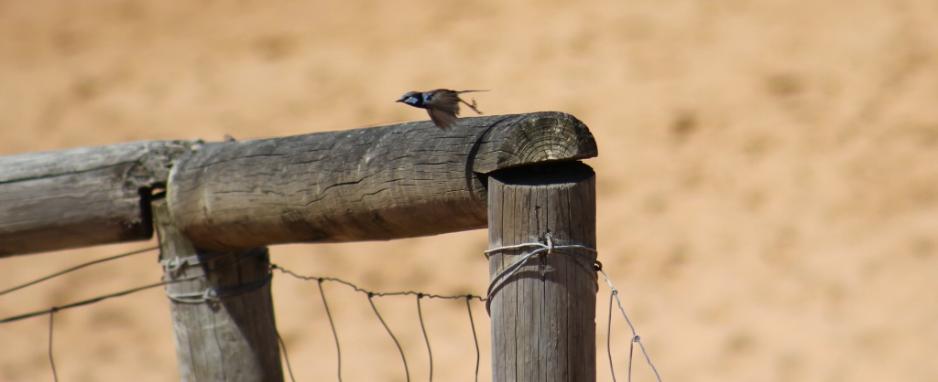
Above: Superb Fairywren, Malurus cyaneus, also known as the Superb Blue-wren or colloquially as the Blue Wren, seen with another male and two females flitting around Avalon Dunes and over to sand.
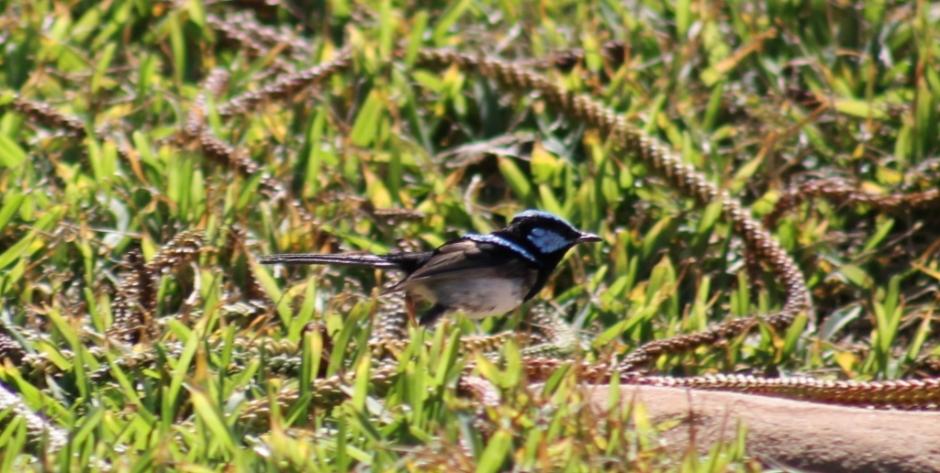
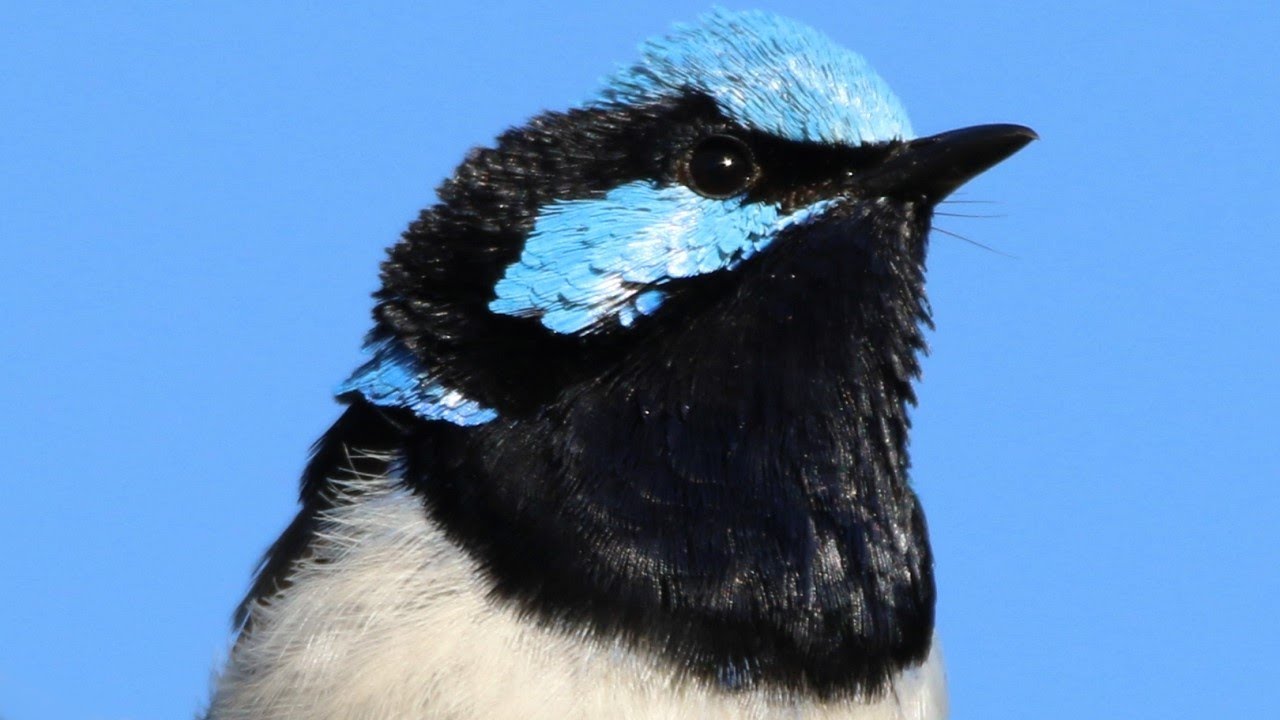
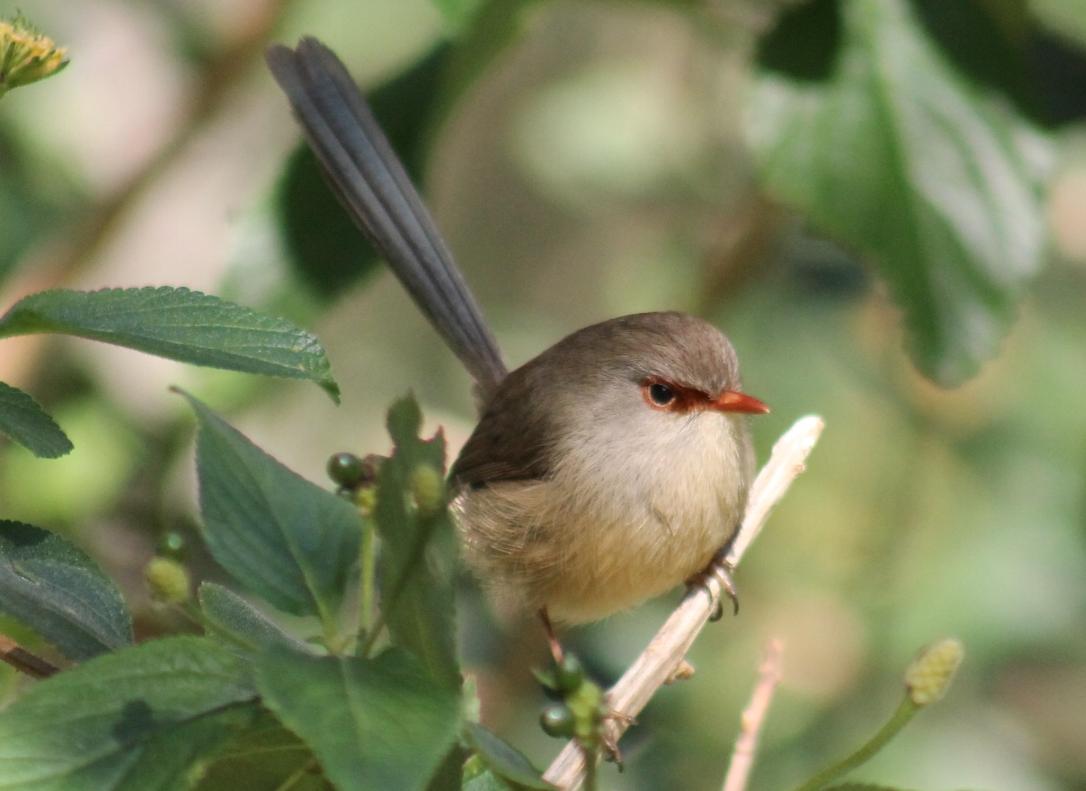
Superb Fairy-wren (Malurus cyaneus) - female
Bees can do so much more than you think – from dancing to being little art critics
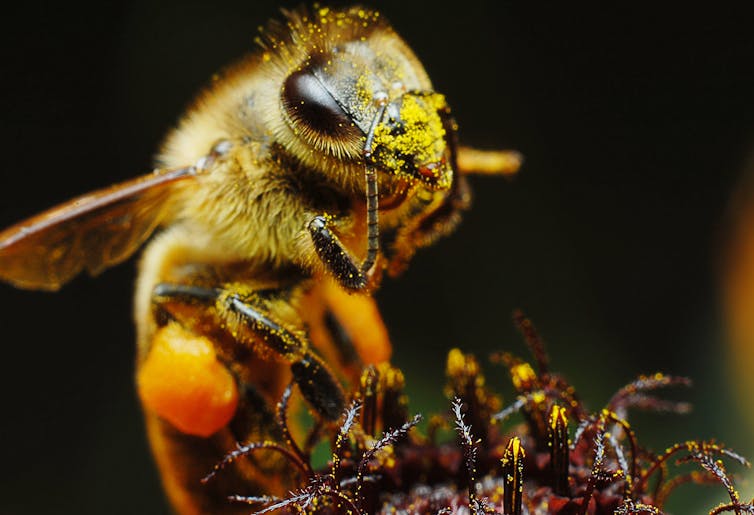
Bees are among the most important insects on Earth – vital pollinators of our crops and significant contributors to human societies for thousands of years.
While visiting various plants, bees need to figure out the best flowers so they can be the most efficient foragers possible, and communicate this to their hive.
But there’s much more these insects’ tiny brains are capable of.
Bees Have A Great Memory And Can Learn A Lot
Bees can visit hundreds of flowers a day across multiple locations, and are great at learning which floral colours, shapes and locations are best for finding food. These flower memories can last for days, allowing for individual workers to return to the best flowers.
Bees are capable of learning in complex ways. They can use “cross-modal” learning, recognising an object they’ve experienced with one sense when it’s presented in another sense. In one study, bumblebees were trained to tell cubes and spheres apart using only touch, but could still distinguish them visually if they were unable to touch the shapes – and vice versa.
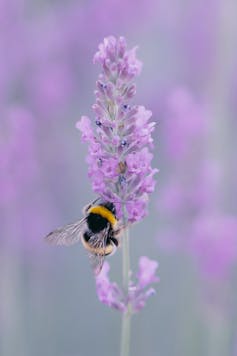
Bumblebees were trained on different combinations of higher and lower quality coloured flower pairs. When bees were presented with flower combinations that had never been paired together, bumblebees forgot information about how sweet a flower was, but could remember if their experience was better or worse for the two flowers displayed.
This demonstrates bees can integrate sensory information independently of the specific sense involved. This is something human babies do when developing, and how we learn to read and write.
Bees Also Learn From Each Other
Honeybees are possibly most famous for the “waggle dance”, which is how they tell their nest mates about the distance, direction, and quality of a food source.
Honeybees are born to dance, but when young bees are able to observe older, more accomplished dancing bees, the young bees become “better” dancers.
Aside from the waggle dance, social bees use a range of social information to learn from others. They follow each other to good flowers, they use scent marks to mark both rewarding and empty flowers, or simply watch more experienced individuals to learn how to access food.
Bees are also individuals, with differences in their ability to learn – some are fast learners, whilst others are a bit slow.
Their learning isn’t simply passive either. Bumblebees have been trained to push balls into holes to get rewards. During these experiments there have been observer bees who have learnt the skill either by watching (and no direct interaction with the teacher bee), or interacting with the teacher bee and then spontaneously improving on the technique.
This demonstrates an understanding of the task at hand and the desired outcome, allowing the observer bee to find her own, better way to get the reward.
As the FIFA Women’s World Cup approaches, we can even use this training technique to get bees to learn to play soccer.
Bees Can Recognise Faces – And Paintings
Bees’ ability to memorise doesn’t stop at flowers. In one example, honeybees were rewarded every time they visited a painting by a “rewarding” artist (either Monet or Picasso). When bees were given paintings they had never seen before, they still visited the rewarding artist, suggesting they can discriminate between art styles.
This extends beyond Picasso and Monet, with bees learning to discriminate between Monet and Indigenous artist Noŋgirrŋa Marawili in a single afternoon.
Their discrimination ability beyond flowers is also impressive, as honeybees can even recognise people’s faces.
Bees Can Play
Play is considered a really important part of learning and cognition, and it’s not limited to humans. A previous study of bumblebees showed they meet the criteria of play – repeated behaviours that occur voluntarily for pleasure, and offer little value to the animal’s ability to mate, reproduce, or feed successfully.
Bumblebees that entered a room full of wooden balls willingly rolled around with the balls, and were more likely to enter a room that was previously associated with wooden balls, even though they were given no food reward for doing so.
Native Bees Are Smart
Most of our understanding of bee brains focuses on two groups of bees: honeybees and bumblebees. These bees are widely distributed across the globe and are commercially important pollinators.
But there are a lot of other species of bees we don’t know as much about.
In Australia, we have over 2,000 species of native bees, and we know that a lot of them have great colour vision, and innate preferences for particular shapes and colours. Halictid bees can learn to avoid flowers associated with predation, for example.
It is highly likely that most other bee species are capable of clever feats – we just need to spend more time studying them.
Could Bees Be… Sentient?
Thinking about these abilities and taking the research all together, it becomes clear that the “simple” minds of bees are far more capable than we could have imagined.
Though they only have about a million neurons (we have about 100 billion), bees show complex behaviours like tool use, they have a representation of space, and they can learn through observation.
This has brought about some exciting discussions around bees potentially having consciousness. If that were true, it could change not only how we see bees, but how we interact with them. It also raises the question – could other invertebrates have consciousness?
Stress And Other Factors Limit Their Ability To Do These Clever Things
Native bees face many risks, including the negative impacts of habitat loss, pollution, climate change, and the overuse of pesticides.
For bees generally, stress is a problem as well. All kinds of stress can make it harder for bees to learn, as it impacts their cognitive functions, their ability to think, and remember.
There is evidence that pesticides and air pollution can impair memory and learning in bumblebees and honeybees. When honeybees were exposed to road pollution, they were less able to remember floral scents, which makes it harder for them to locate the flowers they need to sustain their hive.
Next time you’re watching bees in your garden, don’t forget to appreciate all of the things their brains are able to do – and how much we need to look after them.![]()
Caitlyn Forster, Associate Lecturer, School of Life and Environmental Sciences, University of Sydney and Eliza Middleton, Biodiversity Management Officer, University of Sydney
This article is republished from The Conversation under a Creative Commons license. Read the original article.
TikTok promotes vaping as a fun, safe and socially accepted pastime – and omits the harms

Social media platforms such as Instagram, TikTok and Facebook overwhelmingly show vaping in a positive light. This messaging makes it seem that e-cigarette use is common and socially accepted.
Traditional tobacco advertising has been banned in Australia for decades. However, e-cigarettes are widely promoted on social media, undoing some of the positive work of previous decades.
Most platforms have content policies that expressly prohibit the promotion of tobacco product use, including e-cigarettes. But our new research, published this week, shows these policies are routinely violated with little or no consequences.
Positive Videos Result In More Vaping
E-cigarette use by young people, including in Australia, is rapidly growing. So is evidence of the harmful health effects of e-cigarettes.
Positive social media messages around vaping may particularly impact young people, who are the most frequent users of social media. In some cases, these messages have even been shown to blatantly target teens.
Research shows young people who view social media posts featuring e-cigarettes are more likely to vape and to view e-cigarettes positively. This is true of both e-cigarette advertising and user-generated content, with creators effectively doing the marketing job for e-cigarette companies.
TikTok Emphasises Tricks And Downplays Harms
In our recently published study, we looked at the ways e-cigarettes are being advertised and promoted on TikTok. We analysed 264 English language user-generated e-cigarette videos and evaluated them against TikTok’s own content policy in February 2022.
We found most of the videos (98%) portrayed e-cigarettes positively.
More than one-quarter of the videos clearly violated TikTok’s content policy and promoted vaping products for purchase.
Few videos contained health warnings. Only 2% of posts referenced vape or nicotine addiction.
A small number of posts referred to public health professionals or commented on e-cigarette regulation. These posts were comparatively less popular, receiving a smaller proportion of views and likes.
Half the videos referred to a vaping community. These posts were slightly more popular than those that didn’t refer to a shared identity. This may act to shape norms around e-cigarette use and increase the perception that vaping is socially accepted.
Popular posts also included references to vape tricks (such as creating shapes from exhaled aerosol), with early research showing adolescents often identified vaping tricks as the reason they started using e-cigarettes. Posts also used humour, which is an effective tool to reach young social media users.
Videos that violated content policy often provided details on how and where to purchase e-cigarette products. This included providing links to online retailers and to other social media accounts.
The promotion of offers such as giveaways and sale prices were common, in direct violation of content policy. Many posts also provided product reviews.
So What Needs To Happen?
We can’t rely on platforms to develop and enforce content policy. Social media policies are commonly violated and there are no major consequences – the platforms themselves decide the consequences for breaches.
This is a problem because social media platforms have a clear financial incentive not to punish people who breach their policies.
The federal government’s recent strong position to stamp out recreational vaping among young people through regulations, enforcement, education, plain packaging and a ban on flavourings is welcomed.
However, this did not include clamping down on e-cigarette advertising, promotion and sponsorship on social media, which is also clearly needed.
Emphasis needs to be placed on enforcement of policies. This must include requiring social media platforms to report on how they’re ensuring regulations are being upheld.
Current policies and moderation processes are insufficient in restricting the spread of pro e-cigarette content on TikTok. This is exposing young social media users to e-cigarette use. There needs to be greater regulation of e-cigarette content and its promotion, to prevent future uptake and harm to young people.![]()
Renee Carey, Senior Research Fellow, Curtin University and Jonine Jancey, Academic and Director Collaboration for Evidence, Research and Impact in Public Health, Curtin University
This article is republished from The Conversation under a Creative Commons license. Read the original article.
We have all heard social media can impact women’s body image – but it isn’t all bad

The “Cost of Beauty”, a short video recently released by global beauty brand Dove, highlights the damaging effects of social media on young womens’ body image and self esteem. It forms part of a wider campaign that raises awareness about the devastating effects of social media on young women’s mental and physical health.
It is clear social media can negatively affect women’s relationships with their bodies, but our recent research revealed a more complex and nuanced picture.
More than a decade of research has shown that unrealistic beauty standards, the rise of “fitspiration”, body shaming and online gender-based violence, are having a significant impact on young women.
That said, social media users are not naive about the toxic beauty ideals being promoted across digital platforms.
Our research found that women were very aware of the risks and vulnerabilities associated with using social media. And women were developing habits and online communities to counter these negative elements.
We focused on the emergence of “#fitspo” (short for “fitspiration”) content – think rippling six pack, sweaty sports bra, and smiling face mid-workout.
Despite being seemingly health positive, one of the consequences of fitspiration is that women now experience pressures to be both thin and fit. Increasingly, many women and girls actively avoid these online spaces, while others find support, inspiration and even care in these online communities.

Instagram’s Potential As A Positive Space
In our work with exercising women who use Instagram, we found many everyday examples of how they thoughtfully navigated online spaces to reduce risk and minimise harm to themselves and others.
For instance, when confronted with unrealistic body standards, women were making active choices to strategically curate their social media worlds by blocking, unfollowing – also known as “pruning” – content they found unhealthy or unrelatable. They also increasingly blocked and reported followers who are offering unsolicited advice and negative or sexualised comments.
To challenge the pressures enhanced images can bring, many women chose to represent their “real”, “raw” and imperfect bodies without editing out stretch marks or body fat. Some women promoted this practice by using hashtags such as #filterfreefriday or #noedit.
Women also made choices about how they engaged with other bodies online. Body shaming is rife on social media. But in many exercising communities women avoided posting comments that could make other women feel self-conscious or negative about their bodies.
Making comments about someone’s image could be seen to contribute to body surveillance. So, participants in our research explained that they focused on how women were looking strong or confident, or celebrated their efforts and achievements in a sport. Knowing how it felt to have one’s body judged online prompted women to avoid judging others.
The Power Of Connection
Social connection was also an important feature for women and girls using social media.
We found that for many women, their motivations for sharing images of themselves online were not simply about “showing off” their bodies or promoting themselves. Instead, they were trying to build safe online communities to seek validation and support. Posting pictures of their unfiltered bodies pursuing their sport and fitness goals was one of the ways they built a collective online presence.
Social media was also important for women to promote their offline communities, relationships and skills, not just how they looked. This was particularly important during the pandemic, with fitness professionals using digital technologies to support their movement communities during challenging times.
Importantly, women from diverse social, cultural and religious backgrounds experienced both the same and different sets of risks (such as racist and sexist trolling or body shaming) when using social media.
Scholars have identified the ways Muslim sportswomen have navigated such risks, carefully considering gender, religion and culture in managing their accounts, their audiences, and taking time to consider the types of images and text they share.
Researchers in Turkey have also revealed the potential in such imagery for challenging racialised and patriarchal norms and expectations of women’s bodies in sport and fitness.
Minimising The Harm Of Social Media
Whether we intend it to or not, posting about our bodies online and in public makes us vulnerable.
Our findings suggests that we need alternative ways of thinking about women and girls’ social media usage, where the risks and vulnerabilities of social media use become the basis for a more nuanced way of understanding how participation on social media can affect our lives.
Paying attention to women’s efforts to minimise harm through their own everyday actions on social media is an important first step towards cultivating social media encounters that account for broader impacts of what we post, based on care, consideration and respect.![]()
Kim Toffoletti, Associate Professor of Sociology, Deakin University; Holly Thorpe, Professor in Sociology of Sport and Gender, University of Waikato, and Rebecca Olive, Vice Chancellor's Senior Research Fellow, RMIT University
This article is republished from The Conversation under a Creative Commons license. Read the original article.
‘Habits of civilised life’: how one state forced Indigenous people to meet onerous conditions to obtain citizenship
Peter Prince, University of SydneyNote of warning: This article refers to deceased Aboriginal people, their words, names and images. Words attributed to them and images in the article are already in the public domain. Also, historical language is used in this article that may cause offence. Individuals and communities should be warned that they may read or see things in this article that could cause distress.
In the breakthrough High Court case Love and Thoms vs Commonwealth in 2020, the court ruled that First Nations people could not be considered aliens in Australia. As Justice James Edelman noted in the decision,
whatever the other manners in which they were treated […] Aboriginal people were not ‘considered as foreigners in a kingdom which is their own’.
Yet, in my upcoming book with historian Kate Bagnall, I look at how Aboriginal and Torres Strait Islander people were long denied the rights of citizenship in their own land due to discriminatory laws – perhaps no more so than in Western Australia.
Until the 1970s, Western Australia still forced Aboriginal people to “dissolve tribal and native associations” and “adopt the manner and habits of civilised life” for two years before they could apply for citizenship under the state’s Natives (Citizenship Rights) Act 1944
Western Australia had copied racially discriminatory provisions on citizenship from the United States, specifically the outdated 1918 US Federal Code, with strong echoes of the notorious “Black Laws” from the early 1800s.

As Garth Nettheim and Larissa Behrendt note in the 2010 edition of Laws of Australia, the Western Australian law “throughout its life was inconsistent with the Commonwealth legislation” and therefore unlawful.
This is because, from the time of federation, nationality and citizenship were matters for federal, not state law.
Under British law that had remained unchanged since the 17th century, all Aboriginal Australians were already considered British subjects under colonial rule. And in 1948, the Nationality and Citizenship Act gave citizenship to all Australians previously deemed British subjects, including Aboriginal people.
Noongar activists knew they were already citizens under the laws imposed by white settlers and called for the rights and protections that should have been granted to them.
As George Abdullah, founder of the Aboriginal Advancement Council of WA and president of the Aboriginal Rights Council, said in 1962:
Full Australian citizenship was the natives’ birthright, but even the most degraded white Australian had more rights than the native. To deprive a person of civil rights was to destroy his self-esteem and his incentive to become a responsible citizen.
Abdullah displayed the same resolve to achieve equal human rights for Aboriginal people that is evident more than 60 years later in the drive for a Voice to Parliament. He declared:
We are demanding freedom from restrictive legislation, with equal rights and opportunities as our white brothers and sisters, and then we can join them in developing a greater Australia.
Citizenship Hearings More Akin To Criminal Trials

For over a century, Australian states enforced so-called “protection laws” controlling every aspect of the lives of Aboriginal and Torres Strait Islander people. These laws led to the forcible removal of Indigenous children from their homes and controlled everything from where people lived and worked to their personal relationships and contacts with family and community.
But only Western Australia added citizenship legislation as well, peddling the lie that Aboriginal people had to apply under state law to become “Australian citizens”. Consistent with the national policy of assimilation at the time, one white MP told the state parliament in 1944 that citizenship was an “inspirational measure” for “de-tribalised natives” who lived according to “white standards”.
Government ministers in Western Australia wilfully disregarded the laws of the Commonwealth in setting up this discriminatory system. When introducing the Natives (Citizenship Rights) bill to state parliament in September 1944, A.M. Coverley, the minister for the North-West, claimed,
The main principle underlying the bill is to provide an opportunity for adult natives to apply for full citizenship as Australians.

After the law was passed, “citizenship” hearings in Western Australia were more like criminal trials, held before a police magistrate with local police as witnesses. Aboriginal applicants suffered the humiliation of intrusive medical examinations and personal inspections of their homes.
The magistrate had to be satisfied the applicant was “of good behaviour and reputation” and “reasonably capable of managing his own affairs”. In addition, applicants had to be “able to speak and understand the English language” and could not be suffering from “active leprosy, syphilis, granuloma or yaws”.
Some Aboriginal residents in WA refused to take part in the intrusive process.
In 1954, for example, Noongar man George Howard, who described himself as “a Native and […] proud of that fact”, addressed a Rotary luncheon at the Savoy Hotel, Perth. His very presence in the hotel contravened a state prohibition on “natives” entering licensed premises. As Perth’s Daily News pointed out, “he could get full legal rights by getting a certificate of citizenship”. But as Howard told the audience,
to get this certificate, I must pay fees and undergo personal investigation by a board, with the end result of being told I am what I am – a natural-born Australian.
Others who went through the process were mysteriously denied, even if they satisfied all of the requirements. In 1955, Noongar man Jack Shandley, head stockman at Gogo Station near Fitzroy Crossing, travelled 300 kilometres to the Derby magistrates court, declaring he wanted “to be Australian and be free to travel”. However, his application was refused, with no reason given.

A Certificate Akin To A 'Dog Tag’
Even successful applicants faced increased racial harassment, not least being targeted as potential suppliers of liquor. In 1947, for instance, Police Constable C.H. Brown observed suspicious activity on Wellington Street in Perth:
I saw the native, Sport Charles Jones, holder of the certificate of citizenship No. 152 walking across the street from the direction of the Imperial Hotel. He was carrying two bottles bearing labels, which appeared to be Emu Bitter Beer Labels.
Jones was convicted and “fined £4 with 4/6 costs” for supplying beer to a “native”.
Aboriginal Australians derided their “certificate of citizenship” as a derogatory “dog licence” or “dog tag”. In 2002, Wongutha man Leo Thomas told the Federal Court:
When I was about 21 years old […] the football team would go drinking, but if I was caught getting a beer at a hotel my mate would be fined […] The president of the football club asked for me one day they said that we have to go to court […] so they ended up giving me the citizenship rights […] a little black book […] the dog collar, I used to call it.
Even former soldiers in the Australian armed forces had to show their citizenship “dog tag” to get a drink in a WA pub.
James Brennan enlisted in the army in 1940 and was one of the “Rats of Tobruk” in the second world war, a group of Australian forces who held the Libyan port of Tobruk against German-Italian forces. But as his son-in-law later related to the ABC,
When he came back from war […] he had to get a citizenship right to go into pubs […] He fought for the country and when he came back home, he couldn’t go into any hotel to get a drink.
Why Truth-Telling Matters
Courts and policymakers are still making decisions about the lives of Aboriginal and Torres Strait Islander peoples without full knowledge of Indigenous histories and how they continue to affect people today. In our forthcoming book, I argue that even Australia’s highest court has presented a misleading, “whitewashed” view of the history of Indigenous belonging since 1788.
The Voice to Parliament – and the broader goals being sought under the Uluru Statement from the Heart – now offer Australia a chance to confront its history and construct a more inclusive narrative of nationhood.
This history should address the ways in which Australia’s First Peoples were refused equal citizenship and denied the rights and protections that should have accompanied that status. Western Australia’s citizenship law must not be forgotten – it’s an integral part of this story.![]()
Peter Prince, Affiliate of the University of Sydney Law School, University of Sydney
This article is republished from The Conversation under a Creative Commons license. Read the original article.
‘Whales died so women could look like this’: what shows like Bridgerton get wrong about whalebone and corsetry

The hotly anticipated prequel to the popular Bridgerton series, Queen Charlotte: A Bridgerton Story, has just been released on Netflix. The Bridgerton writers have once again taken aim at the corset in the opening sequence of the first episode.
Sitting uncomfortably in a carriage on her way to London to meet King George III, Princess Charlotte of Mecklenburg-Strelitz laments that her underpinnings (stays - the 18th-century term for corset - and hoop petticoat) are not only uncomfortable but made of “the bones of whales”. These “whalebones”, she claims, are “delicate” and “sharp” and may stab her if she makes a wrong move.
While it is true that whales died to provide one key material used in the manufacture of women’s underpinnings from the 16th through to 20th centuries, the real Princess and then Queen Charlotte, who had a keen interest in the natural world, would have understood whalebone is not actually delicate bone.

What Is Whalebone?
Whalebone is the colloquial English term for a material known as baleen. Baleen is not bone. Rather, it is the name given to long hairy plates made of keratin – the same substance that makes hair, fingernails and horn – in the mouth of various species of baleen whales.
Baleen allows the whale to feed, as it traps small sea creatures such as krill in the mouth as the animal gulps and then expels water.
Baleen whales had been hunted around the world since prehistoric times. However, modern commercial whaling first began in the 16th century, when Spanish and French Basques began hunting these animals around Labrador in Newfoundland, Canada.
By the start of the 17th century, Europeans (Basques, French, English, Dutch, Germans and Portuguese, to name a few) also began to hunt baleen whales along the shorelines of Brazil and in the Arctic in Spitsbergen in Norway, and then around Greenland.
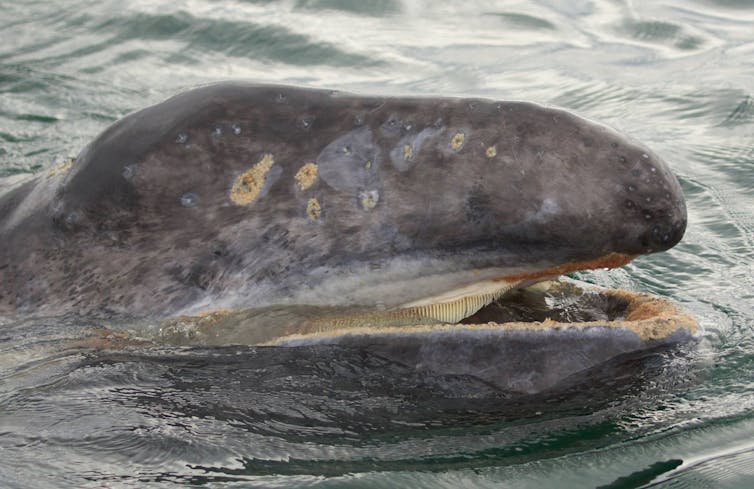
Whaling And Fashion
Whalebone had been used in European fashion since the mid-to-late 16th century when it began to be used to structure women’s farthingales and bodies (hoop skirts and corsetry) and to stiffen men’s doublets and collars. The first references to whalebone in Britain come from the wardrobe accounts of Mary Queen of Scots and Elizabeth I. By the 18th century it was used in foundation garments, bonnets, walking sticks, parasols and even dentistry!
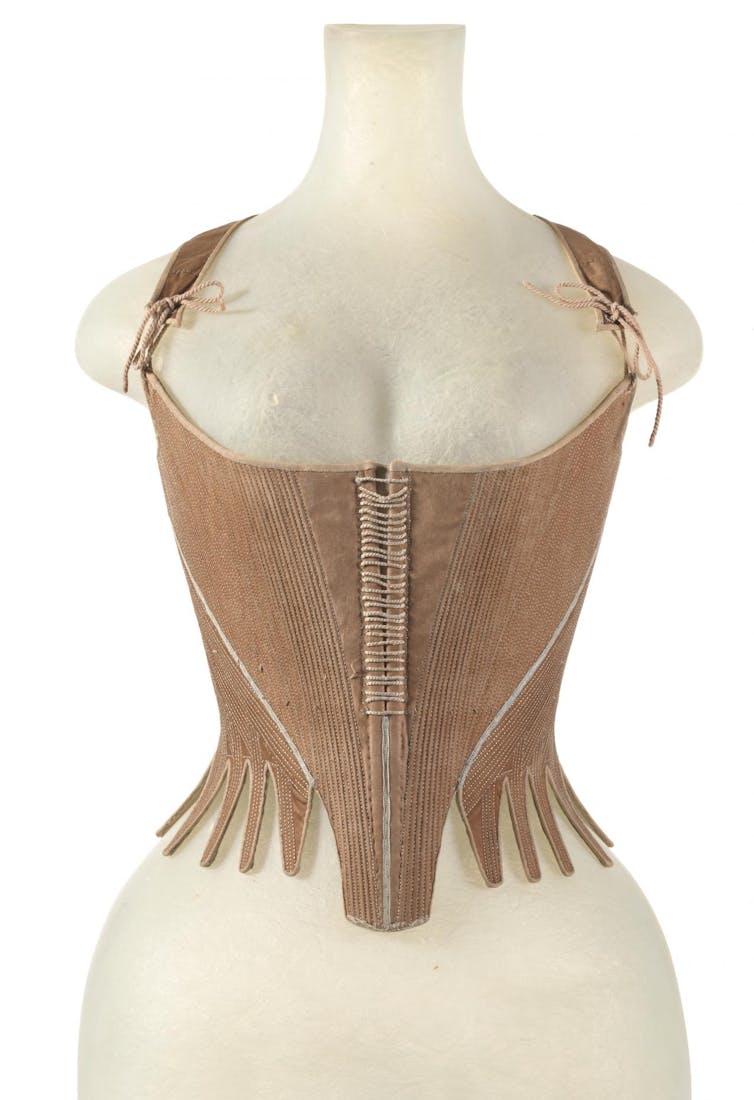
While Charlotte in the Netflix series may claim that whales died so women “could look like this” - pointing to her fashionable outfit shaped by corsets and hooped skirts - fashion was not the driving motivator for whaling during the 18th century.
The primary motivator for commercial whaling for much of its history was oil. During the 18th century, the main species of whales targeted were the Bowhead Whale and the North Atlantic Right Whale. Both species were the “right” whales to hunt as they were slow swimmers that yielded large amounts of blubber.
Once removed from the whale, strips of blubber were placed in large iron vats called tryworks, and slowly boiled until rendered into oil. Oil was used for a variety of purposes: textile manufacturing, soap-making, lubrication and, most importantly, lighting.

As commercial competition between European nations expanded and the want for oil increased, so too did the whaling industry. By the end of the 18th century, British whalers began to venture into the South Atlantic and eventually places in the Pacific such as Australia to hunt baleen whales. They also began to hunt toothed sperm whales for oil and spermaceti.
Baleen was a useful and valuable byproduct, but it was not the main motivator for the whaling industry in the 18th century. It was not until the late 19th century, when petroleum products replaced the need for oil, that whales were killed primarily for their baleen.
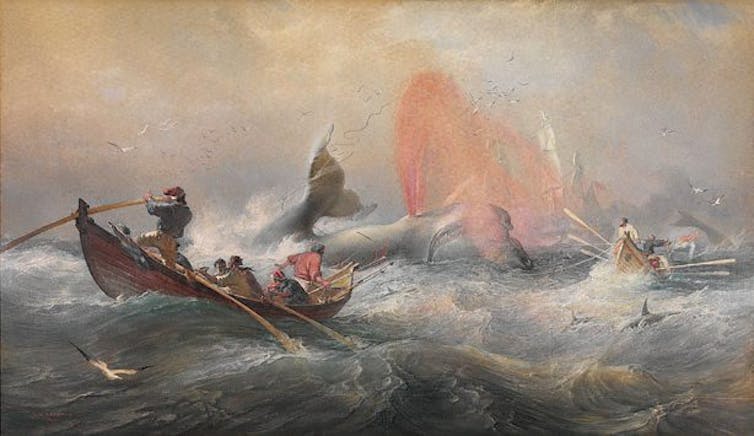
Whalebone Corsets: Dangerous?
Soon after the expansion of whaling, Europeans began to realise the unique properties of baleen that would make it highly valuable for centuries to come: it was strong but flexible and lightweight. It could also be moulded into various shapes with heat. Essentially, it was a natural plastic and used in ways we use modern plastic now.
Court cases from the 18th century attest to the lightness of whalebone stays and the elasticity of whalebone within them.
This is a far cry from the description given in Queen Charlotte: A Bridgerton Story. Still, just as modern underwires in bras can come loose, sometimes baleen could stick out of the top and bottom of a corset, poking women in the underarms or hips. However, these were easily fixed by women or their staymakers.
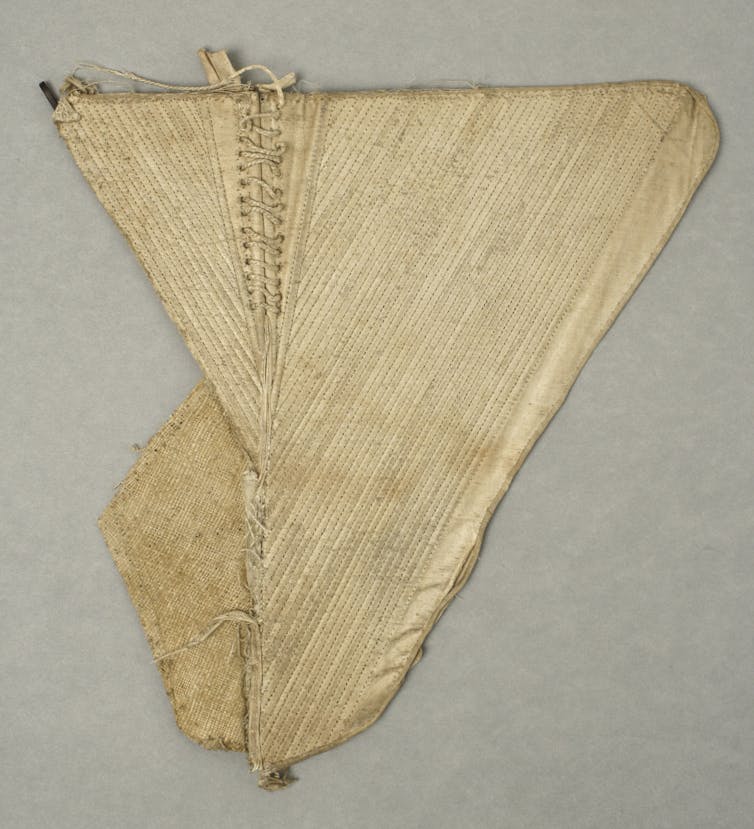
While film and television may continue to make us hate corsets with their emphasis on tightlacing, which was far from the everyday experience of this garment, the reality of whalebone was that it was lightweight, flexible and strong, which made it perfect for use in corsetry that not only created the fashionable shape of the time but also gave women breast and back support.![]()
Sarah Bendall, Research Fellow, Gender and Women's History Research Centre, Institute for Humanities and Social Sciences, Australian Catholic University
This article is republished from The Conversation under a Creative Commons license. Read the original article.
Earliest evidence of kissing pushed back 1,000 years

Lip kissing is an act that’s so natural and common in many present-day societies it is easily taken for granted. But it’s not actually clear whether people have always been kissing, or whether its origins lie in the relatively recent past.
It turns out that the history and causes for kissing are more complex than anticipated. In an article published in the journal Science, we analysed substantial amounts of overlooked evidence that challenge current beliefs that the first record of romantic-sexual kissing is from India around 1500BC.
Instead, lip kissing is documented in ancient Mesopotamia – present-day Iraq and Syria – from at least 2500BC onwards. This basically means that the recorded history of romantic-sexual kissing is at least 1,000 years older than the previous earliest known date.
Why Do We Kiss?
Evolutionary anthropologists have suggested that lip kissing evolved to evaluate a potential mate’s suitability, through chemical cues communicated in saliva or breath. Other proposed purposes for kissing include bringing about feelings of attachment and facilitating sexual arousal.
Lip kissing is also seen in our closest living relatives, chimpanzees and bonobos. This suggests that the behaviour could be much older than our current earliest evidence in humans.
People in ancient Mesopotamia may have invented writing for the first time, though it was roughly contemporary with its invention in ancient Egypt as well. The earliest Mesopotamian writing is from around 3200BC, from the city of Uruk, now in southern Iraq.
The script is called cuneiform, and it was inscribed on moist clay tablets with reeds cut into a little triangular shape. Originally, the script was used to write Sumerian, a language with no known relationship with any other. Later, it was adapted to write Akkadian, an ancient Semitic language.
Though the earliest texts we find are mainly linked to administrative practices, and largely reflect the mechanics of bureaucracy, people developed this mode of writing in subsequent centuries to include other genres of texts.
In the first half of the third millennium BC, myths and incantations materialise in these texts, and even later, private documents about ordinary people. Some of the earliest sources mentioning the lip kiss can be found in mythological texts concerning acts by the gods that date to around 2500BC.
Early Records
In one of these earliest instances, described on the so-called Barton Cylinder, a Mesopotamian clay artifact inscribed with cuneiform, two deities are said to have intercourse and kiss:
with the goddess Ninhursag, he had intercourse. He kissed her. The semen of seven twins he impregnated into her womb.

Later sources, such as proverbs, an erotic dialogue between a man and a woman, and a legal text, form the general impression that kissing in relation to sex, family and friendship was likely an ordinary part of everyday life in central parts of the ancient Middle East from the late third millennium BC onwards.
Still, it seems that romantic-sexual kissing in the open street may have been frowned upon, and it’s possible that it was preferably practised between married couples. Society probably had a number of such social norms regarding ideal behaviour. But the fact that such norms existed point to a widespread practice.
Single Point Of Origin?
Evidence suggests that the lip kiss was practised at least in the ancient Middle East and India. This contrasts with previous observations about humanity’s earliest history of kissing. A manuscript from India dated to about 1500BC, for example, has has previously been used to propose that the kiss was brought as a cultural practice westward from there. The older evidence from Mesopotamia suggests we can dismiss that scenario.
Considering the wide geographical distribution of the romantic-sexual kiss in ancient times, we believe that the kiss had multiple origins. And even if one were to search for a single point from where the kiss originated, one would have to find it millennia ago in prehistoric times.
A recent anthropological study has shown that the romantic-sexual kiss is not universal. However, there is ancient written documentation suggesting a tendency for its practice in societies with complex social hierarchies.
This raises a question over how widely used the sexual kiss was in the ancient world, especially in societies that cannot be traced because they did not use writing. Although some societies may not have practised the romantic-sexual kiss, we argue it must have been known in most ancient cultures, for example due to cultural contacts.
But if future research should show that lip kissing cannot be considered near-universal in the ancient world, it will be interesting to consider the reasons why this was not a common practice. Surprisingly, the history and culture of kissing is a complex tale with many aspects yet to be revealed.![]()
Sophie Lund Rasmussen, Postdoctoral fellow, University of Oxford and Troels Pank Arbøll, Assistant Professor in Assyriology, University of Copenhagen
This article is republished from The Conversation under a Creative Commons license. Read the original article.
From bird poo frogs to alligator snapping turtles – here are nature’s masters of deception
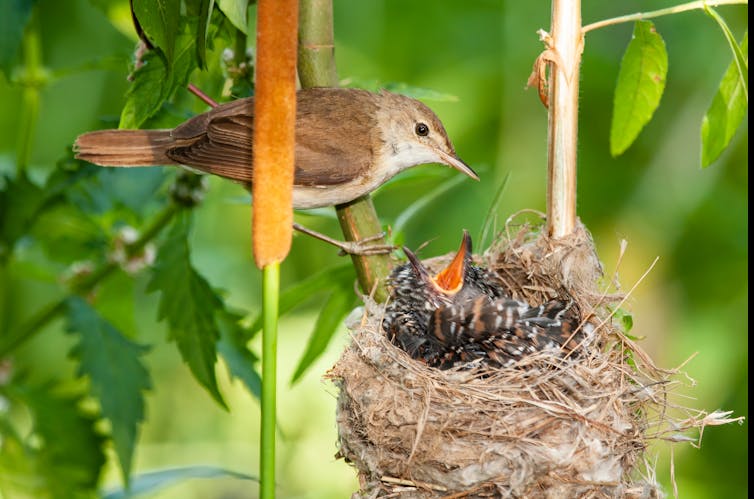
In nature, there are winners and losers. The winners gain survival and reproduction, while the losers generally die. To gain an advantage, winners may adopt strategies that involve elements of dishonesty or deception.
Most people are aware of the cuckoo, a bird that is notorious for its deceptive nature, duping other species such as reed warblers into raising their offspring. The cuckoo and reed warbler is an example of an evolutionary arms race – the species are evolving escalating adaptations to win the war.
Currently, the cuckoo is winning this particular battle. But there is evidence that the reed warblers are fighting back. Research suggests that reed warblers are evolving ways to recognise cuckoo eggs and eject them from their nests.
In the natural world, deception has evolved in many species as a way to increase their success. Here are five species that are currently winning their evolutionary arms races.
1. Bird Poo Frogs
The bird poo frog Litoria naispela is a tree frog that was recently discovered in Papua New Guinea. This aptly named species is marked with white splatters that resemble bird poo. Unlike camouflage, where organisms blend in with their background, masquerading involves species evolving to look like something else – in this case, an inanimate object that very few things want to eat.
This is not the only species that has evolved to protect itself from predators by looking like poo. Plenty of other frogs and even spiders adopt the same tactic to avoid being eaten.
2. Oriental Pratincole
Some species such as the hognose snake often fake death to avert the attention of predators. Others, like the mimic octopus, can even impersonate several dangerous species.
By contrast, some animals use themselves as a distraction to lure predators away from their vulnerable offspring. Oriental pratincoles (a bird species native to the warmer parts of south and south-east Asia) often feign a broken wing, presenting themselves as easy targets to tempt predators like birds of prey away from their nests before flying to safety at the last moment.
This deceptive behaviour was previously thought to be restricted to shore birds that nest on the ground. But recent research suggests that it’s more widespread – occurring in nearly 300 bird species.
3. Nursery Web Spider
Like many invertebrates, the female nursery web spider – named so due to the silk nursery she spins to keep her spiderlings safe – often eats the male after mating to gain vital nutrition to produce eggs. But if the male can survive after mating, he can potentially go on to father more offspring with other females.
So the males often arrive with presents of insects wrapped in silk. While the female is distracted by unwrapping and eating the tasty gift, the male is able to scurry away to safety – it’s a win-win situation.
However, these gifts take time and effort to acquire. So some sneaky males have evolved to give fake gifts of no nutritional value to the female like inedible plant seeds or empty insect exoskeletons. By the time she realises the scam, the male has gone.

4. Bee Orchid
Some species even go as far as tricking another species into finding a mate for them. Although some bee orchids are capable of self-fertilisation, reproducing with another plant promotes outbreeding and genetic variety, which is crucial for adapting to changing environments. But as bee orchids aren’t capable of moving across land themselves, they have evolved a tactic whereby one of their petals resembles the female of a solitary bee species.
When the male bee lands on the orchid, believing it to be a female, he attempts to mate with it. During this process, pollen from the orchid gets passed to the male bee. When the bee departs and is fooled again by another orchid, it passes on the pollen from the first plant.
Being specific about what insect visits you is beneficial for the orchid as the bee goes straight to another bee orchid, without stopping to visit other plants and potentially losing the pollen.
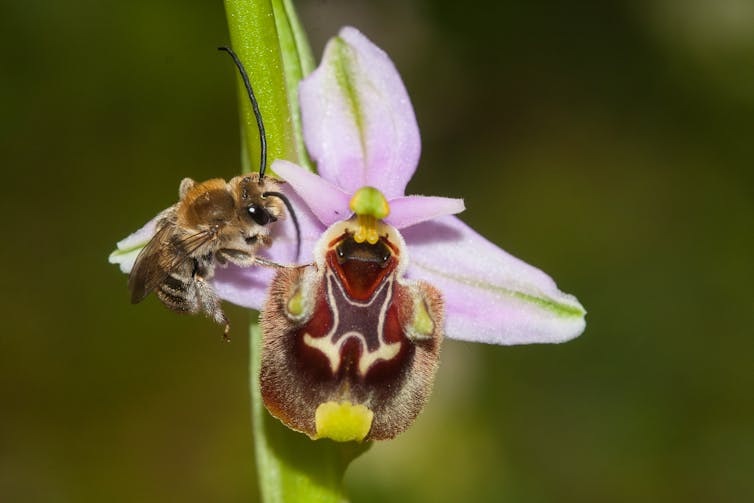
5. Alligator Snapping Turtle
Perhaps the best deceptions have evolved in the fight to acquire food. Many predators are camouflaged so well with their surroundings that it is almost impossible to see them.
If you are a large and slow predator, sitting and waiting for prey is a good strategy. But it can often be futile. So some of the most novel trickery has involved the evolution of a fishing lure.
The tongue of the alligator snapping turtle, a species that sits and waits for prey in murky freshwater habitats in the US, has evolved to mimic a wriggling worm. It acts as bait to attract small fish that the turtle snaps its mouth shut on, then eats.
Humans condemn deception and view it as negative – people want to avoid being duped. But in nature, conning others is instead an essential strategy for organisms to exploit their environments and ensure their survival and reproduction. From the clever mimicry of bird poo frogs and bee orchids to the tactical feigning of injury by the oriental pratincole, these examples demonstrate the extraordinary lengths some species go to guarantee their success.![]()
Louise Gentle, Principal Lecturer in Wildlife Conservation, Nottingham Trent University
This article is republished from The Conversation under a Creative Commons license. Read the original article.
Friday essay: what is ‘time activism’ – and why do we desperately need it?

When my daughter was in the early years of primary school, her class was asked what their parents’ hobbies were. My daughter piped up promptly with mine: “Reading, sleeping, and drinking wine.” This disclosure of my deficiencies — among the more well-adapted offerings of cycling, gardening, Pilates practice and marathon-running — got me in the soft nervous centre of my self-worth.
Sleeping, reading and drinking wine are three things I have always felt guilty about. They are emblematic of my chronic tendency to procrastinate, my lax self-regulation, my failure to use time productively. Excluding my contribution to the wine industry, they have no dollar value. They produce nothing of immediate, measurable value. They have no rounded sense of task completion at their end.
All of them require a loose and idle relationship with time. Reading US essayist Sheila Liming’s Hanging Out: The radical power of killing time, I realise that, in indulging my dubious pastimes, I am in fact simply “hanging out” with myself.
And “hanging out” — that generous, time-lazy, day-squandering activity that seems to belong only to childhood and adolescence — may well be, Liming says, not only a “survival mechanism” and deeply human need, but an act of refusal, an act with a “radical character”.
Saving Time: Discovering a life beyond the clock – Jenny Odell (The Bodley Head); Hanging Out: The radical power of killing time – Sheila Liming (Black Inc.)
Reading Liming’s effortlessly intelligent book, I begin to more deeply understand where my guilt comes from. It’s not just coming from my liver. And I’m not sleeping ten hours a day just to refresh myself for more productive work. I don’t read merely to become erudite and informed enough to pen articles like this.
I’m guilty because hanging out — either alone or with friends — has become anxiety-ridden, overthought, over-structured, over-laden. Unfree. All those other things I should be doing. And I can’t dismiss them, because they have colonised my very being.

Liming locates this colonisation — and by extension the guilt of the modern Western world — partly in the Protestant work ethic and the policing of self that equated idleness with the devil’s work. Idleness — always viewed suspiciously, especially if you were poor — became increasingly a moral sin that required vigilant resistance.
It’s a phenomenon Barbara Ehrenreich also wrote about in her 2010 critique of the US positive-thinking industry, Smile Or Die: How positive thinking fooled America and the world: a deep Calvinist contempt for the unimproved self that seeped into the bones and flesh of America, holding the individual responsible for their misfortunes in the face of brutal systemic and structural inequity.
This “pull yourself up by your bootstraps” culture (a phrase which, as Jenny Odell points out in Saving Time: Discovering a Life Beyond the Clock, is in itself oxymoronic) has metastasised into a full-body brutality driven relentlessly at the self: multi-directional, time insistent, waste-not want-not.
The strapping and tethering of time to the ends of free-market productivity rules out the conditions required for stretching and growing. We’ve known this, of course, since Marx’s Das Kapital (Capital) of 1867 – and we know it in our bodies on a daily basis, when we shed time like skin, until we are red and raw at the end of the day.
Here is where fun – where “hanging out” – becomes a powerful act of resistance. Fun is suspect because it hovers and refuses to land; it nets nothing and feeds the moment, not the bottom line.
“Fun threatens to infect and pervert the sanctity of labour,” writes Liming, “and also the power of those who would have us do more of it, for free, by cramming more into the slim, pre-existing spaces of paychecks and contracts.”
Lassitude and playfulness, she writes, are necessary precursors to invention, imagination, connective social thought and behaviour. Sometimes a revelatory idea needs to come out of nowhere and not out of the focused training of the mind on a problem.
Commodified fun, of course, makes a profit for someone somewhere, and relies on the often poorly paid labour of someone somewhere. But fun that exists outside this space — whether it’s two bodies coming together, or 20, or a hundred; in a park or on a beach or in someone’s pebble-mix back garden — can be a powerful, soul-replenishing “No” to the warped logic of the world.
Childhood Time And Jamming
Was the actual texture of life, of human interaction, different in childhood: when time swam and wandered and then ebbed with the sun and the call to dinner?
Who is to say that the time I experience now — task-driven, minute-counting — is conceptually truer than that experienced by children? “When is it Christmas again?” I remember asking my mother. She shook her head sadly: “Not for many months. Not till well after your birthday.”
How was it possible to wait through so much time? I imagined it like mud or treacle — a stretch of sticky, recalcitrant experience to be trudged through. I came to the compelling conclusion there must be a trick adults didn’t tell you about. That you just woke up one day to find you were old.
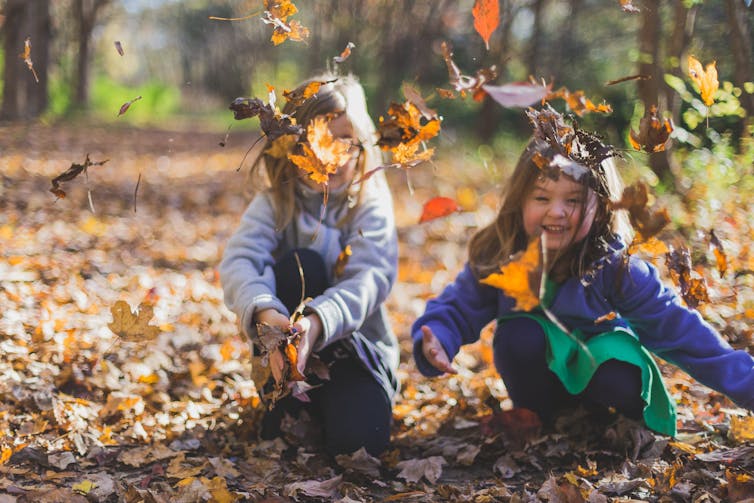
Songs come to mind. Pink Floyd, describing how you catch up with the Sun, only to find it coming up behind you again. Ageing you every time.
Plays and literature come to mind: the purposeless waiting of Waiting for Godot, the real-time deterioration of Dorian Gray’s portrait, the backwards trajectory of Benjamin Button. Time ticks ineluctably down. Or is a thing we must fill – a container, with deeds and experiences and successes – while we can? Or a thing to be escaped: the oldest bogeyman in the book.
Hanging out allows us to reconceptualise time. For me, Liming’s most potent example of differently experienced time was her chapter on jamming as a form of hanging out.
A group of musicians comes together and, with trust and space, their creativities converge into a time-swelling conversation. It is a conversation that is ephemeral, tenuous, delicate sometimes, robust sometimes. And it comes from a place of attuned listening and connecting.
To improvise with other musicians involves the courage to magnanimously court error. It doesn’t capture time so much as fully inhabit it, in a dialogue in many parts and many voices. And because of its ephemerality, it eludes commodification. If the “record” button is never hit, it exists in uncommodifiable space and time.
Reading Liming on jamming and improvisation, I was reminded of the title story of E. Annie Proulx’s 1995 Heartsongs. In this story, we meet Snipe, a no-hoper conman, out for the next exploitable opportunity when he stumbles on the hokey mountaintop Twilight family.

He can’t quite work out the relationships between the family members, but at the end of a meal he is invited to, he is welcomed into their family musical circle. Hardly a word is uttered in this strange after-dinner ritual, but when the Twilights pick up their instruments and begin to play, Snipe becomes increasingly excited: propelled by the rhythms and strands and subtleties they create.
He sees at once that this is something beautiful and exquisite, precious and rare. Invaluable. But when he proposes to the Twilight family that he manage them, tour them — that there are unimaginable profits to be made — they are not only indifferent, but reject his proposition out of hand. Snipe slinks away, after various fruitless efforts to convince: he has no frame of reference for their refusal.
I kept coming back to Heartsongs while reading Hanging Out — in fact, it’s the only story I recall in Proulx’s collection. It is a lesson in humility, I think: stubborn, ethical humility that remains impervious to the marketing imperatives of the world. Improvisation, it tells us, can be a way of living. Time does not have to be turned into dollars.
‘Politically Subversive’ Sleep
My battle with excessive sleep, and the “waste of time” it represents has endured throughout my whole adult life. I have tried to curtail my sleeping, tried to sleep like others do (less), tried to stay awake in front of a computer screen when my eyes are rolling back in my head.
I have felt incessantly guilty about my need for sleep, and frightened when I read articles that tell me too much sleep will shorten my life. I have slept under desks in classrooms, on office floors, on couches in libraries and seats in parks. I have slept at a live music venue while the band played.
And I have slept at parties. Many, many parties. In my twenties, I threw large dinner parties where I’d spend the whole day cooking and preparing, and then, at 9pm, when the food was eaten, I’d go off to my bedroom and sleep. Having babies gave me the perfect excuse; I’d take them off to bed, breastfeed them, and never resurface.
There must be others like me, I thought. I briefly entertained the notion of instigating a Sleep Club in Melbourne’s CBD, a place where people like me could go to safely sleep in between other activities. But how to ensure Sleep Club didn’t turn into Sex Club? How to pay for sheets and blankets and mattresses (and CBD rent)? And how to make Sleep Club profitable? Here was the very crux of the problem: how could I charge people to sleep? And wouldn’t that contradict the whole purpose of my idea?

In Saving Time, Jenny Odell tells us of activist and poet Tricia Hersey’s organisation Nap Ministry, established to address “the sleep deprivation of enslaved peoples and their status as commodifed bodies”. Nap Ministry encourages collective napping experiences, as well as performances and workshops geared to the reinstituting of sleep as a human right.
Hersey claims sleep as a politically subversive action (which helps me legitimise my own sleeping habits). But in Hanging Out, Sheila Liming writes of sleeping in a way that reveals to me what perhaps I was seeking in my own soporific social withdrawals.
Sleeping at parties, she writes, provides the “serenity of effortless inclusion”. It is safety made even safer by the murmur of social pleasure: a kind of umbrella or arc of exuberant warmth. This same hum of warmth and sociality and protection soothed me as a child when my parents’ dinner parties extended late into the night.
In this way, the pleasure of “hanging out” can be experienced vicariously. Liming cites Audre Lorde’s poem The Electric Slide Boogie, in which a dying woman listens to a party in full swing on the other side of her wall. There is no “Rage, rage against the dying of the light” in her musings, but a soft, gentle and ultimately generous lament: “How hard it is to sleep/in the middle of life.”
Time And The Extraction Of Labour
When did the productive use of time begin to be a measurement of human worth? Before the advent of modern clock-time, Jenny Odell tells us, the “tools of coordination” — in Western Christendom at least — were bells, enforcing the “temporal discipline” of Benedictine and Cistercian monks.
How gentle and undemanding bells seem to us in the 21st century; a languorous form of time-marking, which called us to prayer and food and sleep. Last year I was fortunate enough to spend a week in the tiny town of Sivignon in southern France: there I forgot about my watch all together, guided by half-hour chimes that didn’t even interrupt my sleep, though they continued unabated throughout the night.
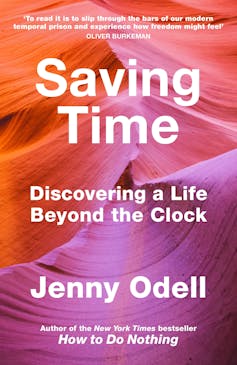
In Saving Time, Odell locates the invention of fungible time — time that can be broken down into smaller and smaller measurable, productive increments — in the spreadsheets of Southern plantation owners.
Modern time, she suggests, came about as a product of slavery and its reduction of human worth to the extraction of labour. Reading this, it’s hard not to conclude humans are the inherent exploiters of other humans by any technology available or inventable – including the shared technology of time. Some of us have possessed time, and, in the process, dispossessed others of it.
Centuries years later, we live in a world where time is even more minutely monitored. Workers might not clock in and out on the job anymore (old-fashioned punch cards at least marked a beginning and an end to a day’s work), but their time is as effectively surveilled by keystroke monitoring, key performance indicators, and continuous improvement cycles – winnowing lives into smaller and smaller particles of data. Work bleeds into leisure and leisure bleeds into work; clear boundaries no longer exist.
Leisure itself has become merely another opportunity for self-optimisation (the above-mentioned marathons and Pilates). Slowness — initially a refutation of the obsessive equating of busyness with moral good — has been turned into its own form of consumption, and a form of consumption quarantined for the well-off. Slow-cooking, slow-living, “self-care” can’t be indulged by those frantically trying to make ends meet with a series of casual jobs in a gig economy. Time, writes Odell, has become “the punitive dimension”.
The “science of time”, most notably formalised in Frederick Winslow Taylor’s 1911 The Principles of Scientific Management, has given us a linear, task-oriented way of making sense of ourselves. Drawing on the work of German philosopher Josef Pieper, Odell argues leisure should be “vertical” not “horizontal”: “[T]rue leisure requires the kind of emptiness in which you remember the fact of your own aliveness.”
Many of us experienced this emptiness during Covid; we became “estranged from common forms of marking time” and thus more alive to time’s natural rhythms. We took long walks and noticed new buds on trees, watched fledgling falcons rouse from nests on the roofs of skyscrapers, heard the birdsong that had always existed behind the incessant industry and traffic of daily life.
In retrospect, COVID lockdown might seem merely a period of hiatus, from which the world has decisively returned. But there is political potential in the experience and the way it released us – briefly anyway – from our normal temporal subjugations.
Odell cites 19th-century labour leader Ira Steward to make further sense of this experience. He described the experience of leisure as a “blank — a negative — a piece of white paper”, not something to be filled or pre-inscribed. Steward’s “blank”, writes Odell, “was less like foam padding keeping a hierarchy in place than like a gas whose every increase carried the potential of more cracks in the system.”
In a world of temporal urgencies — of corporate and political greed; climate crisis; economic, race and gender inequality — we need these cracks. And we need the gas that creates them.
Women’s Time ‘Didn’t Economically Exist’
Central to any discussion of time is the way women have experienced the economic devaluation of their time. Arlie Russell Hochschild wrote in 1989 of the way feminism in effect created a “second shift” for women.
I’ve often thought of this as feminism’s gift to men, releasing them from the unilateral burden of bringing in a wage, but without repositioning them to take up their share of child-rearing and housework: in this brave new world, women simply did both forms of labour, paid and unpaid.
“Where women are concerned,” wrote Mariarosa Dalla Costa and Selma James, proponents of the 1970s Wages for Housework movement, “their labour appears to be a personal service outside of capital.”
Odell tells of the first New Zealand member of parliament Marilyn Wearing, who studied the provisioning for women’s time and unpaid labour in existing economic structures for her 1988 book If Women Counted: A New Feminist Economics. She found, quite simply, that women’s time, and women’s work, didn’t economically exist.

And if women’s work time doesn’t exist, what of women’s leisure time? In 1929, in A Room of One’s Own, Virginia Woolf asked:
[W]hat alternations of work and rest [might women] need, interpreting rest as not doing nothing but as doing something but something that is different; and what should that difference be? All this should be discussed and discovered.
As with so many of Virginia Woolf’s questions, the answers remain at large.
Were women in the past more wretchedly used by time? Or are the uses just different now: the burdens outsourced, displaced onto others so new burdens might be absorbed? I’ve often wondered, how — when they hardly had hot water and ran their clothes through a mangle after sloshing them in sudsy water with a paddle — women of the past managed so decisively to outdo us when it came to keeping the world clean?
I haven’t run an iron over an article of clothing in years. Boiling things, steaming things, soaking things, making vinegar and bicarb solutions, using lemon juice in remarkable ways to get out stains. Hard-bristled floor brushes on flagged floors, followed by mopping (with boiled water). How did they get all the grit out of the tiles and the baked on charcoal out of ovens? Did they use their time better than us?
In a certain part of Malaysia, Odell tells us, a woman’s measurement of time prevails; to the question “how long does it take to get there?” the answer might be “three-rice-cookings”. I like this remoulding of time in the shape of women’s traditional chores. How long does it take to get there? “Four nappy changes.” “Six loads of washing.” “Thirteen bedtime stories.”
Redefining Time
Odell leads us from our small, narrow, self-flagellating experience of time to its deeper manifestations and inhabitations. She begins with moss: invisibly moving, formidably growing, in a way that is reminiscent of Sylvia Plath’s poem Mushrooms. In the creeping pathway of moss that grows in a cactus planter on her windowsill, Odell observes continuity at work, the feeding of time with more time: “Tomorrow was growing raw out of the husk of today.”
Plants, Odell writes, are “the ongoing materialisation of time itself”. And in rocks and stone and pebbles we bear witness to a geological time that is past, present and future all at once. We cannot suppress time or nature, or the nature–time confluence of events such as landslides. The subjecthood and agency of the non-human, of the apparently inert, teach us something that clocks cannot.

As do Indigenous notions of time. Bill Gammage’s 2012 book The Biggest Estate on Earth was revelatory upon publication not because of its carefully organised evidence of Indigenous plant cultivation, but because of the Indigenous conceptualisation of time the book conveyed.
Indigenous time was too vast to make fungible: it was understood across huge expanses of land, imagined well beyond the lifetime of the individual, connective of past, present and future. It was a conceptualisation of time so foreign to colonisers, the architects of fungible time, that it was ungraspable, only demeanable.
In measuring time so finely, in cutting it down and down into microscopic forms of accountability, we have demeaned time. We have made it sad and attenuated. We deny it its power and sanctity.
Modern Time Feels ‘Poisonous’
Strangely, while reading Odell’s and Liming’s books, and thinking about this article, my wristwatch stopped working. It has remained on my arm regardless, stuck at an eternal 11:10, and I keep referring to it out of habit. I wish this were a source of calm for me, that it made me stop and think in ways other than minutes and hours. But it doesn’t. It makes me ill at ease, and reminds me of yet another thing to put on my to-do list (get battery).

I can’t find the “temporal latitude” to disengage myself from the anxieties of a stopped watch, because I don’t live on a mountain or in a cave. I have a mortgage to pay and children to shepherd properly into adulthood. I don’t have the time to be loose, or big, about time. And this is the crux of so many of our current problems and neuroses. We know it. We know how modern time feels in our bodies — like quicksilver, poisonous, impossible to pin down.
Both Odell and Liming propose “time activism” as part of a larger project to address the urgent issues our world faces. We need a “strategic confiscation of time,” Liming says: we need to kill time good and dead and let it resurface in its own natural, communal rhythms – informed by our needs and not our labour value.
But perhaps we also need to treat it more gently, to tend it with care and understanding. “Would it be possible,” writes Odell, “not to save and spend time, but to garden it – by saving, inventing, and stewarding different rhythms of life?”![]()
Edwina Preston, PhD Candidate, The University of Melbourne
This article is republished from The Conversation under a Creative Commons license. Read the original article.
Vale George Annells CHAMPION

Lifting The Standard Of Food And Nutrition In Aged Care
- triage food hotline calls based on the nature and level of risk to older people
- coordinate up to 720 provider spot checks annually, with 10% of spot checks of the highest risk services to have accompanying dietitians
- support providers to build capability by linking them with education programs
- engage Dementia Australia experts to promote nutrition and food enjoyment for people with dementia.
Care Finders Program Launches In Northern Sydney
- Aged care services for the first time or if they want to change services.
- Community supports.
- Phone or visit My Aged Care and arrange an assessment.
- Attend and provide support at the assessment.
- Find and short-list aged care providers in your area.
- Complete forms and understand aged care service agreements.
- Check in once services are up and running to make sure everything is OK.
- Help arrange reassessments where needed.
- Solve other challenges and connect you to supports in the community, such as health, mental health, housing and homelessness, Carer Gateway, drug and alcohol services and community groups.

Giving Up Driving Is A Senior’s Nightmare – But Smart Help Is Here
- UNSW and National Seniors launched a joint research report this week about older people and advanced driver assistance systems (ADAS).
- The study surveyed 1,300 NSA members and affiliates aged 60-98 who had a current driver's licence.
- Generally, older drivers do not use ADAS technologies regularly, except for conventional cruise control.
- Most of those surveyed welcomed the new technology but question its reliability and safety in all conditions.
- Diminished hearing and eyesight.
- Slower decision making.
- Slower reflexes and reduced agility.
- Reduced muscle strength and response.
- Chronic conditions requiring medications that affect reflexes and reaction times.
- Cruise control was far and away the most well-known and popular ADAS – more than 40% of participants regularly use it.
- Traffic-assist – which warns of oncoming traffic when reversing – and lane change warning tied for second at a much lower 23%.
- Park assist was least popular, used by fewer than 5% of study participants.

Seniors Miss Out On Vital Crohn’s And Colitis Support
- Abdominal pain.
- Frequent diarrhoea (sometimes mixed with mucus and blood) and need to use the toilet.
- Tiredness, fatigue.
- Raised temperature, fever.
- Loss of appetite, weight loss.
- Anaemia (reduced level of blood cells).
- Joint pain.
- Mouth ulcers (sores).
- Eye inflammation (uveitis and episcleritis).
- Liver inflammation (Primary Sclerosing Cholangitis).
- Skin rashes.
When someone living with dementia is distressed or violent, ‘de-escalation’ is vital

Today’s reporting about the alleged tasering of a 95-year-old woman living at the Yallambee Lodge aged care home in New South Wales has brought the issue of behaviours and psychological symptoms of dementia into sharp focus.
Over half of those living in residential care have a dementia diagnosis and up to 95% of those living with dementia will experience such behaviours at some point during their passage through the illness. Common behaviours that might be shown by those living with advanced dementia include agitation, anxiety, attempts to leave care, aggression, apathy, sleep disturbance, aimless pacing, psychosis and aggression.
The full circumstances surrounding Wednesday’s events are unclear and they are subject to an investigation by police. That may take some time. What is clear, however, is that there is much room for improvement in the way behaviours and psychological symptoms of dementia are managed in residential care. Situations that end with police involvement should be avoided.
Calling For Help
In its final report in March 2021, the Royal Commission into Aged Care Quality and Safety recommended “all workers engaged by providers who are involved in direct contact with people seeking or receiving services in the aged care system undertake regular training about dementia care and palliative care”.
Currently, it is not infrequent for police to be called to respond to incidents in care homes. While programs have been implemented to better equip police to respond to the specific need of those living with dementia this work is still in its infancy.
Aggression and agitation are two of the most common behavioural symptoms that lead to referral to specialist support services.
Dementia Support Australia is a Commonwealth-funded service that has supported aged care homes and home-based carers in managing behaviours and psychological symptoms of dementia since 2016. There were 8,702 referrals to the service between January and June 2022. The number of referrals has increased in recent years.
As an organisation at the frontline of dementia support, we extend our deepest sympathies to the 95-year-old aged care resident, her family, Yallambee Lodge staff and everyone else touched by this devastating incident.
One of the advantages of having a national service such as this is that it has enabled the development of a national database that documents not only the nature and severity of the behaviours prompting the referral, but those factors that are most commonly identified as triggers for these behaviours.

3 Leading Causes
Aggression and agitation are not diagnoses in themselves, but symptoms. Symptoms have causes, and these must be identified in order to adequately address behaviour.
The leading contributing factors we have identified in relation to behaviours are:
1. Unidentified or under-treated pain
This is relevant in over 50% of the cases we see. Earlier research on pain management in the setting of advanced dementia has shown those with a dementia diagnosis who are admitted to hospital with hip fractures tend to be prescribed only a fraction of the analgesia given to those without dementia.
2. Carer approach
Care staff receive only minimal levels of training in dementia care as part of their basic qualification and are often unfamiliar with communication strategies tailored towards those with cognitive impairment.
Currently, the minimum qualification for a personal care worker involves no compulsory units in dementia competency. While we do not know the full circumstances from the events this week, the Royal Commission has made recommendations to improve care for those living with dementia. Carer approach is an issue in about a third of the cases we see.
3. Over- and under-stimulation
In about one quarter of Dementia Support Australia cases boredom and loneliness and/or an environment that does not take into account the specific needs of those living with dementia are an issue.
Other common causes of changed behaviour include mood and anxiety disorders, communication difficulties, delirium, sleep problems and poor carer knowledge of the specific likes/dislikes of the individuals they are caring for.
Prevention And Calming Things Down
The best way to manage most behavioural changes is to prevent the circumstances that lead to their development in the first place. Prevention is always better than cure.
Once behaviours are occurring, there is no single correct way to de-escalate them. The appropriate de-escalation strategies will always be specific to what has caused the altered behaviour in the first place.
Unfortunately, when behaviours have escalated to the point where police attendance is required, the responding officers are unlikely to be equipped with the necessary information about the person and their circumstances. That means they won’t be equipped to respond with effective and specific de-escalation strategies.
One case in the United States from 2020 involved the arrest of a 73-year-old woman living with dementia, who had left a local store without paying for items worth a small amount. A lawsuit filed following the arrest alleged it resulted in a fractured arm and a dislocated shoulder, and raised national concerns about the way first responders interact with those experiencing cognitive disabilities.
Australia needs to learn from yesterday’s events and respond.
If you are caring for someone with dementia there is help available. Dementia Support Australia is a free service, fully funded by the Australian government. Referrals can be made 24-hours a day by calling 1800 699 799.![]()
Steve Macfarlane, Head of Clinical Services, dementia Support Australia, & Associate Professor of Psychiatry, Monash University
This article is republished from The Conversation under a Creative Commons license. Read the original article.
State Of The Older Nation (SOTON) 2023: New Research Shows Age-Related Discrimination Is Rampant In Western Australia
- Identify as Aboriginal or Torres Strait Islander: 55% are renters
- Are not in paid employment: 47% are renters
- Have a disability: 38% are renters
- Identify as LGBTQ+: 38% are renters
- Are single: 37% are renters
- Their primary source of income is a government pension: 34% are renters.
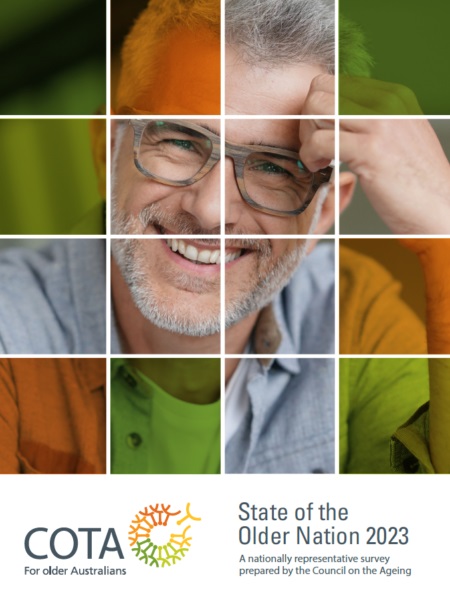
Pittwater RSL: Seniors Show + Lunch 2023

MEN’S TABLE FOR PITTWATER, MONA VALE AND SURROUNDING AREAS

Am I too old to build muscle? What science says about sarcopenia and building strength later in life

Sarcopenia is the progressive and accelerated loss of muscle mass and strength as we age.
The term was coined in the 1980s, and the condition has been recognised as a disease for less than a decade, but the concept is as old as time: use it or lose it.
But what if you’re in your 60s, 70s, 80s or 90s? Is it “too late” to build muscle and fight sarcopenia? Here’s what the research says.

Sarcopenia Isn’t Just Unfortunate. It’s Dangerous
All of us will start to gradually lose muscle from our mid-30s, but this loss accelerates in later years. For up to 30% of adults aged over 60, the declines are substantial enough to meet the definition for sarcopenia.
Sarcopenia increases your risk of falls, fractures, hospitalisation, loss of independence and many other chronic diseases.
However, people who are active in early life and maintain this as they age can delay or prevent the onset of sarcopenia.
The good news is it’s never too late to make a start, even if you are already experiencing the debilitating effects of sarcopenia.

What The Science Says
Resistance training is the most effective way to build and strengthen muscle at all ages. That means things like:
lifting free weights like dumbbells
using machine weights, like you find in a gym
using resistance bands
bodyweight exercises such as push-ups, squats, wall-sits or tricep dips.
It’s OK to start with even very light weights, or do modified, easier versions of bodyweight exercises (for example, you might do a shallow squat rather than a deep one, or a push-up against a wall or windowsill instead of on the floor). Something is always better than nothing.
Aim to make the exercise harder over time. Lift progressively heavier weights or do increasingly harder versions of bodyweight or resistance band exercises. This is called progressive resistance training.

Clinical trials have consistently shown all adults – even very frail people over the age of 75 – can make significant gains in muscle mass and strength by doing progressive resistance training at least twice a week. The improvements can be seen in as little as eight weeks.
One seminal study included ten frail, institutionalised 86–96 year olds who did a high-intensity progressive resistance training program.
After just eight weeks, the average mid-thigh muscle area had increased by almost 10% (which is equivalent to the amount of muscle typically lost over a decade) and leg strength increased by about 180%.
In other words, these older people were almost three times stronger at the end of the short training program than before.
It really can be done. British-Swiss man Charles Eugster (1919–2017), for example, took up progressive resistance training in his late 80s after noticing a decline in his muscle mass. He went on to become a bodybuilder, and in 2012 gave a TEDx talk titled “Why bodybuilding at age 93 is a great idea”.

What If My Doctor Has Told Me To Lose Weight?
Many older adults have obesity, which increases the risk of cardiovascular disease and type 2 diabetes.
They’re often told to lose weight, but any dieting (or other strategy aimed at weight loss) also usually causes muscle loss.
Losing muscle mass in older age could increase the risk for many common chronic conditions. For example, muscle is crucial to keeping blood sugar levels under control, so excessive muscle loss could blunt the benefits of weight loss for people with type 2 diabetes.
If you’re losing weight, it’s important to try to minimise muscle mass loss at the same time. How? Progressive resistance training.
By combining progressive resistance training with weight loss, one study found the resulting muscle loss is negligible. (It’s also important that if you are dieting, you are still eating enough protein, so your body has the ingredients it needs to build new muscle).
Exercise training during weight loss can also prevent bone loss, which reduces fracture risk in older people.

Aim For At Least Twice A Week – More If You Can
Whether or not you’re trying to lose weight, and regardless of whether you think you have sarcopenia, all older adults can benefit from strengthening their muscles.
Even if getting to a gym or clinic is hard, there are plenty of resistance exercises you can do at home or outdoors that will help build strength.

Talk to a health professional before starting a moderate to high intensity progressive resistance training program. An accredited exercise professional can help design a program that suits you.
Generally, we should aim to do progressive resistance training at least twice a week.
Try to target 8–10 muscle groups, and start out at about 30–40% of your maximum effort before progressing over time to 70–80% of your maximum.
As the name suggests, it is key to progressively increase the effort or challenge of your program so you can feel the improvements and achieve your goals.
It’s never too late to start training for your fight against sarcopenia and loss of independence in older age. The health benefits will be worth it. As Socrates said in the 4th Century BC:
is not the bodily habit spoiled by rest and idleness, but preserved for a long time by motion and exercise?
David Scott, Associate Professor (Research) and NHMRC Emerging Leadership Fellow, Deakin University and Robin M. Daly, Professor of Exercise and Ageing, Institute for Physical Activity and Nutrition, Deakin University, Deakin University
This article is republished from The Conversation under a Creative Commons license. Read the original article.
Heart Health Assessment Rebate Extended
Volunteers In Aged Care Consultation Open
- all people who volunteer in the aged care sector
- all those who work with volunteers in their role as a volunteer manager or as an aged care provider.

Plastic Pervasive In Food Supply: New Study


Support For Women Living With Hyperemesis Gravidarum: NSW Health
Cancer Survival Rates For Young Australian People At An All-Time High
Construction Complete At Tamworth Ambulance Station

New Guide For Estimating Space Requirements For Hospital Departments In Australia
Out Of This World Control On Ice Age Cycles
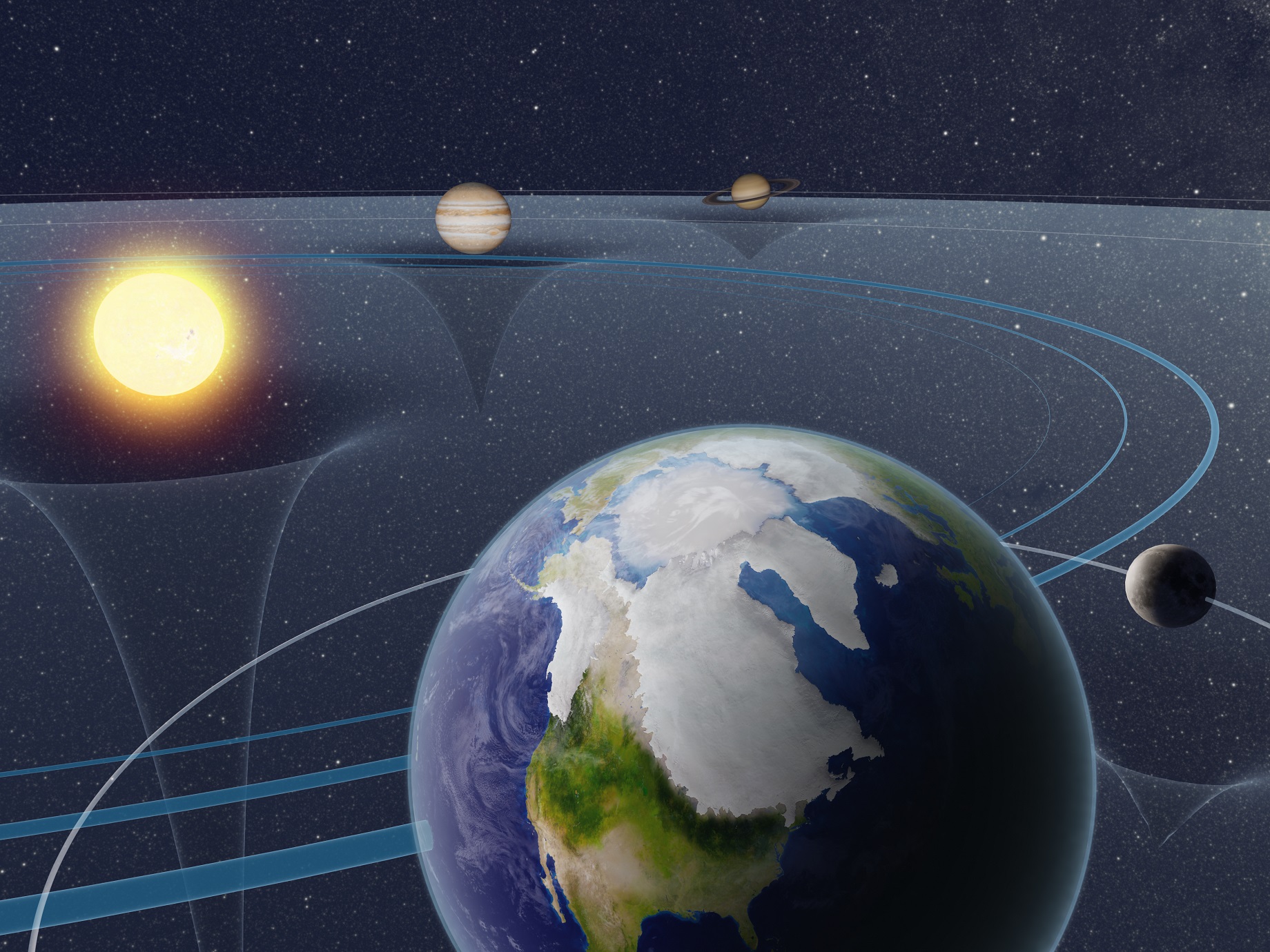
Murujuga’s rock art is being destroyed – where is the outrage?
Benjamin Smith, The University of Western Australia; Joakim Goldhahn, The University of Western Australia, and Paul S.C.Taçon, Griffith UniversityThree rock art panels were this month removed from Murujuga/Burrup in Western Australia to make way for a new A$6.4 billion fertiliser factory.
Moving Indigenous rock art anywhere in the world is controversial. In this case, a journalist photographing the removal was stopped by police. Later, her home was raided and her camera’s memory card temporarily seized.
The removal of rock art goes against international best practice in heritage conservation. Specifically, it breaches the globally accepted Burra Charter, which states that an object should “remain in its historical location” because this forms an important part of its cultural significance.
Despite the travesty unfolding at Murujuga/Burrup, non-Indigenous archaeologists have largely been silent about the destruction. As three rock art specialists with a combined professional experience of 100 years, we consider it our professional and moral obligation to speak out.
Rock Art Removal In Murujuga
Murujuga/Burrup is 1,500 kilometres north of Perth. It contains more than a million rock art petroglyphs, making it the one of the world’s largest concentration of petroglyphs. The region’s art-making tradition may extend back more than 40,000 years.
The art of Murujuga includes extinct animals and some of the earliest known images of the human face. The site has also been nominated as the next Australian UNESCO World Heritage Site.
The three rock art panels were removed this month. The panels will be relocated to another Burrup location, under the guidance of the Murujuga Aboriginal Corporation.
Murujuga/Burrup is also home to several large gas and ammonia plants. Posing with a spade at the fertiliser factory site last month, WA Premier Mark McGowan said the project confirmed the Pilbara region’s role as the “engine room of Australia’s economy”.
The destruction has profoundly affected Traditional Owners. Raelene Cooper, Mardudhunera woman and the former chair of the Murujuga Aboriginal Corporation, this month said McGowan:
stands there quite proudly with a shovel to dig into the ngurra, the ground, giving the green light to go ahead and destroy the very rock art that holds the World Heritage values of our Country.
And following the rock art’s removal, Kuruma Marduthunera traditional custodian Josie Alec said:
I don’t know what to say. I am so angry and hurt right now. It is a sad, sad state of affairs. The free, prior and informed consent has still not been given to Perdaman to remove these rocks – not all traditional custodians have been consulted on this.
What Destroying Sacred Sites Does
Clearly, the choice to build over sacred sites causes long-term cultural pain and trauma to Aboriginal communities. So why not find an alternative location?
Murujuga/Burrup is not the only place in WA suitable for a fertiliser factory. What’s more, acidic industrial emissions from facilities around the Burrup Peninsula are damaging the area’s rock art more generally. Emissions from the gas-powered fertiliser factory will exacerbate this – as well as leading to greater greenhouse gas emissions.
The damage to Indigenous heritage at Murujuga/Burrup has gained attention in recent years, and the problem was the subject of a 2016 Senate inquiry.
The destruction has also led to rising tensions, including street protests and road blocks, as Aboriginal community members struggle to make their voices heard.
These are not the first such protests. In the 1980s, the community and archaeologists protested against the Karratha Gas plant, a development that involved removing ancient Murujuga rock art panels. Many were damaged in the process.
In the 2000s, the proposed expansion of this plant, and plans to build a massive new liquefied natural gas facility, were met with even stronger protests. Archaeologists from across the world vocally opposed the plans.
It’s Time For Archaeologists To Speak Out
Today, Aboriginal voices against cultural heritage damage at Murujuga/Burrup are louder than ever.
But archaeologists have largely remained silent about the destruction.
Expert voices are crucial when it comes to standing up to government and corporate power. Take, for example, the almost 100 scientists who this month demanded the Northern Territory government abandon fracking in the Beetaloo Basin.
We urge archaeologists around the world to follow this example. They should demand a stop to all industrial development at Murujuga, and the immediate return of the three rock art panels.
In Australia, the cultural violence of rock art removal is being recognised in some quarters. For example, three Tasmanian museums and galleries recently returned rock art panels to locations from which they were removed in the 1960s.
Damage to rock art is not just an affront to Aboriginal people. It diminishes us all. As the global advocacy group the Rock Art Network says:
This fragile and irreplaceable visual heritage has worldwide significance, contemporary relevance and for many indigenous peoples is still part of their living culture. If we neglect, destroy or disrespect rock art we devalue our future.
Benjamin Smith, Professor of Archaeology (World Rock Art), School of Social Sciences, The University of Western Australia; Joakim Goldhahn, Rock Art Australia Ian Potter Kimberley Chair, The University of Western Australia, and Paul S.C.Taçon, Chair in Rock Art Research and Director of the Place, Evolution and Rock Art Heritage Unit (PERAHU), Griffith University
This article is republished from The Conversation under a Creative Commons license. Read the original article.
Butterfly Tree Of Life Reveals Origin
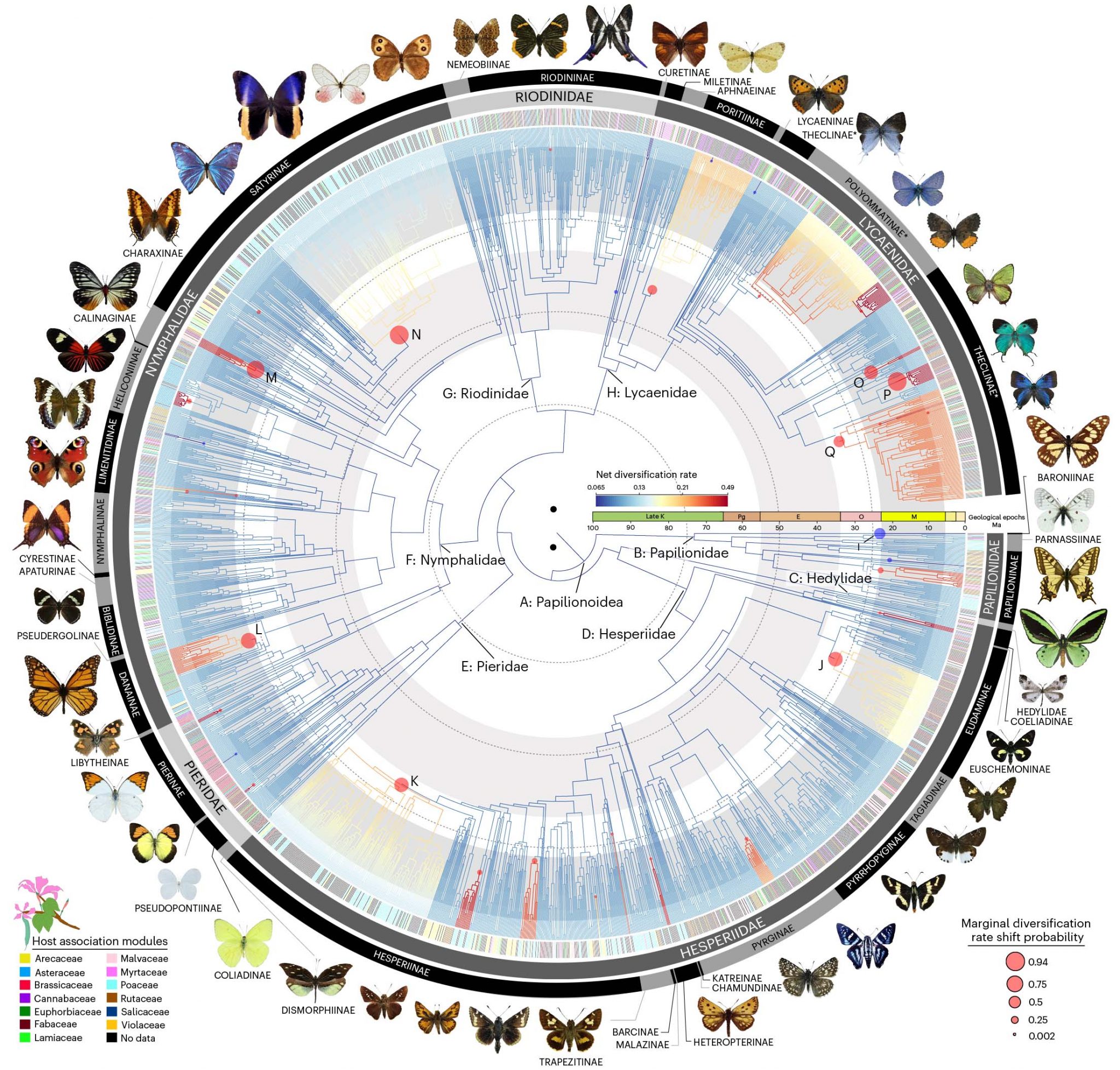
Disclaimer: These articles are not intended to provide medical advice, diagnosis or treatment. Views expressed here do not necessarily reflect those of Pittwater Online News or its staff.